


Carta Editorial Editor’s Letter
La flor, además de ser considerada la parte más hermosa de la planta, es el elemento que indica que las especies vegetales angiospermas ya están listas para ser visitadas por los polinizadores y, con esto, comienzan su maravilloso proceso de reproducción. Así mismo, para numerosas culturas, estas estructuras vegetales representan el duelo, la amistad, el amor, y también se entregan con gran emoción al momento de que celebramos un logro, como lo es esta emotiva trigésima edición, por lo que hemos dedicado esté número al Paisaje Floral.
Hablaremos sobre proyectos paisajísticos que se inspiraron en las flores para diseñar espacios de exposición, recreación y de contemplación. También hablaremos de las flores que simbolizan las comunidades y las naciones; cómo crear jardines polinizadores y su importancia; las especies vegetales que atraen polinizadores y los múltiples beneficios de plantar especies nativas. Muchas gracias a todas las personas que forman parte de nuestra comunidad, al excelente equipo Landuum Paisaje y a todas nuestras familias, en especial a nuestros hijos y nietos que nos inspiran para seguir adelante y difundir artículos que generen conciencia sobre la importancia de conservar, cuidar y proteger nuestros hábitats, así como crear nuevos jardines.
¡Disfrutemos de las flores que nos acompañan en nuestro caminar!
The flower, besides being considered the most beautiful part of the plant, is the element that indicates that angiosperm plant species are ready to be visited by pollinators and, with this, they begin their wonderful process of reproduction. Likewise, for numerous cultures, these plant structures represent mourning, friendship, love, and they are also given with great emotion when we celebrate an achievement, as is this emotional thirtieth edition, which is why we have dedicated this number to the Floral Landscape.
We will talk about landscaping projects that were inspired by flowers to design spaces for exhibition, recreation, and contemplation. We will also discuss the flowers that symbolize communities and nations; how to create pollinator gardens and their importance; the plant species that attract pollinators, and the multiple benefits of planting native species.
Thank you very much to all the people who are part of our community, to the excellent Landuum Landscape team, and to all our families, especially to our children and grandchildren who inspire us to continue forward and disseminate articles that raise awareness about the importance of conserving, caring for, and protecting our habitats, as well as creating new gardens.
Let's enjoy the flowers that accompany us on our journey!

3 EDITORIAL Director / Editor in chief: Valentina Lara Can
Portada Fotografía / Photography Javier Tello Arellano
Campos de girasoles / Sunflower fields
Fotografía Photography Valentina Lara
DIRECTORIO
Director / Editor in chief
VALENTINA LARA CAN
Consejo Honorífico / Honorary Council
PEDRO CAMARENA BERRUECOS
JAVIER MUÑOZ MENÉNDEZ
MARIO A. PENICHE LÓPEZ
Socios fundadores / Founding partners
JORGE FERNANDEZ / VALENTINA LARA
LUISI LEYVA / KARLA NAVARRETE
MARIANELA PORRAZ / BETTINA VARGAS
Coordinador de Arte / Art Coordinator
PAOLA CASTRO / paolalanis@landuum.com
Coordinador Editorial / Editorial Coordinator
ANDREA CONDE / edicion@landuum.com
Redes Sociales / Social Media
ANDREA VALENCIA / andreav@landuum.com
Colaboradores / Contributors
ALEJANDRA ROLÁN
AMARANTA ARELLANO
ANGELA LAWS
ARMANDO MARAVILLA
ESAÚL HERNÁNDEZ
FABIOLA CARDEÑA
FELIPE ARATH MACÍAS
IVÁN JUÁREZ
IVONNE WALLS
JUAN JOSÉ ANCONA
JUAN P. PINZÓN
LUIS JORGE MONTALVO
LUISI LEYVA
MARIANELA ROCHAS-PORRAZ
PAMELA LÓPEZ
PARAISO COLIBRÍ
PATRICIA ELÍAS CALLES
STEPHANIE LAGUNAS
Edificio Black, 5to. Piso, No. 500 entre calle 40 y 42, Sodzil Nte, Periférico. Cp. 97115 Mérida, Yucatán., Mx. TEL: +52 (999) 406 32 68
Landuum No. 30
LANDUUM, Año 8, No. 30, marzo 2024 junio 2024, es una publicación trimestral editada por Paisaje Ediciones S.A. de C.V., Edificio Black, 5to. Piso No. 500 Col. Sodzil Norte, Mérida, Yuc. Mx., C.P. 97115, Tel. (999) 40632-68, www.landuum.com, edicion@landuum.com. Editor responsable: Valentina Lara Can. Reservas de Derechos al Uso Exclusivo No. 04-2016091212020100-102, otorgado por el Instituto Nacional de Derecho de Autor, Licitud de Título y Contenido No. 16907, otorgado por la Comisión Calificadora de Publicaciones y Revistas Ilustradas de la Secretaría de Gobernación, Marca LANDUUM registro de marca No. 1641567. Este número fue publicado en marzo de 2024. Impresa por SmartPress Vision, SA de CV Caravaggio 30 Col. Mixcoac. Ciudad de México 03910. Distribuido por: COMERCIALIZADORA GBN S.A. DE C.V. Todas las imágenes, nombres, marcas y logotipos aquí representados son Copyright de sus respectivos autores. Ninguna parte de esta publicación, incluido el diseño de la cubierta, puede reproducirse, almacenarse o transmitirse de ninguna forma, ni por ningún medio digital, electrónico, químico, mecánico, óptico, de grabación o por fotocopia, sin previa autorización por parte de Paisaje Ediciones S.A de C.V. Todos los contenidos de publicidad y artículos, son responsabilidad exclusiva de los anunciantes y los colaboradores, no reflejan necesariamente la opinión o punto de vista de LANDUUM. La información contenida en los artículos puede variar por razones ajenas a nosotros, por lo que LANDUUM no se hace responsable. Apreciamos las sugerencias, comentarios y observaciones para mejorar nuestra edición.
LANDUUM, Year 8, No. 30, March 2024 June 2024, is a quarterly publication edited by Paisaje Ediciones S.A. de C.V., Edificio Black, 5th floor No. 500 Col. Sodzil Norte, Merida, Yuc. Mx. Zip code. 97115. Phone (999) 406-32-68, www. landuum.com, edicion@landuum.com. Responsible editor: Valentina Lara Can. Reservations of Rights to Exclusive Use No. 04-2016-091212020100-102, by Instituto Nacional de Derecho de Autor. Licitude of Title and Content No. 16907, given by Comisión Calificadora de Publicaciones y Revistas Ilustradas de la Secretaría de Gobernación, LANDUUM registration No. 1641567. This
Colaboradores / Contributors
ALIVE ARCHITECTURE
Agencia de diseño socio-espacial con sede en Bruselas, que permite a los actores locales apropiarse de la ciudad. Por medio de un enfoque empático y colaborativo, su objetivo es hacer que el espacio público sea más habitable.
Brussels-based socio-spatial design agency that enables local actors to appropriate the city. Through an empathetic and collaborative approach, they aim to make public space more livable.
CASANOVA + HERNANDEZ
ARCHITECTS
LELEU
PAISAJE
Se fundó en 2001 en Rotterdam, Países Bajos. Los dos socios principales, Helena Casanova (1967) y Jesús Hernández (1967), son arquitectos, urbanistas y paisajistas.
Founded in 2001 in Rotterdam, the Netherlands. Both leading partners, Helena Casanova (1967) and Jesus Hernandez (1967), are architects, urban planners and landscape architects.
Estudio de paisajismo ubicado en Baja California Sur, fundado por la arquitecta paisajista Celine Leleu, egresada de la UNAM; destaca en proyectos urbanos y arquitectónicos. Especializado en intervenciones que se integran armoniosamente con el entorno, resaltando una apreciación única por la botánica.
Landscape architecture studio based in Baja California Sur, founded by the landscape architect Celine Leleu, a graduate of UNAM; excels in urban and architectural projects. Specializing in interventions that harmoniously integrate with the surroundings, highlighting a unique appreciation for botany.
Cofundadora del Atelier LOOSvanVLIET y urbanista y arquitecta paisajista. Trabaja en diseños duraderos con soluciones innovadoras.
Co-founder of Atelier LOOSvanVLIET and an urban planner and landscape architect. She works on durable designs with innovative solutions.
STROOTMAN
LANDSCHAPS
ARCHITECTEN
Con sede en Ámsterdam, Países Bajos, Strootman Landschapsarchitecten es una oficina galardonada de arquitectura paisajista y diseño urbano. Sus diseños surgen del deseo de hacer una contribución fundamental a un mundo hermoso, interesante y sostenible. Despliegan sus habilidades de diseño para paisajes y ciudades inusuales e innovadores que hacen feliz a la gente y estimulan un estilo de vida más saludable. El trabajo de Strootman integra urbanismo, historia cultural, ecología, arte y arquitectura dentro de un marco arquitectónico paisajístico. La oficina combina pensamiento con artesanía material y se esfuerza por lograr una cierta calidad terrenal, calidez y alegría.
Based in Amsterdam, the Netherlands, Strootman Landschapsarchitecten is an award-winning office for landscape architecture and urban design. Their designs spring from the desire to make a fundamental contribution to a beautiful, interesting and sustainable world. They deploy their design skills for unusual, innovative landscapes and cities that make people happy and stimulate a healthier lifestyle. The work of Strootman integrates urbanism, cultural history, ecology, art and architecture within a landscape architectural framework. The office combines thought with material craftsmanship, and strives for a certain earthy quality, warmth and playfulness.
En la intersección del paisaje, la infraestructura y los espacios públicos, Taktyk se involucra en la creación de ciudades a través de la práctica, la investigación, la enseñanza, la promoción y la curaduría.
At the intersection of landscape, infrastructure and public spaces, Taktyk engages in city making through practice, research, teaching, advocacy and curating.
Fe de erratas de la edición 29 titulada “Paisajismo y Acceso Universal”
Se hace constar que en la edición titulada “Paisajismo y Acceso Universal”, publicada en enero de 2024, contiene un error de crédito que requiere corrección. En la página 80, en el pie de la fotografía donde dice “Área de juegos inclusiva Marcotrade”, debe leerse “Área de juegos inclusiva Murban”. Lamentamos los inconvenientes que estos errores hayan podido ocasionar y agradecemos su comprensión. Atentamente: Equipo Landuum Paisaje.
Errata of the 29th edition titled “Landscaping and Universal Access ”
We hereby acknowledge that the edition titled “Landscaping and Universal Access”, published in January 2024, contains a credit error that requires correction. On page 80, in the caption of the photograph where it says “Marcotrade inclusive playground area”, it should be “Murban inclusive playground area”. We apologize for any inconvenience these errors may have caused and appreciate your understanding. Sincerely: Landuum Landscape Team.
4 INTERVENCIONES Avalado por / Endorsed by: ¡Suscríbete! / Subscribe: suscripciones@landuum.com
MARTINE VAN VLIET
TAKTYK
30 Col. Mixcoac.
México
COMERCIALIZADORA GBN S.A. DE C.V. All images, names, trademarks and logos represented here are Copyright of their respective authors. No part of this publication, including cover design, can be reproduced, stored or transmitted in any form or by any digital, electronic, chemical, mechanical, optical, recording or photocopy means, without prior authorization of Paisaje Ediciones S.A. de C.V. All advertising content and articles are the responsibility of advertisers and contributors; they do not necessarily reflect the opinion or LANDUUM point of view. The information contained in articles may vary for reasons beyond our control, so LANDUUM is not responsible. We appreciate suggestions, comments and observations to improve our edition.
issue was published on March 2024. Printed by SmartPress Vision, SA de CV Caravaggio
Ciudad de
03910. Distributed by

Ivonne Walls nos habla sobre cómo la diversidad de flores son cruciales para la salud de las personas y del planeta, en el artículo El paisaje floral: entre pétalos y significados Ivonne Walls speaks to us about how diversity of flowers is crucial for the health of people and the planet, in the article The Floral Landscape: Between petals and meanings
Aprende con Paraíso Colibrí sobre Jardines polinizadores: Colibrí como agente polinizador. Learn with Paraíso Colibrí about Pollinator gardens: Hummingbird as a pollinating agent.
Reconoce Las flores del huerto familiar maya con Juan P. Pinzón y Juan José Ancona Aragón.
Recognize the Flowers of the Mayan homegarden with Juan P. Pinzón y Juan José Ancona Aragón.
Pamela López nos habla sobre la Dahlia coccinea, caprichosa joya de la nación una flor que forma parte del patrimonio natural y cultural mexicano, descrita por Nezahualcóyotl como una “joya especial”. Pamela López tells us about the Dahlia coccinea , capricious jewel of the nation , a flower that is part of the Mexican natural and cultural heritage, described by Nezahualcóyotl as a “special jewel”.
Marianela Rochas-Porraz nos presenta El jardín floral: del espacio de placer al reservorio biodiverso en donde nos invita a conocer los jardines del palacio Villandry.
Marianela Rochas-Porraz presents us The floral garden: from pleasure space to biodiversity reservoir, where she invites us to know the gardens of Villandry palace.
Recorre junto con Iván Juárez un Jardín aromático y espacio polinizador en Italia, que surge de la recuperación de un patio-terraza en desuso. Traverses with Iván Juárez an Aromatic garden and pollinator space in Italy that arises from the recovery of an unused patio-terrace.
Descubre el jardín que rinde tributo a la vida de Billie Holiday en “Un homenaje a Lady Day: Un jardín musical”, por Strootman Landschapsarchitecten. Discover the garden that pays tribute to the life of Billie Holiday in “Un hommage à Lady Day: A Musical Garden”, by Strootman Landschapsarchitecten.
Alive Architecture + Taktyk nos presentan “La grieta” un proyecto situado en Bélgica que intenta reactivar una comunidad por medio de un complejo de canchas de tenis. Alive Architecture + Taktyk present to us “The Crack”, a project located in Belgium that seeks to reactivate a community through a tennis court complex.
Conoce el Museo de la Cerámica y el Parque del Mosaico de la mano de Casanova + Hernández Arquitectos, un proyecto que invita a los visitantes a disfrutar de una experiencia multisensorial fusionando arquitectura y paisaje.
Get to know the Ceramic Museum and Mosaic Park with Casanova + Hernández Architects, a project that invites visitors to enjoy a multi sensorial experience by blending architecture and landscape.
En el artículo “Flores que hablan: Los Agaves de Acre Resort”, Leleu paisaje nos platica sobre el desarrollo de una nueva área de eventos en el Hotel Acre Resort, donde se destaca el uso de flores en una zona árida.
In the article “Flowers that Speak: Los Agaves at Acre Resort”, Leleu Paisaje speaks to us about the development of a new event area at Acre Resort, highlighting the use of flowers in an arid zone.
Recorre el Parque Lineal con Atelier Loos van Vliet, un parque en Holanda inspirado en una ramificación del río Eem con flores que cambian según la temporada.
Move across the Linear Park with Atelier Loos van Vliet, a park in Holland inspired by a branch of the river Eem with flowers that change with the season.
The Flowner / Angie Espadas nos revela ¿Cómo hacer un bouquet de flores?
The Flowner / Angie Espadas reveals to us How to make a flower bouquet?
Armando Maravilla y Arath Macías nos presentan “Plantas que cambian el paisaje con su floración”.
Armando Maravilla and Arath Macías present to us “Plants that change the landscape with their blossoming”.
Reconoce con Amaranta Arellano y Alejandra Roldán los tipos de polinizadores y las flores que los atraen, en Plantas con flor para atraer polinizadores: Síndromes de Polinización.
Recognize with Amaranta Arellano and Alejandra Roldán the types of pollinators and the flowers that attract them, in Flowering plants to attract pollinators: Pollination Syndromes.
Explora junto con Armando Maravilla y Esaúl Hernández los Jardines botánicos de la Columbia Británica.
Explore the Botanic gardens of British Columbia with Armando Maravilla and Esaúl Hernández.
Conoce a los Polinizadores, los héroes sin capa de la naturaleza con Fabiola Cardeña.
Meet the Pollinators, nature's capeless heroes with Fabiola Cardeña.
En la entrevista a Angela Laws / The Xerces society, nos habla sobre la importancia de la creación de un hábitat para los polinizadores.
In the interview with Angela Laws / The Xerces society, she talks to us about the importance of creating a habitat for pollinators.
Patricia Elías Calles nos invita a conocer sobre el FYJA Festival de Flores y Jardines, el cual promueve el diseño de paisaje y la jardinería consciente en México.
Patricia Elías Calles invites us to learn about the FYJA Flower and Garden Festival which promotes landscape design and gardening in Mexico.
En nuestra sección de tendencia, aprende sobre la importancia del arte efímero urbano en “Paseos de las flores, una fusión de cultura y naturaleza” con Luis Jorge Montalvo y Andrea Conde Correa. In our trend section, learn about the importance of the ephemeral urban art in “Flower paths, a fusion of culture and nature” with Luis Jorge Montalvo y Andrea Conde Correa.
7 6 CONTENIDO CONTENT 34 38 42 08 24 14 20 28 48
60 54 64 68 48 82 86 92 98 78 74 CONTENT
/ Photography: Ben McMillan 56
Fotografía
El paisaje floral: entre pétalos y significados The floral landscape: between petals and meanings
Por / By : Ivonne Walls
El mundo natural nos regala una rica paleta de colores y formas, y entre sus obras maestras se encuentra el paisaje floral. Este espectáculo de la naturaleza no solo deleita nuestros sentidos, sino que también encierra significados profundos y conexiones simbólicas con la historia y la cultura. Es un mágico mundo lleno de diversidad, importancia e impacto en nuestras vidas que podemos considerar como “un paisaje dentro de otro paisaje”.
The natural world gives us a rich palette of colors and shapes, and among its masterpieces is the floral landscape. This spectacle of nature not only delights our senses, but also holds deep meanings and symbolic connections to history and culture. It is a magical world full of diversity, importance and impact on our lives that we can consider as “a landscape within a landscape”.

Jardines en Versalles
Versailles Gardens
Fotografía / Photography: Joseolgon, CC BY-SA 4.0, via Wikimedia Commons .jpeg

Las flores como parte del diseño paisajístico son elementos que pueden dar orden, equilibrio y sentido a una tradicional vista dominada por los verdes cuando se trata de jardines y bosques, por los blancos en el caso de los paisajes nevados y por los ocres en las zonas desérticas.
Desde los vastos campos de tulipanes en los Países Bajos hasta los exuberantes campos de lavanda en la Provenza francesa, el paisaje floral abarca una sorprendente diversidad de flores y plantas que se vuelven representativas y personajes principales de cada país. Cada región del mundo tiene su propio tesoro floral, adaptado a su clima y suelo específicos. Las vibrantes orquídeas en las selvas tropicales, los extensos campos de girasoles bajo el sol de la Toscana en Italia, los campos de alcatraces en México y las delicadas flores de cerezo en Japón son solo algunas de las maravillas que componen este vasto lienzo natural. En los jardines de los palacios barrocos de Francia, Inglaterra y otros países europeos, su función, aunque es más de tipo decorativa, permite fortalecer el diseño geométrico de los arriates y jardineras, acentuando y enmarcando la arquitectura de las construcciones, lo que añade un atractivo único a la experiencia espacial.
Flowers as part of landscape design are elements that can give order, balance and meaning to a traditional view dominated by greens in the case of gardens and forests, by whites in the case of snowy landscapes and by ochres in desert areas.
From the vast fields of tulips in the Netherlands to the lush fields of lavender in French Provence, the floral landscape encompasses a surprising diversity of flowers and plants that become representative and main characters of each country. Each region of the world has its own floral treasure, adapted to its specific climate and soil. The vibrant orchids in the rainforests, the sprawling sunflower fields under the Tuscan sun in Italy, the fields of gannets in Mexico, and the delicate cherry blossoms in Japan are just a few of the wonders that make up this vast natural canvas.
In the gardens of Baroque palaces in France, England and other European countries, its function, although more decorative, allows to strengthen the geometric design of the flowerbeds and planters, accentuating and framing the architecture of the buildings, which adds a unique appeal to the spatial experience.
CULTURE & HISTORY 9 CULTURA E HISTORIA
Un mágico
/ A magical discovery
The floral landscape: between petals and meanings
descubrimiento
Fotografía
Photography: Mariana Zoé Huerta Parra
La biodiversidad de los paisajes florales no solo es estéticamente impresionante, sino que también desempeña un papel crucial en el equilibrio ecológico. Las flores atraen a abejas y mariposas, contribuyendo al proceso de polinización y promoviendo la salud de los ecosistemas. Además, muchas especies animales dependen de las flores como fuente de alimento, lo que destaca la interconexión vital entre la flora y la fauna en estos paisajes. Pero no solo eso, a lo largo de la historia, las flores han desempeñado un papel destacado en diversas culturas, siendo símbolos de amor, esperanza, duelo o incluso rebelión. Cada flor lleva consigo una carga simbólica única, que transmite mensajes sutiles y emociones profundas. Por ejemplo, en la tradición japonesa, la flor de cerezo simboliza la transitoriedad de la vida, mientras que, en la cultura occidental, las rosas rojas son un emblema de amor apasionado, y en México la flor de cempasúchil representa la luz que guía a las almas de los difuntos de regreso a la tierra durante el Día de Muertos.
The biodiversity of floral landscapes is not only aesthetically stunning, but also plays a crucial role in the ecological balance. The flowers attract bees and butterflies, contributing to the pollination process and promoting the health of ecosystems. In addition, many animal species rely on flowers as a food source, highlighting the vital interconnection between flora and fauna in these landscapes. But not only that, throughout history, flowers have played a prominent role in various cultures, being symbols of love, hope, mourning or even rebellion. Each flower carries with it a unique symbolic charge, conveying subtle messages and deep emotions. For example, in Japanese tradition, the cherry blossom symbolizes the transience of life, while, in Western culture, red roses are an emblem of passionate love, and in Mexico the marigold flower (cempasúchil in náhuatl) represents the light that guides the souls of the deceased back to earth during the Day of the Dead.


Esto refleja como las flores poseen además un significado cultural, esencial para la identidad de cada lugar en el mundo.
En las diferentes artes, como la pintura, la literatura y la poesía, el paisaje floral también ha servido como fuente inagotable de inspiración. Artistas como Claude Monet han inmortalizado los jardines florecientes en sus lienzos, capturando la efímera belleza de la naturaleza, los poetas han tejido versos que celebran la delicadeza de las flores convirtiéndolas en metáforas poderosas que expresan una amplia gama de emociones humanas, y los escultores las han labrado en piedra haciéndolas inmortales y eternas.
En cuanto al impacto en la psicología humana, la conexión entre el paisaje floral y el bienestar humano ha sido objeto de estudios que demuestran que la presencia de flores en entornos naturales, urbanos y domésticos tiene efectos positivos en el estado de ánimo y la salud mental. La visión de colores brillantes y formas naturales puede reducir el estrés, aumentar la creatividad y mejorar la concentración.
This reflects how flowers also have a cultural significance, essential to the identity of each place in the world.
In the different arts, such as painting, literature, and poetry, the floral landscape has also served as an inexhaustible source of inspiration. Artists such as Claude Monet have immortalized blooming gardens on their canvases, capturing the ephemeral beauty of nature, poets have woven verses that celebrate the delicacy of flowers by turning them into powerful metaphors that express a wide range of human emotions, and sculptors have carved them in stone making them immortal and eternal. In terms of the impact on human psychology, the connection between floral landscape and human well-being has been the subject of studies showing that the presence of flowers in natural, urban, and domestic settings has positive effects on mood and mental health. Seeing bright colors and natural shapes can reduce stress, increase creativity, and improve concentration.
CULTURE & HISTORY 11 CULTURA E HISTORIA 10
El paisaje floral: entre pétalos y significados The floral landscape: between petals and meanings
Cosecha de la flor de los muertos
Harvest of the dead Fotografía / Photography: Victor Hugo Galarza Sánchez
Claude Monet, Water Lilies Fotografía / Photography CC BY 2.0, via Wikimedia Commons
Además, está demostrado que plantar, podar o simplemente contemplar las flores, genera una forma de conexión con la naturaleza que tiene un impacto calmante y restaurador en el ser humano. Es importante recalcar que la práctica milenaria de la jardinería ha sido reconocida por sus beneficios terapéuticos y por sus efectos medicinales, pues los diferentes elementos de las flores poseen sustancias que tienen propiedades curativas que, desde hace siglos, han permitido a las personas utilizarlas para mejorar la salud y curar enfermedades. Por último, a pesar de la abundancia de paisajes florales, éstos enfrentan una serie de desafíos en la era moderna. El cambio climático, la deforestación y la contaminación amenazan la biodiversidad y la salud de los ecosistemas, lo que deriva en la pérdida de hábitats naturales, lo que pone en riesgo a numerosas especies de flores y plantas, algunas de las cuales podrían desaparecer antes de que siquiera hayamos tenido la oportunidad de apreciarlas plenamente.
In addition, it has been proven that planting, pruning or simply contemplating the flowers, generates a form of connection with nature that has a calming and restorative impact on human beings. It is important to emphasize that the ancient practice of gardening has been recognized for its therapeutic benefits and medicinal effects, since the different elements of flowers have substances that have healing properties which, for centuries, have allowed people to use them to improve health and cure diseases.
Finally, despite the abundance of floral landscapes, they face several challenges in the modern era. Climate change, deforestation and pollution threaten biodiversity and the health of ecosystems leading to the loss of natural habitats, putting numerous species of flowers and plants at risk, some of which could disappear before we have even had a chance to fully appreciate them.
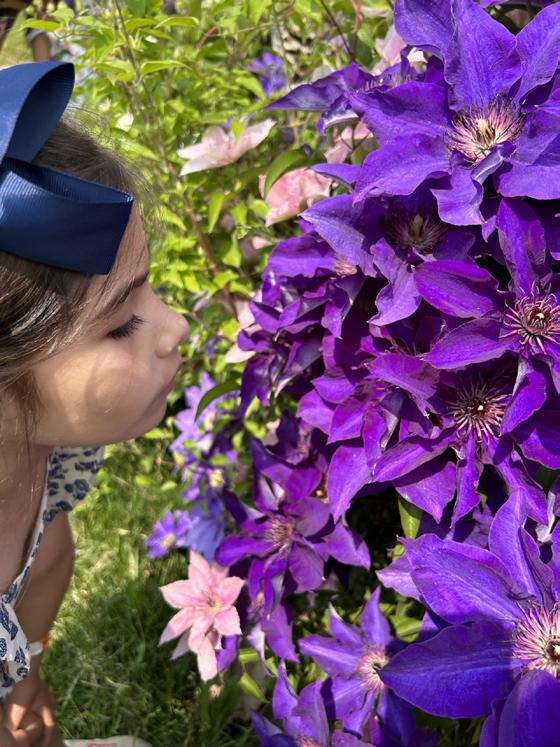
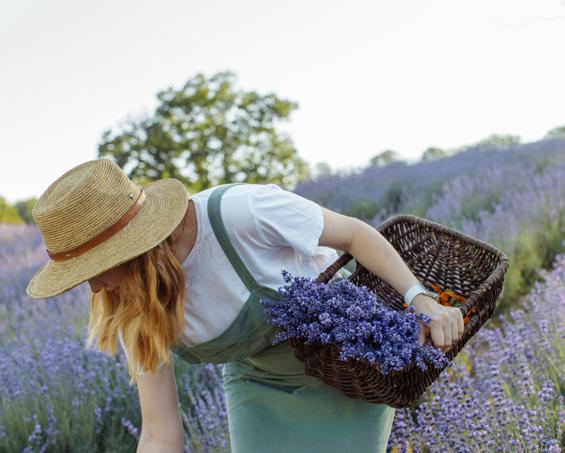
En conclusión, el paisaje floral no es solo una exhibición impresionante de la naturaleza, sino también un tesoro cultural, simbólico y terapéutico. La diversidad de flores y plantas en todo el mundo no solo enriquece nuestras vidas visual y estéticamente, sino que también desempeña un papel crucial en el mantenimiento de la salud de las personas y del planeta que habitan.
Al preservar y apreciar estos tesoros naturales, no sólo honramos la rica historia cultural de los pueblos, sino que aseguramos que las generaciones futuras puedan disfrutar de la maravilla eterna de vivir y experimentar un paisaje floral.
La conservación de estos paisajes no solo es esencial para preservar la belleza natural del mundo, sino también para mantener el equilibrio ecológico y proteger la diversidad biológica. Iniciativas globales y locales están trabajando arduamente para abordar estos desafíos, promoviendo la sostenibilidad y concientizando sobre la importancia de cuidar nuestro entorno natural.
In conclusion, the floral landscape is not only a breathtaking display of nature, but also a cultural, symbolic, and therapeutic treasure. The diversity of flowers and plants around the world not only enriches our lives visually and aesthetically, but also plays a crucial role in maintaining the health of people and the planet they inhabit.
By preserving and appreciating these natural treasures, we not only honor the rich cultural history of the countries, but ensure that future generations can enjoy the timeless wonder of living and experiencing a floral landscape.The conservation of these landscapes is not only essential to preserve the natural beauty of the world, but also to maintain ecological balance and protect biological diversity. Global and local initiatives are working hard to address these challenges, promoting sustainability, and raising awareness about the importance of caring for our natural environment.
“El paisaje floral no es solo una exhibición impresionante de la naturaleza, sino también un tesoro cultural, simbólico y terapéutico.”

“The floral landscape is not only a breathtaking display of nature, but also a cultural, symbolic, and therapeutic treasure.”
CULTURE & HISTORY 13 CULTURA E HISTORIA 12
El paisaje floral: entre pétalos y significados The floral landscape: between petals and meanings
Árbol de cerezo japonés Japanese cherry blossom tree Fotografía / Photography: pexels-bagus-pangestu-1440476
Oliendo flores Smelling flowers Fotografía / Photography: Valentina Lara
Recogiendo lavanda Lavender picking Fotografía / Photography: pexels-anastasia-shuraeva-5126962
Jardines polinizadores: Colibrí como agente polinizador
Pollinator gardens:
Hummingbird as a pollinating agent
Por / By : Paraíso Colibrí
Los jardines para polinizadores son refugios de vida silvestre. Estos organismos transportan polen de una flor a otra al alimentarse del néctar o polen, permitiendo la reproducción de las plantas.
The pollinator gardens are wildlife shelters. These organisms transport pollen from one flower to another while feeding on nectar or pollen, enabling the reproduction of plants.

Hoy sabemos que alrededor de 150 especies cultivadas de uso comestible en México dependen de los polinizadores (Ashworth, et al., 2009, 1052), incluyendo el frijol, los chiles, manzanas, calabazas, papaya, etc. Sin embargo, también son vitales para muchas especies de plantas que incluyen especies ornamentales, especies que alimentan al ganado o especies que producen fibras tales como el algodón. Actualmente, entre este grupo de organismos encontramos a las abejas, mariposas, colibríes y murciélagos, todos se encuentran en crisis. Desde hace más de dos décadas se ha registrado un declive en sus poblaciones por la pérdida de hábitat, el uso de plaguicidas y el cambio climático.
Un tema innegable es el poder observarles al interior de nuestras ciudades, e inclusive en nuestras áreas verdes urbanas, en donde cada vez es más difícil encontrar especies alimentándose o prosperando, debido a la falta de alimento y refugio. Desde el punto de vista del diseño de paisaje, crear un jardín para polinizadores permite transmitir diversos mensajes: convencer a los usuarios de que es posible coexistir armónicamente con otras especies en el mismo espacio, enseñar sobre los ciclos de vida y alejarnos de los mitos que, durante años, han perseguido a diferentes especies. Además, invita a la experimentación sensorial visual, sonora y olfativa al utilizar especies diferentes a las habituales en nuestros jardines, que por su floración producen otros colores, aromas y, gracias a los sonidos de los visitantes, conjugan en una experiencia y percepción distinta del mismo paisaje al que denominamos jardín silvestre. Nos gusta imaginar en lo que se convertirían nuestras ciudades si todos creáramos jardines donde se promueva la biodiversidad. En un jardín de pocos metros cuadrados se pueden registrar más de 100 especies de insectos, aves u otros organismos. Finalmente, podríamos crear corredores verdes funcionales, partiendo desde parques, azoteas y áreas públicas, hasta las áreas rurales y naturales.
Today, we know that around 150 cultivate species used in Mexico depend on pollinators (Ashworth, et al., 2009, 1052), including beans, peppers, apples, pumpkins, papaya, etc. However, they are also vital for many species of plants, including ornamental species, species that feed livestock, or species that produce fibers such as cotton.
Currently, among this group of organisms, we find bees, butterflies, hummingbirds, and bats, all of which are in crisis. For over two decades, there has been a decline in their populations due to habitat loss, pesticide use, and climate change.
An undeniable aspect is the ability to observe them within our cities, and even in our urban green areas, where it is increasingly difficult to find species feeding or thriving due to the lack of food and shelter. From a landscape design perspective, creating a garden for pollinators allows us to convey various messages: convince users that it is possible to coexist harmoniously with other species in the same space, teach us about life cycles, and move away from the myths that have pursued different species for years. Additionally, it invites visual, auditory, and olfactory sensory experimentation by using different species from those usually found in our gardens, which, due to their flowering, produce different colors and aromas. Thanks to the sounds of visitors, they combine into a different experience and perception of the same landscape, which we call a wild garden. We like to imagine what our cities would become if everyone created gardens that promote biodiversity. In a garden of just a few square meters, more than 100 species of insects, birds, or other organisms can be registered. Ultimately, we could create functional green corridors, starting from parks, rooftops, and public areas, extending to rural and natural areas.
CULTURE & HISTORY 15 CULTURA E HISTORIA
Pollinator gardens
Colibrí posando en Opuntia spp.
Hummingbird posing in Opuntia spp.
Fotografía / Photography: José Gabriel Téllez
Cuando creamos jardines para polinizadores buscamos crear áreas verdes que estén llenas de plantas nativas con flores. Algunas de las características que debemos perseguir para crear estos oasis son: Cultivar plantaciones diversas, utilizando especies con diferentes formas, colores y tamaños en sus flores para atraer la mayor diversidad de polinizadores; seleccionar especies que ofrezcan polen o néctar a lo largo de las diferentes estaciones del año, así se garantiza la presencia de múltiples polinizadores que se mantienen activos a lo largo del año; elegir especies vegetales nativas que evolucionaron junto con los polinizadores locales y que además se adaptan a las condiciones climáticas; edificar hábitats complementando con otros elementos en el jardín tales como fuentes o zonas con materiales orgánicos (troncos, rocas, cortezas) que les permita refugiarse; evitar el uso de pesticidas que pueden afectarlos.
When we create gardens for pollinators we aim to establish green areas filled with native plants featuring flowers. Some of the characteristics that we should pursue to create these oases are: Cultivate diverse plantations, using species with different forms, colors and sizes of flowers to attract the biggest diversity of pollinators; select species that offer pollen or nectar throughout different seasons of the year, ensuring the presence of multiple pollinators that remain active year-round; choose native species that evolved with local pollinators and also adapt to the climate conditions; build habitats by complementing the garden with other elements such as fountains or areas with organic materials (logs, rocks, barks) that allow them to take refuge; avoid the use of pesticides that can harm them.
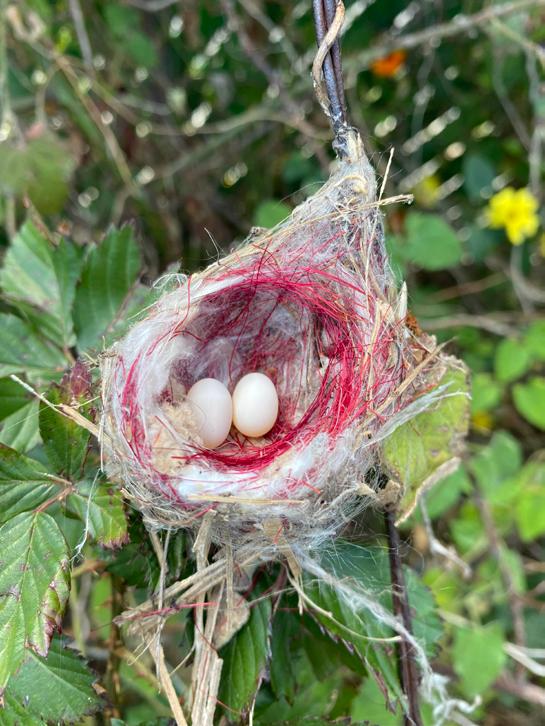
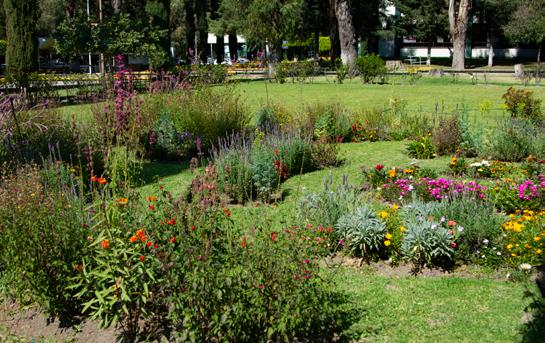
“Cuando creamos jardines para polinizadores buscamos crear áreas verdes que estén llenas de plantas nativas con flores.”
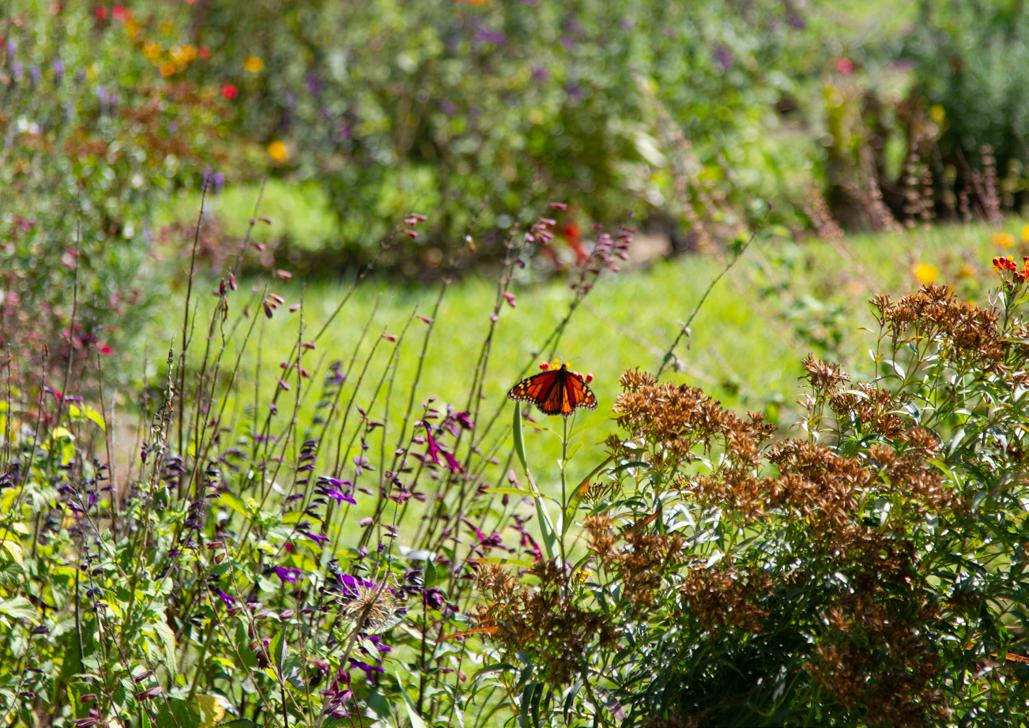
Los colibríes poseen una gran visión, son guiados principalmente por los colores de las flores ya que perciben una gama de colores más amplia que la nuestra. Las plantas a su vez han desarrollado otras estrategias para asegurar su polinización, entre ellas, su forma. De manera general, podemos asegurar que las flores que alimentan a los colibríes tienen colores que van desde los rojos a los azules pasando por los anaranjados y rosas. A diferencia de las flores polinizadas por abejas y otros insectos, las flores polinizadas por colibríes no tienen aromas fuertes.
Hummingbirds have excellent vision and are primarily guided by the colors of flowers, as they perceive a broader range of colors than we do. Plants have developed various strategies for ensuring their pollination, including their shape. In general, flowers that feed hummingbirds have colors ranging from reds to blues, passing through oranges and pinks. Unlike flowers pollinated by bees and other insects, flowers pollinated by hummingbirds do not have strong fragrances.
“When we create gardens for pollinators we aim to establish green areas filled with
native plants featuring flowers.”
CULTURE & HISTORY 17 CULTURA E HISTORIA 16
Jardines polinizadores Pollinator gardens
Mariposa monarca visitando jardín para polinizadores Monarch butterfly visiting garden for pollinators Fotografía / Photography: Sergio Ramírez
Nido de colibríes en Vivero Paraíso Colibrí
Hummingbirds nest at Paraíso Colibrí Nursery
Fotografía / Photography: Rocío Meneses
Jardín para polinizadores en universidad, Puebla
Pollinator garden in a university, Puebla
Fotografía / Photography: Sergio Ramírez
Los colibríes son consideradas las aves polinizadoras más importantes de América, ya que debido a su abundancia, polinizan a más de 10 mil especies de plantas. Por otro lado, debido a su capacidad de adaptarse a las temperaturas de zonas frías y altas (termorregulación), son eficaces polinizadores en zonas donde no muchos insectos logran subsistir. Además de ser más eficientes, ya que pierden menos cantidad de polen comparado con el que pierden las abejas durante el proceso de polinización. Un solo colibrí visita por lo menos 500 flores al día, para reponer la gran cantidad de energía que utiliza para volar a la velocidad que lo hacen. Sin embargo, si las flores no tienen suficiente néctar, esta ave tendría que visitar hasta 3000 flores diarias. De forma directa son responsables de la polinización de muchos frutos y vegetales que consumimos, entre ellos, la papaya, la piña, los frijoles, la granada, y muchos otros.
Hummingbirds are considered the most important pollinating birds in America, because due to their abundance, they pollinate over 10,000 species of plants. On the other hand, because of their ability to adapt to cold and high-temperature zones (thermoregulation), they are efficient pollinators in areas where not many insects can survive. They are also more efficient since they lose less pollen compared to bees during the pollination process. A single hummingbird visits at least 500 flowers a day to replenish the large amount of energy it uses to fly at the speed they do. However, if the flowers do not have enough nectar, this bird would have to visit up to 3000 flowers daily. They are directly responsible for the pollination of many fruits and vegetables that we consume, including papaya, pineapple, beans, pomegranate, and many others.
“Los colibríes son consideradas las aves polinizadoras más importantes de América, ya que debido a su abundancia, polinizan a más de 10 mil especies de plantas.”
“Hummingbirds are considered the most important pollinating birds in America, because due to their abundance, they pollinate over 10,000 species of plants.”
En nuestro país, contamos con 59 especies de colibríes que habitan en diferentes tipos de ecosistemas, por lo que también existe una gran diversidad de plantas con flores que los atraen. Entre ellas podemos mencionar a las Salvias un género de plantas distribuidas por todo el país y quienes mantienen una estrecha relación con los colibríes. Otros géneros de plantas que también pueden ser considerados son: Penstemon, Cuphea, Agastache, Justicia, Fuchsia, Lobelia, Malvaviscus, entre muchos otros.
In our country, Mexico, there are 59 species of hummingbirds that inhabit different types of ecosystems, leading to a great diversity of flowering plants that attract them. Among these, we can mention Salvias, a genus of plants distributed throughout the country, which maintains a close relationship with hummingbirds. Other genera of plants to consider are Penstemon, Cuphea, Agastache, Justicia, Fuchsia, Lobelia, Malvaviscus, among many others.
Algunos ejemplos de estos géneros que alimentan a los colibríes son: el mirto (Salvia microphylla), salvia azul (Salvia mexicana), salvia piña (Salvia elegans), cigarrillo (Cuphea ignea), toronjil (Agastache mexicana), muicle (Justicia spiciguera), bengala (Russellia equisetiformis). Desafortunadamente aún hay poca producción de plantas nativas con fines ornamentales y enfocadas en polinizadores. Al volver a la idea de la gran biodiversidad que posee la República mexicana, es evidente la carencia de material vegetal para crear espacios según los tipos de hábitats de nuestras ciudades inmersas en diversos tipos de clima dentro del país. En Paraíso Colibrí, desde que iniciamos hace 8 años, enfocamos nuestro esfuerzo en la producción de plantas nativas para alimentar a los colibríes, y sin darnos cuenta, nos convertimos en el primer vivero especializado en plantas para polinizadores en todo el país. Iniciamos con la producción de 8 especies, entre ellas algunas de las mencionadas, y hoy tenemos un catálogo de más de 130 plantas nativas para alimentar colibríes, mariposas, abejas y muchos otros insectos.
Some examples of these genera that feed hummingbirds include: mountain sage (Salvia microphylla), mexican sage (Salvia mexicana), pineapple sage (Salvia elegans), mexican cigar flower (Cuphea ignea), mexican giant hyssop (Agastache mexicana), mexican honeysuckle (Justicia spicigera), and coral plant (Russellia equisetiformis). Unfortunately, there is still limited production of native plants for ornamental purposes and focused on pollinators. Returning to the idea of the great biodiversity in Mexico, there is an evident lack of plant material to create spaces tailored to the habitats of our cities immersed in various climates within the country. At Paraíso Colibrí, since we started 8 years ago, we have focused our efforts on producing native plants to feed hummingbirds. Without realizing it, we became the first specialized nursery in plants for pollinators in the entire country. We began with the production of 8 species, including some of those mentioned, and today we have a catalog of more than 130 native plants to feed hummingbirds, butterflies, bees, and many other insects.

CULTURE & HISTORY 19 CULTURA E HISTORIA 18
Food Production in Mexico.” Biological Conservation 142, no. 5 (2009): 1050–57. https://doi.org/10.1016/j.biocon.2009.01.016. Jardines polinizadores Pollinator gardens
LITERATURA CONSULTADA / REFERENCES: Aprende con Paraíso Colibrí sobre los Jardínes polinizadores y el colibrí como agente polinizador.
Ashworth, Lorena, Mauricio Quesada, Alejandro Casas, Ramiro Aguilar, and Ken Oyama. “Pollinator-Dependent
Colibrí comiendo de un Agastache mexicana
Hummingbird eating from a Agastache mexicana
Fotografía Photography: Sergio Ramírez
Las flores del huerto familiar maya Flowers of the Mayan homegarden
Por / By : Juan P. Pinzón y Juan José Ancona Aragón
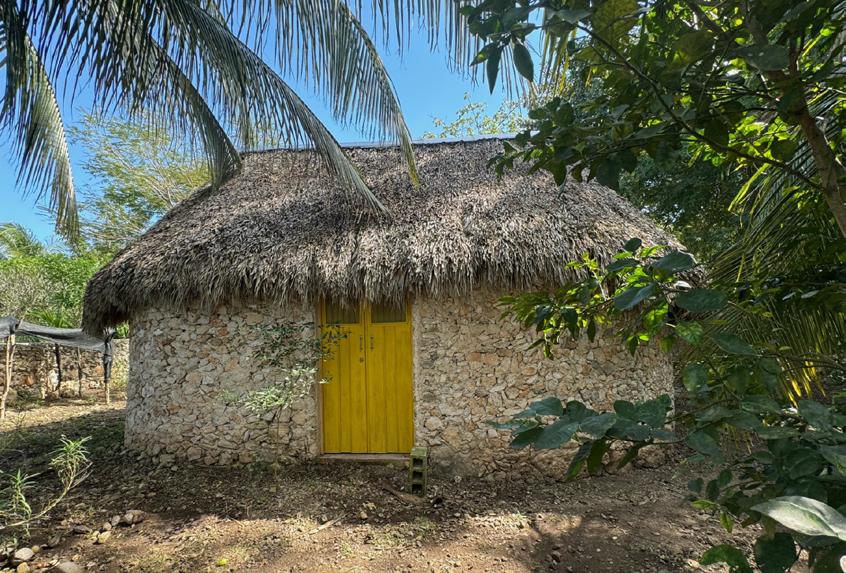
El huerto familiar maya es un agroecosistema de origen prehispánico que ha permanecido hasta nuestros días, utilizando diversas especies, prácticas agropecuarias, instrumentos y conocimientos de las culturas originarias y del mestizaje. La casa habitación está inmersa en él, junto con la cocina, lavadero, espacios para animales, árboles frutales, hortalizas y plantas ornamentales.
The Mayan homegarden is an agroecosystem of pre-Hispanic origin that has remained to this day, using various species, agricultural practices, instruments and knowledge of native cultures and its mixture with the Hispanic heritage. The house is immersed in it, along with the kitchen, laundry room, spaces for animals, fruit trees, vegetables and ornamental plants.
Área de plantas ornamentales en un huerto familiar, Dzoncauich, Yucatán Area with ornamental plants in a homegarden, Dzoncauich, Yucatán Fotografía Photography: Juan J. Ancona
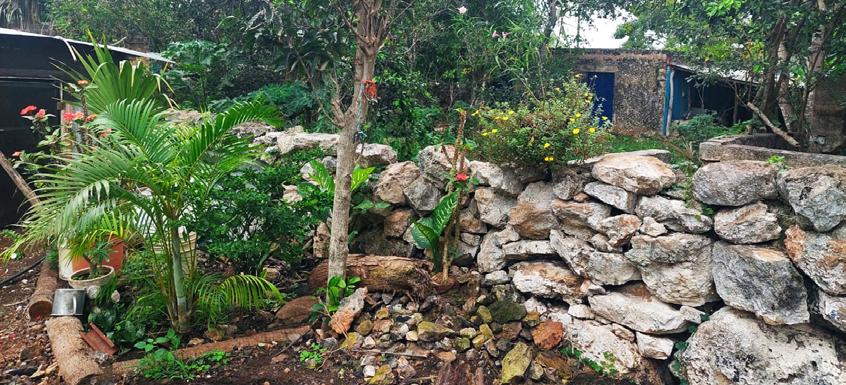
Las plantas son el componente biológico principal del huerto familiar, entre las que podemos encontrar frutales, hortalizas, medicinales, para leña, forrajeras, cercas vivas y ornamentales. Estas últimas destacan por sus flores coloridas u hojas de gran tamaño y se ubican comúnmente al frente y a los costados de la casa, con el fin de embellecer el hogar y proporcionar un disfrute a los miembros de la familia y a las personas que pasen por el lugar.
Plants are the main biological component of the Mayan homegarden, among which we can find fruit trees, vegetables, medicinal, firewood, forage, living fences and ornamentals. The latter stand out for their colorful flowers or large leaves and are commonly located in front and on the sides of the house, in order to embellish the home and provide enjoyment for family members and people who pass by.
“Las plantas son el componente biológico principal del huerto familiar maya.”
“Plants are the main biological component of the Mayan homegarden.”
De acuerdo con estudios del Dr. Salvador Flores y colaboradores de la Universidad Autónoma de Yucatán, en los huertos familiares mayas existen decenas de plantas ornamentales de variadas familias botánicas, tanto nativas como exóticas, algunas de las cuales son comunes en los jardines de todo el mundo, como por ejemplo las rosas, flores del desierto, maravillas y bugambilias, así como otras que son más particulares de nuestra región. A continuación, hablaremos de algunas de las especies que podemos encontrar más frecuentemente en los huertos familiares mayas de la península de Yucatán, destacando las siguientes:
According to studies by Dr. Salvador Flores and collaborators from the Autonomous University of Yucatán, in the Mayan homegardens we can find dozens of ornamental plants from various botanical families, both native and exotic, some of which are common in gardens throughout the world, such as roses, desert roses, marigolds and bougainvilleas, as well as others that are more particular to our region. Next, we will talk about some of the species that we can find most frequently in the Mayan homegardens of the Yucatan Peninsula, among which the following stand out:
CULTURE & HISTORY 21 CULTURA E HISTORIA 20
of the Mayan homegarden
Flowers
Casa maya / Mayan house Fotografía / Photography: Manuel Lara Cuenca
Cresta de gallo (Celosia argentea var. cristata). Conocida como xtees en lengua maya, es una planta realmente hermosa que puede medir poco más de 1 m de altura. La flor es muy llamativa por sus colores rojo, morado y anaranjado con textura de terciopelo. Esta flor es muy apreciada culturalmente porque es utilizada en la temporada de Día de Muertos como un componente principal en los altares de los fieles difuntos. Es una planta domesticada y cultivada en todo el mundo, aunque su origen geográfico no es claro.
Flor de mayo (Plumeria rubra). Esta especie es un árbol de madera muy quebradiza, que puede alcanzar hasta los 5 m de altura. Las flores varían en colores, pudiendo ser blancas, cremas, amarillas, rosadas, rojas, o con una combinación de colores; además, despiden una fragancia dulce y agradable. Un dato importante es que las plantas con flores blancas son las únicas que se encuentran creciendo nativas en la península de Yucatán; los demás colores ya son productos de la selección humana, es decir que se encuentran en algún grado de domesticación.
Plumed cockscomb (Celosia argentea var. cristata). Known as xtees in the Mayan language, it is a truly beautiful plant that can be just over 1 m in height. The flower is very striking for its red, purple and orange colors with a velvet texture. This flower is highly appreciated culturally because it is used during the Day of the Dead season as a main component on the altars of the faithful departed. It is a domesticated plant and cultivated throughout the world, although its geographical origin is not clear. Frangipani (Plumeria rubra). This species is a tree with very brittle wood, which can reach up to 5 m in height. The flowers vary in color, they can be white, cream, yellow, pink, red, or a combination of these colors. In addition, they produce a sweet and pleasant fragrance. An important fact is that the plants with white flowers are the only ones found growing in the Yucatan Peninsula as natives. The other colors are a consequence of human selection, that is, they show some degree of domestication.

Cresta de gallo ( Celosia argentea var. cristata )
Plumed cockscomb (Celosia argentea var. cristata)
Fotografía / Photography: Reaperman, CC BY-SA 4.0)

Flor de mayo ( Plumeria rubra ), mostrando variedad en los colores de sus pétalos Frangipani (Plumeria rubra), showing variation in the colors of its petals
Fotografía / Photography: Wolfblitz2, CC BY-NC-ND 3.0

Varios especies de mañanitas Several species of Eleven O'Clock
Fotografía / Photography Juan J. Ancona y Juan P. Pinzón
Lirios. Estos comprenden una amplia variedad de plantas que se reproducen por bulbos (conocidos como “cebollas”), y suelen tener flores muy vistosas. En los huertos encontramos varias especies, tales como las brujitas, el lirio araña, lirio de Japón, el lirio rojo, etc. Aquí destacamos el lirio blanco (Crinum erubescens), nativo de la península, con flores de pétalos blancos en forma de cinta y estambres largos de color violeta.
Galán de noche (Brunfelsia americana). Nativa de las Antillas, esta planta es muy apreciada por el distintivo olor que despiden sus flores durante la noche. Es un arbusto de hasta tres metros de alto, cuyas flores son de color crema, en forma de tubo y en el extremo superior se abre formando cinco lóbulos redondeados. Algunas otras especies se conocen con el mismo nombre común, pero ésta es más común en nuestra región.
Mañanitas (Portulaca spp.). Estas plantas tienen hojas pequeñas y carnosas, y crecen postradas en el suelo. Sus flores pueden ser rojas, magentas, blancas, amarillas o incluso bicolores. Como su nombre lo dice, las flores abren por la mañana y se cierran al caer la tarde. En la península de Yucatán existen cuatro especies nativas y otras que son introducidas de otras partes de México. Una de las nativas, la verdolaga (P. oleracea), es comestible, mientras que las especies restantes son ornamentales. Es común encontrar este tipo de plantas en macetas adornando las albarradas.
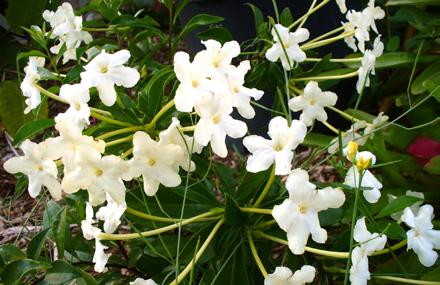
nitida
Flora Online, http://www.worldfloraonline.org/
Lilies. These include a wide variety of plants that reproduce by bulbs, which usually display very glamorous flowers. In the orchards we find several species, such as the fairy lilies, the spider lily, the Japan lily, the red lily, etc. Here we highlight the white lily (Crinum erubescens), native to the peninsula, with flowers with white ribbon-shaped petals and long violet stamens.
Lady of the night (Brunfelsia americana).
Native to the Antilles, this plant is highly appreciated for the distinctive fragrance that its flowers produce at night. It is a shrub up to three meters high, whose flowers are creamcolored, tube-shaped which opens at the upper part forming five rounded lobes. Some other species are known by the same common name, although this one is more common in our region. Eleven o’clock (Portulaca spp.). These plants have small, fleshy leaves, and grow prostrate on the ground. Their flowers can be red, magenta, white, yellow or even bicolor. As its name suggests, the flowers open in the morning and close in the evening. In the Yucatan Peninsula there are four native species and others that are introduced from other parts of Mexico. One of the natives, the purslane (P. oleracea), is edible, while the remaining species are ornamental. It is common to find this type of plants in pots adorning the “albarradas”.
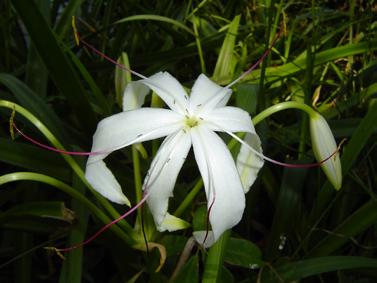
CULTURE & HISTORY 23 CULTURA E HISTORIA 22
Las flores del huerto familiar maya Flowers of the Mayan homegarden
LITERATURA CONSULTADA / REFERENCES:
Arellano Rodríguez, Alberto, José Salvador Flores Guido, Juan Tun Garrido y María Mercedes Cruz Bojórquez. Nomenclatura, forma de vida, uso, manejo y distribución de las especies vegetales de la península de Yucatán. Mérida, Yucatán: UADY-CONACYT, 2003.
Flores Guido, José Salvador. Huertos familiares de la Península de Yucatán. Mérida, Yucatán: UADY-CONACYT, 2012.
Flores Guido, José Salvador. Los huertos familiares en Mesoamérica. Mérida, Yucatán: UADY-CONACYT, 2012. Sosa, Victoria y José Salvador Flores Guido. Flora Ornamental de Mérida. Mérida, Yucatán: Ayuntamiento de Mérida, 2014. World
Brunfelsia
Fotografía Photography: S. Zona, CC BY-NC 2.0
Crinum erubescens
Fotografía / Photography: Juan P. Pinzón
Dahlia coccinea, caprichosa joya de la nación Dahlia coccinea, capricious jewel of the nation
Por / By Pamela López
Es mágico descubrir que “Corazón de la tierra”¹ es lo que nuestros ancestros usaban como descripción para las hoy llamadas flores; estas surgen como símbolos de amor o compasión, bienvenida, despedida, celebración e incluso perdón.
It's magical to discover that “Heart of the earth”¹ is what our ancestors used as a description for what we now call flowers; these emerge as symbols of love or compassion, welcome, farewell, celebration, and even forgiveness.

Hay “corazones de tierra” como ejes de la economía para algunos sitios como el excelentísimo Mercado de Jamaica en la CDMX. También los hay como acompañamientos en los platillos tradicionales de nuestra gastronomía, como la quesadilla con flor de calabaza (ayotli en Náhuat)² (Cucurbitáceas), y quizás también aparecen como sorpresas destellantes en una caminata al monte un sábado por la mañana, cuando aún el rocío ha desplegado sus partículas volviéndose vapor, y pequeñas gotas escurren por los pétalos color coccinea³, un color sobresaliente para las laderas intermedias al valle. Estas flores son las guardianas del verano, van haciéndose lugar entre el pedregal y el sotobosque lleno de otras especies de hojas grandes. Ellas las acocoxóchitl⁴ también llamadas tallos huecos con agua (según Montemayor et.al) o dalias, fascinan hasta al más distraído paseante.
There are “hearts of the earth” as the economic axis for some places such as the excellent Jamaica Market in Mexico City. They also serve as accompaniments in traditional dishes of our cuisine, like the quesadilla with pumpkin flowers (ayotli in Nahuatl) 2 (Cucurbitaceae), and perhaps they also appear as dazzling surprises during a walk in the mountains on a Saturday morning, when the dew has unfolded its particles, turning into vapor, and small droplets are dripping from the coccinea-colored petals 3 , a striking color for the hillside intermediate to the valley. These flowers are the guardians of summer, carving out their space between the rocky terrain and the undergrowth filled with other species of large leaves. The acocoxóchitl⁴ also called hollow stems with water (according to Montemayor et al.) or dahlias, captivate even the most distracted stroller.

Fotografía
CULTURE & HISTORY 25 CULTURA E HISTORIA 24
CONSULTADA
LITERATURA
/ REFERENCES:
¹Heyden, Doris. 1983. Mitología y Simbolismo de La Flora En El México Prehispánico. México: Universidad Nacional Autónoma de México (UNAM).
²Montemayor, Carlos. 2007. Diccionario del Náhuatl en el español de México. Ciudad Universitaria, México: Universidad Nacional Autónoma (UNAM).
³La palabra coccinea surge del latín coccineus: purpúreo, grana. En las culturas ancestrales es conocida su relación con la obtención del colorante rojo del insecto Dactylopius coccus. ⁴Alemán, Baltasar Cuevas. Flores mexicanas / Mexican flowers. Artes de México, no. 104 (1968): 25–50. http://www.jstor.org/stable/24315998.
Dahlia coccinea, capricious jewel of the nation
Dahlia coccinea Fotografía Photography: Jorge Rojas S
Dahlia imperialis sonriente en el sendero del Cerro Pelón de San Gabriel Azteca, Hidalgo México
Dahlia imperialis smiling on the trail of Cerro Pelón of San Gabriel Azteca, Hidalgo Mexico
Photography: Pamela López
Las Dahlia coccinea son las flores que por decreto presidencial iniciada la década de los 60 's del siglo anterior, aportan un estandarte a la larga lista de adeptos de nuestro patrimonio natural y cultural, no por nada es la flor nacional. El mismo Nezahualcóyotl la describió como una “joya especial”⁵, vaya que le creo al rey-poeta. Se llama “dahlia” porque como historia de intercambios y correspondencias de finales del siglo XVIII, el director del Jardín Botánico de Madrid recibió semillas de esta especie provenientes del Jardín Botánico de México, las analizó y decidió nombrarlas como Andrés Dahl, el discípulo de Linneo, sí, ese Linneo el de la nomenclatura binómica o la clasificación de flora y fauna con “nombre y apellido”. Andrés Dahl por su cuenta se llevó un regalo, el ponerle su apellido como nombre a la flor más cotizada por europeos; tan es así que se creó un movimiento en Inglaterra “The Annual Dahlia Register” dirigido por personas floricultoras y agrónomas para hacerla florecer, ya que las condiciones climáticas convertían esto en un reto, y por ende en una aspiración.
The Dahlia coccinea are the flowers that by presidential decree beginning in the 60's decade of the previous century, contributes a standard to the long list of supporters of our natural and cultural heritage, it's not for nothing that it is the national flower. Nezahualcóyotl himself described it as a “special jewel”⁵, I really believe the king-poet. It is called “dahlia” because, in a story of exchanges and correspondences from the late 18th century, the director of the Botanical Garden of Madrid received seeds of this species from the Botanical Garden of Mexico, he analyzed them and decided to name them after Andrés Dahl, Linnaeus's disciple, yes, that Linnaeus of binomial nomenclature or the classification of flora and fauna with “first and last name”. Andrés Dahl, in turn, received a gift, having the flower named after him, the most coveted by Europeans; such was the extent of its desirability that a movement was created in England, “The Annual Dahlia Register ”, led by floriculturists and agronomists to make it bloom, given that the climatic conditions posed a challenge, turning it into an aspiration.

Personalidades querían adornar sus jardines naturalistas o clásicos con esta bella especie, la codiciaban en sus portales y en sus recorridos, pero ni Alexander Von Humboldt junto a Bonpland que interesados por estas flores maravillosas conocidas en su viajes por México, lograron germinar⁶ y atestiguar su “rosea-coccinea”.
Y es que esta flor tiene un capricho secreto, iniciando porque en efecto es nativa de México, fuente más importante de su germoplasma con 35/38 de sus especies completamente mexicanas, a pesar de los esfuerzos europeos, aquí nos percatamos de su gran capricho: nunca dejar de ser de aquí. Esto tiene una explicación científica por supuesto. Resulta que todo tiene que ver con la altimetría, el suelo y el “camote” de la planta.
Personalities wanted to adorn their naturalistic or classic gardens with this beautiful species, they coveted it for their gateways and strolls, however, even Alexander Von Humboldt, along with Bonpland, interested in these marvelous flowers encountered during their travels in Mexico, managed to germinate⁶ and witness their “rosea-coccinea”.This flower has a secret whim, starting because it is indeed native to Mexico, the most important source of its germplasm with 35/38 of its species being completely Mexican, despite European efforts, here we realize it's great whim: never ceasing to be from here. This has a scientific explanation, of course. It turns out that everything has to do with the altitude, the soil, and the plant's “camote” (tuber).
“La Dahlia coccinea es la flor nacional.”
“The Dahlia coccinea is the national flower.”
El primer “capricho” alude a la preferencia de las dalias de estar siempre cerca de la cota 2000 msnm y evitar pasar los 2500 msnm⁷. El segundo tiene a la Reserva de la Biósfera Sierra Gorda de Querétaro⁸ como acompañamiento; es ejemplo de los gustos de esta flor por su diversidad de suelos, van desde litosoles (suelos ricos en materia orgánica), luvisoles (suelos ácidos) y rendzinas (suelos arcillosos), esto favorece al crecimiento y floración de nuestras dalias. Por último, su raíz tuberosa es sensible y puede caer en el ataque de una colonia de hongos si el agua es abundante. El “corazón de la tierra” nacional es venerada por nosotros y por extraños asombrados. Es un tesoro que propongo deberíamos ver más en nuestros espacios públicos, jardines de escuelas, museos, calles locales o la jardinera afuera de la casa o edificio. Si en sus caprichos estuviera que la viéramos u oliéramos todos los días, tal vez no sería solo por decreto el amor que le brindamos.
LITERATURA CONSULTADA / REFERENCES: ⁵ Idem
The first “whim” refers to the preference of dahlias to always be close to an altitude of 2000 meters above sea level and to avoid exceeding 2500 meters above sea level⁷. The second has the Sierra Gorda Biosphere Reserve in Querétaro⁸ as a companion; it exemplifies the preferences of this flower for its soil diversity, ranging from lithosols (organic-rich soils) to luvisols (acidic soils) and rendzinas (clayey soils), which favor the growth and flowering of our dahlias. Finally, its tuberous root is sensitive and can fall victim to a fungal attack if water is abundant. The national “heart of the earth” is revered by us and by astonished strangers. It is a treasure that I propose we should see more in our public spaces, school gardens, museums, local streets, or the planter outside the house or building. If in its whims it were that we saw or smelled it every day, perhaps the love we give it would not be just by decree.
⁶Wulf, Andrea. 2015. The Invention of Nature: The Adventures of Alexander von Humboldt, the Lost Hero of Science: Costa & Royal Society Prize Winner. London, England: John Murray. ⁷Carrasco-Ortiz, Marco, Guadalupe Munguía Lino, Arturo Castro-Castro, Georgina Vargas-Amado, Mollie Harker, y Aarón Rodríguez. 2018. “Riqueza, Distribución Geográfica y Estado de Conservación Del Género Dahlia (Asteraceae) En México.” Acta Botanica Mexicana, no. 126. https://doi.org/10.21829/abm126.2019.1354. ⁸Instituto Nacional de Ecología. 1999. “Programa de Manejo Reserva de La Biosfera Sierra Gorda México.” https://paot.org.mx/centro/ine-semarnat/anp/AN15.pdf.
CULTURE & HISTORY 27 CULTURA E HISTORIA 26
de la nación
Dahlia coccinea caprichosa joya
Dahlia coccinea, capricious jewel of the nation
Dalia Roja
Fotografía Photography: Juan Carlos Fonseca Mata, CC BY-SA 4.0, via Wikimedia Commons
El jardín floral: del espacio de placer al reservorio biodiverso
The floral garden: from pleasure space to biodiversity reservoir
Marianela Rochas-Porraz
La flor, según la real academia española es el brote reproductor de las plantas fanerógamas, y, por extensión, de muchas otras, que consta de hojas fértiles, los carpelos y estambres, y hojas no fértiles, acompañantes, que forman el perianto1. Pero más allá de su atractivo visual y olfativo, metafóricamente, estos brotes han estado asociados por muchas culturas a la abundancia, a la sexualidad, a la espiritualidad y al renacimiento de la vida después de la muerte.
The flower, according to the Royal Spanish Academy, is the reproductive sprout of phanerogamic plants, and, by extension, of many others, which consists of fertile leaves, the carpels and stamens, and non-fertile, accompanying leaves, which form the perianth1 But beyond their visual and olfactory appeal, metaphorically, these sprouts have been associated by many cultures with abundance, sexuality, spirituality and the rebirth of life after death.
“Las flores han estado asociadas a la abundancia, sexualidad, espiritualidad y al renacimiento de la vida después de la muerte.” Exterior del palacio de Villandry en Francia
“Flowers have been associated with abundance, sexuality, spirituality ans the rebirth of life after death.”
of the Villandry Palace in France

CULTURA E HISTORIA 28
LITERATURA CONSULTADA / REFERENCES: ¹Real academia de la lengua española [en línea] https://dle.rae.es/flor
Fotografía / Photography petra-nesti-13303447 Pexels
Exterior
Por ejemplo, en el cuadro “La Virgen de las Rocas” de Leonardo da Vinci, conservado en el museo del Louvre en París, se representa a la Virgen María sosteniendo al niño Jesús junto con San Juan Bautista y el ángel Gabriel rodeada de flores y vegetación. Las flores en este cuadro se consideran elementos simbólicos que resaltan la divinidad y la gracia de la Virgen María².
Cabe mencionar que en los huertos-vergeles, comunes en los monasterios de la edad media europea y en otros espacios productivos de otras culturas, la presencia de las flores en los árboles y arbustos anunciaban la llegada de los deseados frutos. Asimismo, en las festividades sincréticas del Día de los Muertos en México, las flores adornan hasta ahora los altares, caminos y tumbas, en una fecha en que los muertos regresan con los vivos a compartir las cosechas.
For example, in the painting “The Virgin of the Rocks” by Leonardo da Vinci, preserved in the Louvre museum in Paris, the Virgin Mary is represented holding the baby Jesus together with Saint John the Baptist and the angel Gabriel surrounded by flowers and vegetation. The flowers in this painting are considered symbolic elements that highlight the divinity and grace of the Virgin Mary².
It is worth mentioning that in orchards, common in the monasteries of the European Middle Ages and in other productive spaces of other cultures, the presence of flowers on the trees and bushes announced the arrival of the desired fruits. Likewise, in the syncretic festivities of the Day of the Dead in Mexico, flowers adorn altars, paths and tombs, on a date when the dead return with the living to share the harvest.


Por otra parte, en los jardines “de placer”³ como los del palacio de Villandry, en Francia, los vegetales eran plantados más bien con un propósito estético, siguiendo los ejemplos de los jardines italianos del cinquecento. Dichos jardines tenían como programa crear espacios propicios para el paseo, la reflexión y el descanso para la nobleza y la burguesía emergente.
On the other hand, in “pleasure gardens”³ such as those of the palace of Villandry, in France, vegetables were planted primarily for aesthetic purposes, following the examples of Italian gardens from the sixteenth century. These gardens aimed to create suitable spaces for strolling, reflection, and relaxation for the nobility and the emerging bourgeoisie.

“Los jardines de Villandry tenían como programa crear espacios propicios para el paseo, la reflexión y el descanso para la nobleza y la burguesía emergente.”
“Villandry gardens aimed to create suitable spaces for strolling, reflection, and relaxation for the nobility and the emerging bourgeoisie.”
CULTURE & HISTORY 31 CULTURA E HISTORIA 30
LITERATURA CONSULTADA / REFERENCES: ² “Entre las flores, es posible identificar una Aquilegia vulgaris, una primavera, acanto de hojas blandas, hierba de San Juan, así como iris y polemonio azul.” Charles Nicholl,
Léonard de Vinci: biographie, Arles, Actes Sud, 2006, Quatrième partie: De nouveaux horizons: 1482-1490, chap. 3 (« La Vierge aux rochers »), p. 238-244.
El jardín floral: del espacio de placer al reservorio biodiverso The floral garden: from pleasure space to biodiversity reservoir
LITERATURA CONSULTADA / REFERENCES: ³Monique Chatenet, Monique Moseer, Jardin. Vocabulaire typologique et technique. Paris, Editions du Patrimoine, 2017, p. 29.
La Virgen de las Rocas The Virgin of the Rocks Fotografía Photography: Leonardo da Vinci, CC BY 3.0 <https:// creativecommons.org/licenses/by/3.0>, via Wikimedia Commons
Altar del Día de los Muertos Day of the Dead altar Fotografía Photography: pexels-jhovani-morales-14335914
Vista de los jardines de Villandy View of the Villandry gardens Fotografía / Photography: pexels-axp-photography-16628337
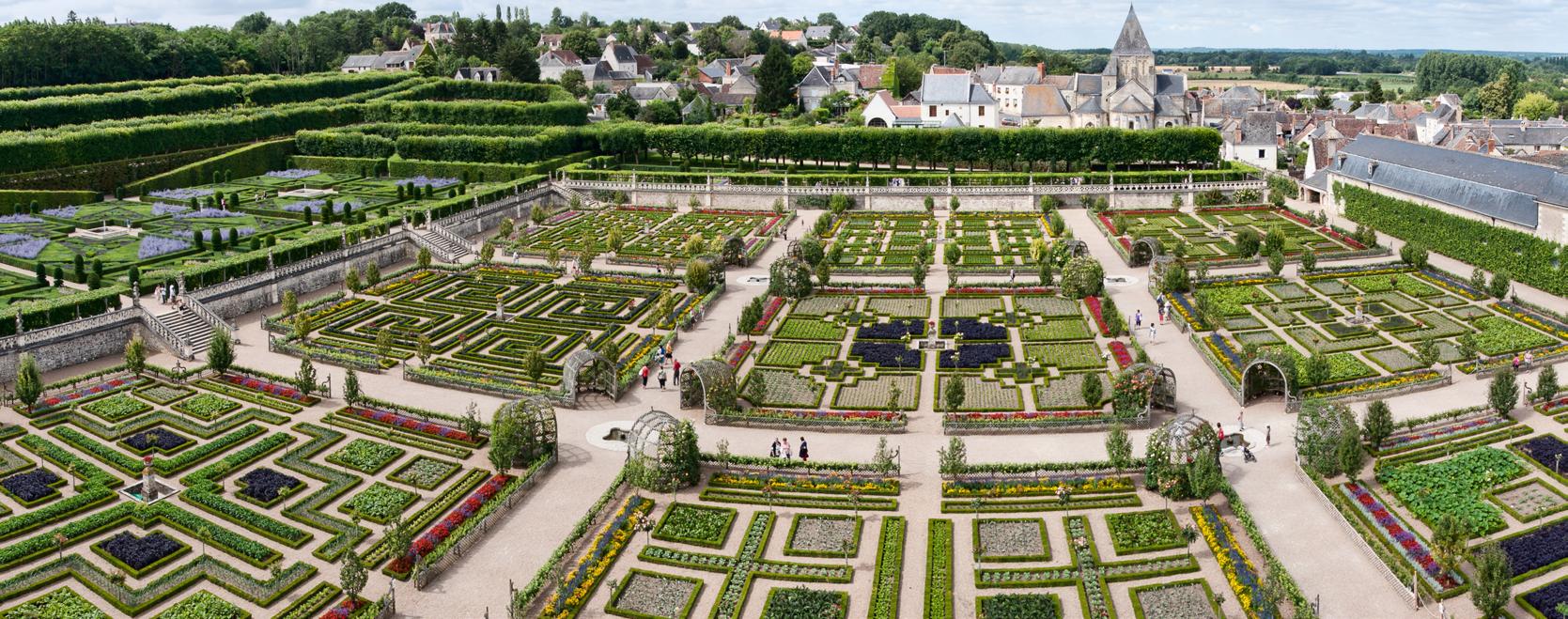
El palacio de Villandry fue construido entre los siglos XI y XVII. Sin embargo, la configuración actual de los espacios vegetales es producto de una restitución realizada en el siglo XX. Los jardines recuperan el estilo renacentista con la adquisición de Joachim Carvallo, quien obtiene el castillo y modifica los jardines entre 1908 y 1918. Antes admirados en la época renacentista y modificados por diversos propietarios, Carvallo los restaura con meticulosidad científica, combinando estilos como el medieval, renacentista y francés, inspirándose en la arqueología y la literatura renacentista.
En la actualidad dicho palacio de la ruta de los “Castillos del valle del Loira” recibe millones de visitantes, sobre todo en primavera cuando llega la época de floración. Mantenidos por los descendientes de Carvallo, los jardines de Villandry han adoptado prácticas orgánicas desde 2009, especialmente en el huerto, priorizando la observación y prevención para evitar tratamientos químicos.
The Villandry palace was built between the 11th and 17th centuries. However, the current configuration of the vegetal spaces is the product of a restitution carried out in the 20th century. The gardens recovered the Renaissance style with the acquisition of Joachim Carvallo, who obtained the castle and modified the gardens between 1908 and 1918. Previously admired in the Renaissance era and modified by various owners, Carvallo restored them with scientific meticulousness, combining styles such as medieval, Renaissance and French, drawing inspiration from archeology and Renaissance literature.
Currently, this palace on the “Loire Valley Castles” route receives millions of visitors, especially in spring when the flowering season arrives. Maintained by Carvallo descendants, the Villandry gardens have adopted organic practices since 2009, especially in the orchard, prioritizing observation and prevention to avoid chemical treatments.
Para concluir, es necesario destacar que los jardines florales sirven más ampliamente que para la alimentación y la recreación, ayudando significativamente a la biodiversidad. Las flores y los insectos polinizadores, como las abejas, mariposas y escarabajos, establecen una simbiosis vital. Las flores proporcionan néctar y polen, recursos esenciales para la nutrición de los insectos, mientras que los insectos, al alimentarse y transportar el polen de una flor a otra en busca de alimento, facilitan la polinización y la reproducción de las plantas.
Esta interacción no solo promueve la diversidad de especies vegetales, sino que también sustenta ecosistemas enteros al brindar alimento y hábitats a una amplia gama de organismos, contribuyendo así a la salud y estabilidad de los ecosistemas naturales.
Tlaj tij neki ti tlamauizoz
Uitzitzilin ipatlaniliz
Kualkantzin xi meua,
Xi mo ajuiaui mo tenkamak
Uan xi on mo tlalo
Xia xi mo xochimilchiauati⁴
Si quieres admirar el vuelo de los colibrís
Levántate temprano, Perfuma tus labios
Y corre rápido
A sembrar las flores de tu jardín⁴
If you want to admire the flight of hummingbirds
Wake up early,
Perfume your lips
And run fast
To plant the flowers in your garden⁴
To conclude, it is necessary to highlight that floral gardens serve more broadly than just food and recreation, significantly helping biodiversity. Flowers and pollinating insects, such as bees, butterflies and beetles, establish a vital symbiosis. Flowers provide nectar and pollen, essential resources for insect nutrition, while insects, by feeding and transporting pollen from one flower to another in search of food, facilitate pollination and plant reproduction. This interaction not only promotes the diversity of plant species, but also sustains entire ecosystems by providing food and habitats for a wide range of organisms, contributing to the health and stability of natural ecosystems.
CULTURE & HISTORY 33 CULTURA E HISTORIA 32
The floral garden: from pleasure space to biodiversity reservoir
Mardonio Carballo (poeta náhuatl)
⁴Mardonio
El jardín floral: del espacio de placer al reservorio biodiverso
LITERATURA CONSULTADA / REFERENCES:
Carballo, El canto de las flores, Paris, JBE, 2024.
Vista aérea de los jardines de Villandry
Aereal view of the Villandry gardens
Fotografía / Photography: Jean-Christophe BENOIST, CC BY-SA 3.0
Jardín aromático y espacio polinizador
Aromatic garden and pollinator space
Por / By: Iván Juárez | x-studio
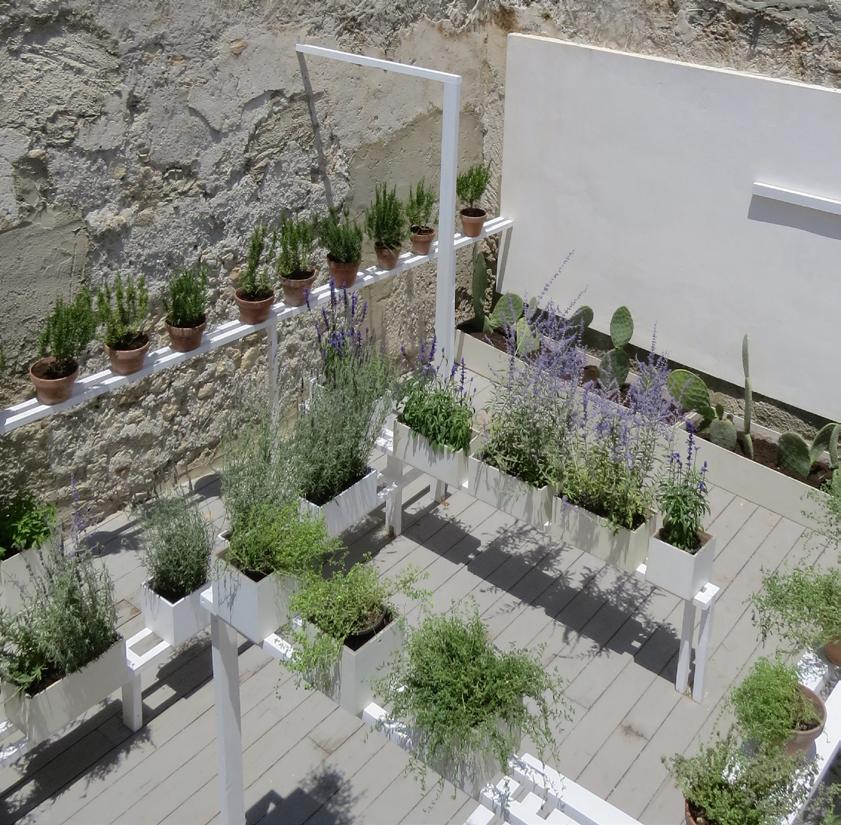
Como un homenaje al paisaje Mediterráneo, el arquitecto y paisajista Iván Juárez de x-studio ha realizado una intervención de acupuntura urbana concebida específicamente para uno de los espacios públicos que conforman el complejo cultural Farm Cultural Park, ubicado en el barrio -Sette Cortilien la población de Favara, Sicilia.
Conceived as a tribute to the Mediterranean landscape, the architect and landscaper Iván Juárez from x-studio has created a site-specific intervention of urban acupuncture in a public space of Farm Cultural Park, a cultural complex located in the -Sette Cortili- neighborhood in the town of Favara, Sicily.

Farm Cultural Park es un referente comunitario que en los últimos años ha transformado positivamente su tejido urbano y social mediante una serie de estrategias artísticas y educativas. El barrio se ha revitalizado a través de la recuperación de sus espacios arquitectónicos y espacios comunes, integrando proyectos artísticos y culturales generando un tejido en el que sus habitantes conviven entre patios, terrazas y jardines, junto con obras de arte público, murales, así como con espacios expositivos y educativos, como la Escuela de Arquitectura para niños SOU.
Farm Cultural Park is a community model that in recent years has positively transformed the urban and social tissue through a series of artistic and educational strategies. The neighborhood has been revitalized through the restoration of its architectural spaces and common areas, integrating artistic and cultural projects that generate a weave where the inhabitants coexist among terraces, patios, squares and gardens, along with public art works, murals, exhibition and educational spaces such as the School of Architecture for children (SOU).
“El barrio se ha revitalizado a través de la recuperación de sus espacios arquitectónicos y espacios comunes.”
“The
neighborhood has been revitalized through the restoration of its architectural spaces and common areas.”
INTERVENTIONS 35 INTERVENCIONES 34
Vista aérea del jardín aromático / Aereal view of the aromatic garden Fotografía / Photography: Iván Juárez | x-studio
Aromatic garden and pollinator space
Abeja polinizando / Bee pollinating Fotografía / Photography: Iván Juárez x-studio
El proyecto establece un diálogo con el contexto local donde el paisaje natural y cultural de Sicilia, así como el contexto histórico de Favara, han proporcionado el escenario de referencia para desarrollar la propuesta. Esta intervención rinde homenaje al paisaje Mediterráneo a través de un jardín olfativo y polinizador donde se activan varias fragancias de especies aromáticas.
“La intervención rinde homenaje al paisaje Mediterráneo a través de un jardín olfativo y polinizador donde se activan varias fragancias de especies aromáticas.”
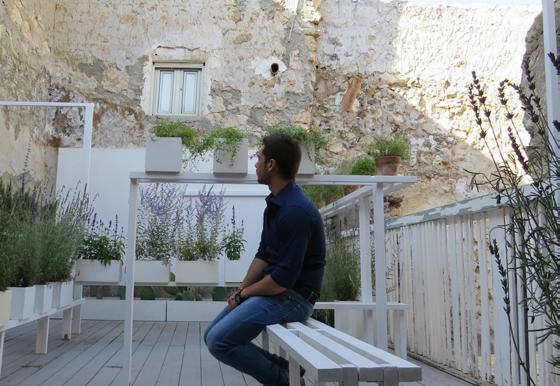
La propuesta surge a partir de la recuperación de un patio-terraza en desuso, transformándolo en un espacio olfativo donde se mezclan diversas fragancias de plantas aromáticas mediterráneas: lavanda, tomillo, romero, salvia, menta, entre otras. Fragancias naturales que atraen diversas especies de abejas, mariposas y otros insectos, generando nuevas formas de coexistencia con el entorno natural, al mismo tiempo de activar la experiencia sensorial y la memoria olfativa.
The project establishes a dialog with the context where the natural and cultural landscape of Sicily as well as the historic context of Favara, have provided the reference framework for developing the proposal. This intervention pays tribute to the Mediterranean landscape through an olfactory and pollinator garden where various fragrances of aromatic species are activated.
“The intervention pays tribute to the Mediterranean landscape through an olfactory and pollinator garden where various fragrances of aromatic species are activated.”

The proposal arises from the recovery of an unused patio-terrace, transforming it into an olfactory space where various fragrances of Mediterranean aromatic plants blend: lavender, thyme, rosemary, sage, mint, among others. Natural fragrances that attract various species of bees, butterflies, and other insects, generating new forms of coexistence with the natural environment, while activating sensory experience and olfactory memory.

Se propone una aproximación al contexto local a través de un espacio-vivo que ofrece diversas experiencias y crea conexiones entre la comunidad y su propio paisaje. Lugar de contemplación y recorrido. Así mismo, el proyecto se articula por un sistema de líneas (madera recuperada), que funciona como un hilo conductor que entrelaza el espacio a través de su recorrido. El sistema crea diversas capas, alturas y escenarios, generando una secuencia de micro-paisajes que, al ser recorridos, se muestran diversas texturas, gamas, sonidos y aromas.
An approach to the local context is proposed through a living-space that offers diverse experiences and creates connections between the community and its own landscape. It serves as a place for contemplation and exploration. Similarly, the project is articulated by a system of lines (reclaimed wood), which functions as a guiding thread that interweaves the space throughout its journey. The system creates diverse layers, heights, and settings, generating a sequence of micro-landscapes that, as they are traversed, reveal various textures, ranges, sounds, and aromas.
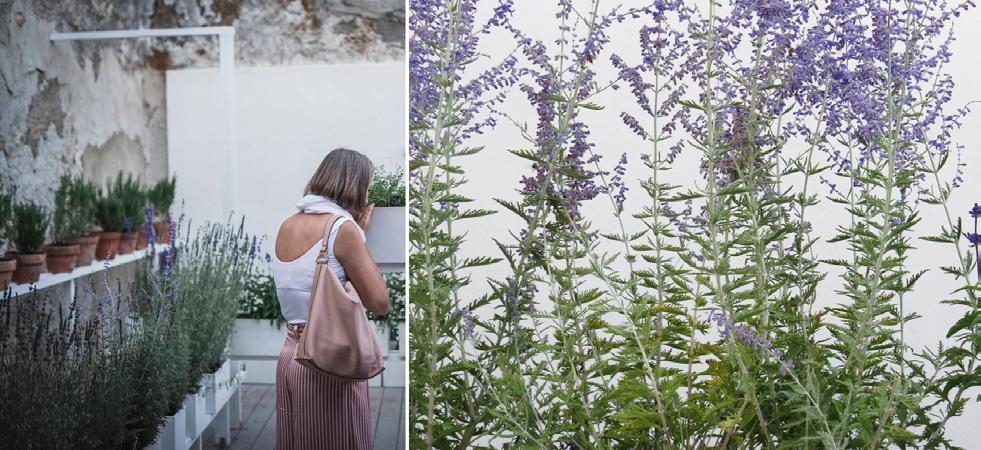
INTERVENTIONS 37 INTERVENCIONES 36
Jardín aromático y espacio polinizador
Disfrutando el jardín Enjoying the garden
Fotografía / Photography: Iván Juárez x-studio
Vista de espectador Spectator's view
Fotografía / Photography: Iván Juárez | x-studio
garden and pollinator space
Aromatic
Plantación de lavanda / Lavender plantation
Fotografía / Photography: Iván Juárez x-studio
Recorriendo el jardín
Walking through the garden
Fotografía Photography: Iván Juárez x-studio
Lavanda / Lavender
Fotografía / Photography: Iván Juárez x-studio
Un homenaje a Lady Day: Un jardín musical Un hommage à Lady Day: A musical garden
Por / By: Strootman Landschapsarchitecten
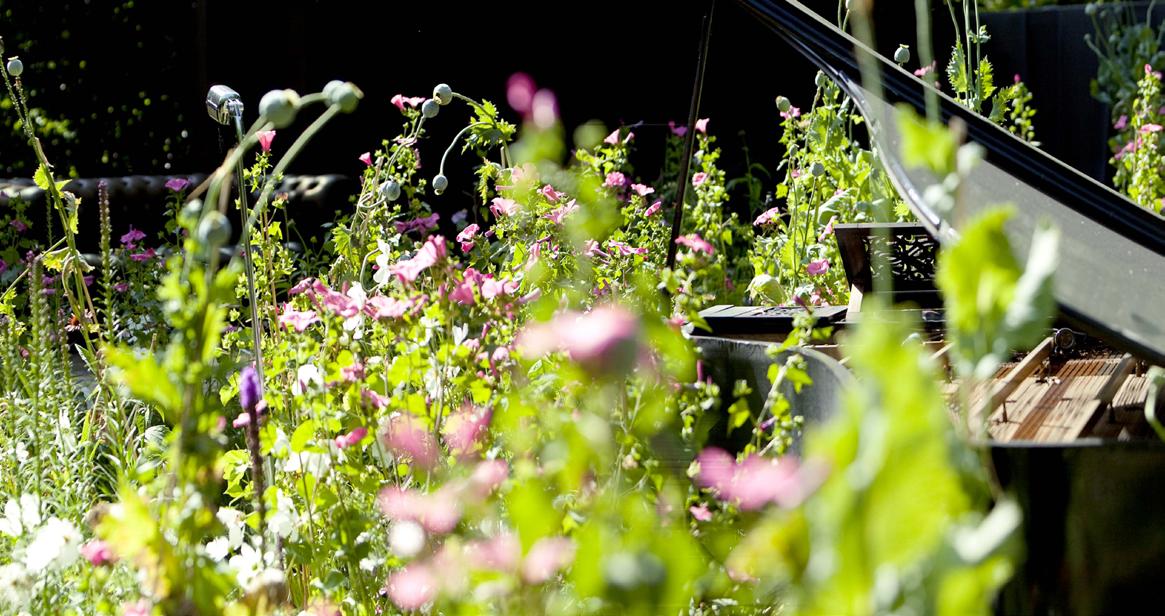
En 2010 se diseñó un jardín poético para participar en el concurso abierto del festival de jardines en Chaumont-sur-Loire. El tema del festival era Cuerpo y Alma, por lo que decidimos crear un tributo a la legendaria vocalista de jazz Billie Holiday (Lady Day) ya que “Body & Soul” es una de sus canciones más conocidas.
Back in 2010 a poetical garden was designed as an entry in an open competition for the garden festival in Chaumont-sur-Loire. The theme of the festival was Body & Soul. We choose to create a tribute to the legendary jazz vocalist Billie Holiday (Lady Day) since Body & Soul is one of her best-known songs.
Este jardín es una evocación a la breve pero intensa vida de Holiday. En medio de un mar de flores blancas y rosas en donde predominan las ampolas, están situados un piano negro barnizado y un microfóno. El clásico de jazz “Body & Soul” se mezcla con la abundancia de flores que emanan del piano. Este espectáculo agridulce se puede contemplar desde un cómodo salón de jazz que ofrece un momento de sombra a los visitantes en un jardín lleno de romanticismo frágil y un amor adictivo por la vida.
This garden is an evocation of Holiday’s brief but intense life: a deserted black varnished piano and a microphone on a standard are situated amid a white and pink sea of flowers, among which poppies predominate. The jazz classic “Body & Soul” wafts over the wealth of flowers from the piano. This bittersweet spectacle can be viewed from a comfortable jazz lounge that offers a moment’s shade to visitors in a garden full of fragile romanticism and addictive love of life.

“El clásico de jazz “Body & Soul” se mezcla con la abundancia de flores que emanan del piano.”
“The
jazz classic “Body & Soul” wafts over the wealth of flowers from the piano.”
INTERVENTIONS 39 INTERVENCIONES 38
Vista del piano entre flores
View of the piano between flowers
Fotografía / Photography: Strootman Landschapsarchitecten
Un hommage à Lady Day
Vista desde el pabellón / View from the pavillion
Fotografía / Photography Strootman Landschapsarchitecten
La piel del jardín es de color negro oscuro; pero su corazón es suave y rosado. Un pequeño pabellón con sofás lounge abarca toda la anchura del jardín en la entrada. Cortinas negras enmarcan el jardín y cierran el espacio de su entorno. En su interior, te encuentras en un mundo diferente: te sientas en el escenario y disfrutas del paisaje como en un jardín Zen japonés.
The skin of the garden is strong and black; its heart is soft and pink. A small black pavilion with lounge sofas spans the entire width of the garden at the entrance. Black curtains frame the garden and close the space off from its surroundings. Inside you find yourself in a different world: you sit on the stage and enjoy the scenery as in a Japanese Zen garden.



La vegetación consiste en plantas que se cultivan anualmente en Países Bajos de manera previa para asegurar suficiente color en el jardín en el mes de mayo. Las dominantes amapolas rosadas son una alusión al hábito del consumo de drogas de Billie Holiday y se intercalan con otras como Miosotis, Malva, Cosmos, Echinacea, Anémona, Argemone y Lavatera para hacer del jardín una explosión de color a lo largo de la temporada.
The vegetation consists of plants cultivated annually and beforehand in the Netherlands to ensure enough colour in the garden in the month of May. The dominant pink poppies are an allusion to Billie Holiday’s drug habit and are interspersed with other flowers including Myosotis, Mallow, Cosmos, Echinacea, Anemone, Argemone and Lavatera to make the garden an explosion of colour throughout the season.

INTERVENTIONS 41 INTERVENCIONES 40
Cortina, tela de poliéster, color negro
Árbol existente
de segunda
color negro Set de bocinas reproduciendo la canción “Body and Soul” y un micrófono de los 50s en un soporte Sofá
Vigas de madera para sostener y cubrir cortinas
Piano
mano,
Chesterfield
Un homenaje a Lady Day Planta conceptual Conceptual plan Ilustración Illustration Strootman
Landschapsarchitecten
Piano de segunda mano, color negro Set de bocinas reproduciendo la canción "Body and Soul" y un micrófono de 50s en un soporte Second hand grand piano, color black Speaker set playing the track "Body and Soul" and a 50s retro microphone on a stand
Cortinas, tela de poliéster, color negro Vigas de madera para sostener y cubrir cortinas Curtain, fabric polyester, color black Wooden beams to hold up and drape curtains
Sofá Chesterfield Chesterfield sofas
Árbol existente
Existing tree
Echinacea
Fotografía / Photography: Strootman Landschapsarchitecten
Un hommage à Lady Day
Fichas de plantas utilizadas / Card of used plants
Ilustración / Illustration Strootman Landschapsarchitecten
La grieta The crack
Por / By: Alive Architecture + Taktyk
A primera vista, este proyecto parece ser un diseño de desprendimiento contemporáneo. Está relativamente bien ejecutado y ofrece una estética audaz y legible. Eso ya es algo... Más interesante es debatir la verdadera agencia del paisaje. Por lo tanto, no elegimos un proyecto exitoso, sino un intento. El sitio está ubicado en Kapelleveld en Bruselas, una ciudad jardín cooperativa diseñada por Louis van der Swaelmen, un influyente urbanista del paisaje en ese momento. Él había concebido aquí una red de senderos verdes donde los vecinos podrían encontrarse, además de un centro comunitario y un parque en el núcleo de la ciudad.
At first glance, this project looks like any contemporary depaving design. It is relatively well-executed and delivers a bold and legible aesthetic. That is already something… More interesting is to debate the real agency of landscape. Therefore, we didn’t choose a successful project but an attempt. The site is located in Kapelleveld in Brussels, a cooperative garden city designed by Louis van der Swaelmen, an influential landscape urbanist at the time. He had envisioned here a network of green lanes where neighbours could meet in addition to a community centre and a park at the core of the city.

El parque central nunca fue construido y se privatizó, siendo utilizado por un club de tenis frecuentado por expatriados, mientras que la mayoría de los senderos verdes fueron cerrados con el tiempo. La ciudad jardín se convirtió en un lugar sin espacios abiertos accesibles, donde apenas coexisten y se relacionan entre sí tres generaciones de habitantes (clase media local, migrantes italianos y, más recientemente, del norte de África y del este de Europa).
The central park has never been built and become privatized by a tennis club used by expats, whereas most of the green lanes have been closed over time. The garden city became a place without accessible open space where three generations of inhabitants (local middle class, Italian migrants, and lately North African and East Europeans) barely co-exist, and engage with each other.
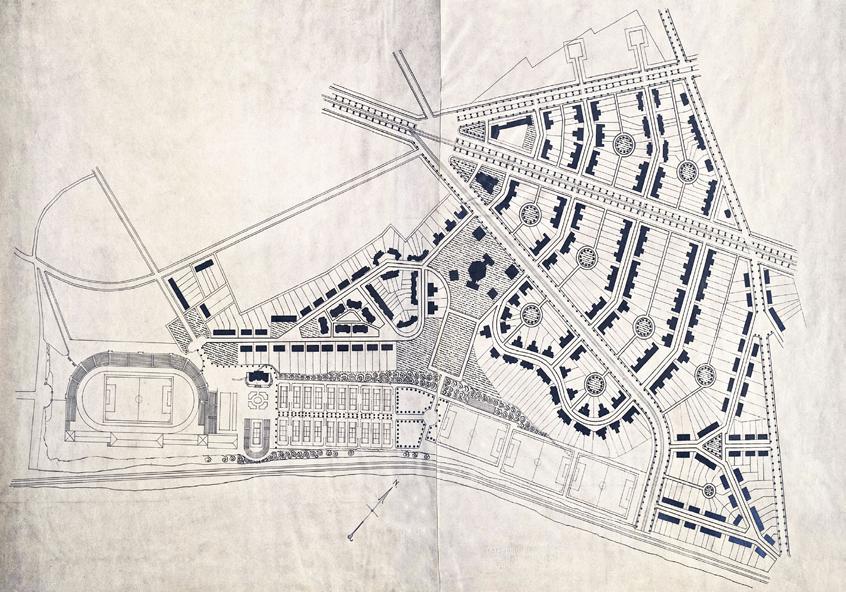
¿Puede la arquitectura del paisaje respaldar esfuerzos colectivos, literalmente romper las fronteras mentales y físicas que reconocemos entre los seres humanos? Nuestro proyecto recupera el núcleo central del sitio contiguo al centro comunitario al activar un área de tenis en desuso. Descubrir su suelo devuelve los ciclos de vida y los procesos de co-construcción. La “grieta” apunta hacia un borde sólido que abrimos para conectar con el sistema del valle.
Can landscape architecture support collective endeavours, literally crack the mental and physical borders that we acknowledge between humans? Our project reclaims the central core of the site adjacent to the community centre by activating a left-over tennis plot. Uncovering its ground brings life cycles and co-construction processes back. The “crack” points toward a hard edge that we open to connect to the valley system.
INTERVENTIONS 43 INTERVENCIONES
Vista aérea / View from above Fotografía / Photography: SLRB
The crack
Plano original de la ciudad jardín de Kapelleveld / Original plan of garden city Kapelleveld Ilustración Illustration: Louis van der Swaelmen
Esas fueron nuestras intenciones iniciales, este enfoque táctico abogando por la creación de un jardín en una ciudad jardín generó debates, conversaciones y tensiones. Al final, entendemos que nuestro papel como diseñadores no era resolver, sino revelar las tensiones existentes en juego; ese intento puede ser relevante para discutir.
Those were our initial intentions, this tactical approach advocating the creation of a garden in a garden city generated debates, conversations and tensions. In the end, we understand that our role as designers was not to solve but to reveal the existing tensions at stake; that attempt may be relevant to discuss.
“¿Puede la arquitectura del paisaje respaldar esfuerzos colectivos, literalmente romper las fronteras mentales y físicas que reconocemos entre los seres humanos?”
“Can landscape architecture support collective endeavours, literally crack the mental and physical borders that we acknowledge between humans?”

La antigua cancha de tenis, mucho tiempo retirada del uso colectivo, está siendo reinvertida por el “55”, una casa comunitaria y los habitantes de la ciudad jardín. Está poblada de curiosidades y esculturas sociales co-creadas a partir de materiales encontrados. El término “escultura social”, prestado del artista Joseph Beuys, establece los principios de la práctica urbana nacida de la experiencia de los espacios: es menos importante el resultado de un proyecto que el proceso participativo que lleva a él. ¿Puede llamarse al resultado una obra de arte? Según Beuys, el artista es cualquier individuo. El arte estimula una implicación colectiva capaz de reunir y forjar una sociedad. A partir de entonces, el propio acto, el “hacer” (aquí “hacer con”), se convierte en la obra.
The former tennis court, long withdrawn from collective use, is being reinvested by the “55”, a community house and the inhabitants of the garden city. It is populated with curiosities, and social sculptures co-created from as-found materials. The term social sculpture, borrowed from artist Joseph Beuys, sets out the principles of the urban practice born of the experience of spaces: what matters is less the result of a project than the participatory process leading to it. Can the result be called a work of art? According to Beuys, the artist is any individual. Art stimulates a collective implication capable of gathering and forging a society. From then on, the act itself, the “doing”, (here “to make with”), becomes the work.

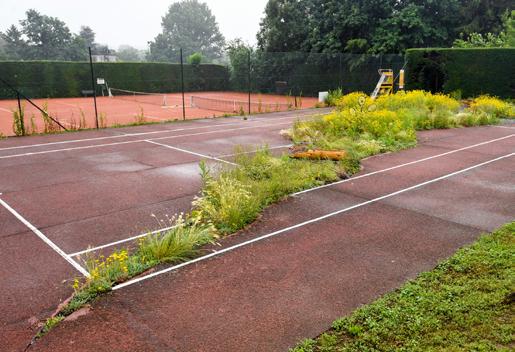
INTERVENTIONS 45 INTERVENCIONES 44
La grieta
The crack
Vista dentro del sitio View from within the site Fotografía / Photography: SLRB
Uso de “La grieta” Usage of “ The Crack ” Fotografía Photography: SLRB
Uso de “La grieta” Usage of “ The Crack ” Fotografía Photography: SLRB
Vista desde el nivel de la calle View from street level Fotografía Photography: SLRB
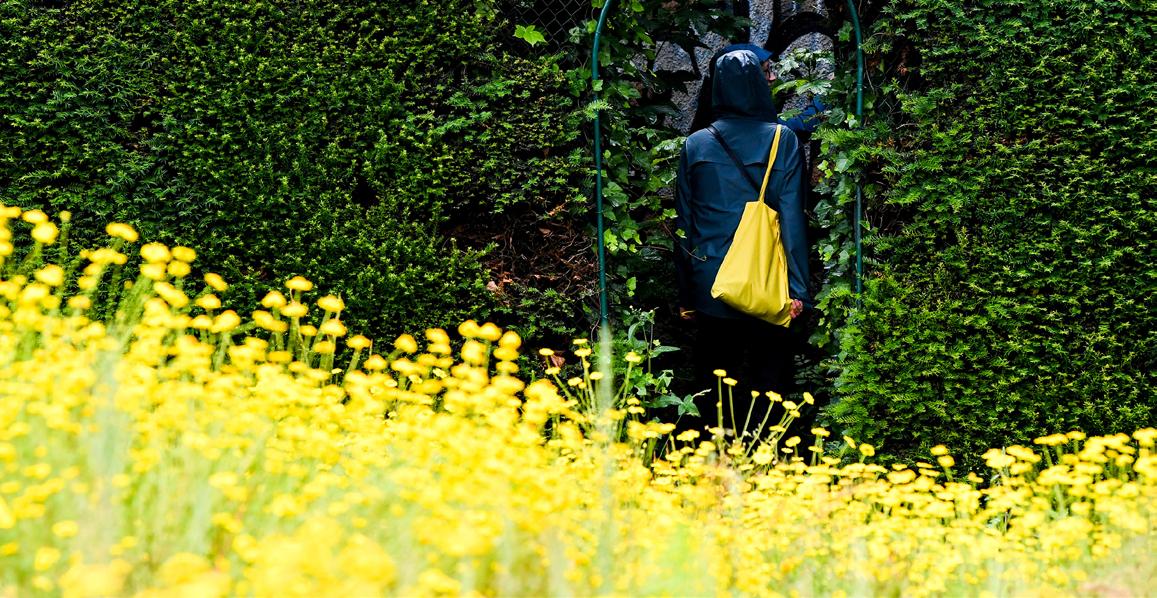
La evocación de la función deportiva preexistente está presente mediante el color amarillo y el vínculo cromático entre las intervenciones, que incluyen elementos pintados o bordados. Desde la cancha de tenis, el asfalto rojo y las líneas blancas que delimitan la zona de juego hoy son cortados por una “grieta” diagonal que libera el suelo fértil. Punteado con plantaciones de flores amarillas y troncos para el camino de los niños, se hincha gradualmente, rodea un lugar para sentarse y luego perfora la alta cobertura vegetal para incitar a aventurarse más allá, a descender al valle de Woluwe. Hemos literalmente abierto un agujero en una cobertura vegetal, y detrás de ella, un tercer espacio muy intrigante conduce a una posible red metropolitana; el “dueño” del sitio ha decidido colocar una nueva puerta allí.
Por un lado, el éxito de este proceso radica en que estas microintervenciones concretizan una propuesta alegre que libera a algunos habitantes activos de la inercia actual para actuar. Contribuye aquí a activar un marco de acción cooperativa.
The evocation of the pre-existing sports function is present by the yellow colour, and chromatic link between the interventions, which include painted elements or embroideries. From the tennis court, the red asphalt and the white lines delimiting the game zone today are cut by a diagonal “crack” that frees the fertile soil. Dotted with yellow flowering plantations and logs for the children’s path, it gradually swells, circles a place to sit, and then pierces the high hedge to incite to venture further, to go down the Woluwe valley. We have literally opened a hole within a hedge, and behind it, a very intriguing third space leads to a possible metropolitan network; the “owner” of the site has decided to place a new gate there.
On one side the success of this process is that these micro-interventions concretize a joyful proposal that frees some active inhabitants from current inertia to act. It contributes here to activate a cooperative action framework.
Por otro lado, el proyecto no logró expandir la comunidad de participantes más allá del primer grupo motivado de habitantes. Les resultó difícil abrirse a otros, especialmente a la segunda y tercera generación de migrantes en esta ciudad jardín cooperativa. Por último, el proyecto no tuvo un éxito completo al motivar a la “propietaria” o “gobernanza” cooperativa del sitio para invertir en una intervención más grande. Como suele ocurrir, el proyecto se percibió como un terreno de prueba. Nos pareció interesante compartir tanto la promesa como los límites de tales iniciativas y comprender el papel del diseño como incubador, iniciador o, en este caso, una herramienta crítica. Hoy en día, nuestra intervención puede parecer una extraña solución de diseño belga, una apertura que señala hacia una nueva puerta cerrada... esto es simultáneamente su poder; el proyecto espacial critica los modos actuales de gobernar la cooperativa y las decisiones bastante absurdas que se toman actualmente.
On the other side, the project didn’t succeed in expanding the community of participants beyond the first motivated group of inhabitants. It has been hard for them to open themselves to others, namely second and third generation of migrants in this cooperative garden city. Lastly, the project didn’t fully succeed in motivating the cooperative “owner” or “governancy” of the site to invest in a larger intervention. As often, the project has been seen as a test ground. We found it interesting to share with you both the promise but as well the limits of such initiatives and to understand the role of design as incubator, initiator or in this case a critical tool. Today our intervention can look like a weird Belgian design solution, an opening pointing at a new closed gate… this is simultaneously its power; the spatial project criticizes current modes of governing the cooperative and the rather absurd decisions currently taken.
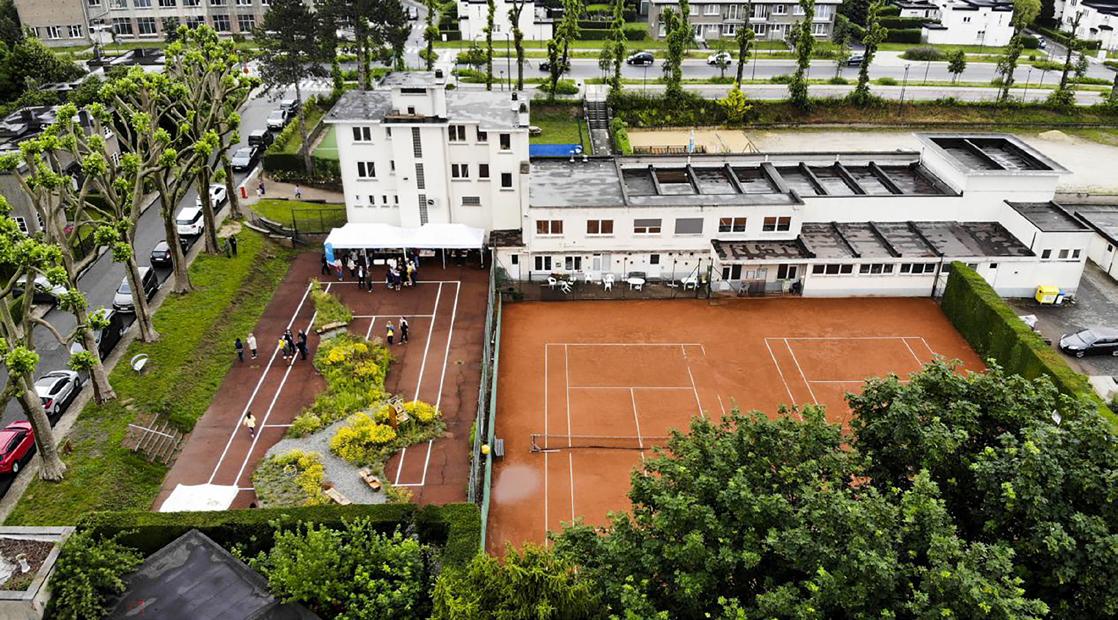
INTERVENTIONS 47 46
La grieta
Vista dentro del sitio View from within the site Fotografía Photography: SLRB
The crack
Vista aérea / View from above Fotografía / Photography: SLRB
Museo de la Cerámica y Parque del Mosaico
Ceramic Museum and Mosaic Park
Por / By: Casanova + Hernández Arquitectos

Combinación de elementos vegetales y cerámicos

Mosaico de baldosas de cerámica rotas
Mosaic broken ceramic tiles
Parque del Mosaico como símbolo de la hibridación cultural
Cama de flores con forma de mosaico Mosaic flower beds
La extensión urbana de Jinzhou, ciudad a menos de 500 kilómetros al noreste de Beijing, se ha articulado alrededor de un nuevo gran parque público de 176 Ha en una zona ganada al mar. Durante una primera fase, el parque albergó la Exposición Mundial de Arte Paisajístico de Jinzhou 2013 y una vez cerrada la exposición, el área se convirtió en el parque central de un nuevo desarrollo urbano. El diseño de la expo se basa en la paradoja de que la globalización, aunque típicamente asociada a la destrucción de la identidad cultural local, también puede generar algún tipo de identidad.
El proyecto experimenta con el concepto de hibridación cultural, que es un fenómeno desarrollado durante muchos siglos de intercambio comercial y cultural entre Occidente y Oriente.

Mosaic Park as symbol of cultural hybridization
The urban extension of Jinzhou, a city less than 500 kilometers northeast of Beijing, has been articulated by the creation of a new large public park of 176 Ha in an area reclaimed from the sea. During the first phase, the park hosted the 2013 Jinzhou World Landscape Art Exposition and once the expo was closed, the area became the central park of a new urban development.
The design of the expo is based on the paradox that globalization, although it has typically been associated with the destruction of local cultural identity, may also be able to generate some kind of identity.
The project experiments with the concept of cultural hybridization, which is a phenomenon developed during many centuries of commercial and cultural exchange between West and East.
INTERVENTIONS 49 INTERVENCIONES 48
Combination of vegetal and ceramic elements
Fotografía /
Photography: Ben McMillan
Ceramic Museum and Mosaic Park
Detalle de la fachada del museo
Details of the museum´s facade
Fotografía / Photography: Ben McMillan
Axonometría del conjunto / Axonometry Ilustración / Illustration Casanova + Hernández Arquitectos
Museo / Museum
Por un lado, el uso de piezas rotas de cerámica local de diferentes colores para la materialización del pavimento, bancos del parque y las fachadas del museo, evoca la tradición del mosaico que se extendió por toda Europa gracias al Imperio Romano que ha ido evolucionando a lo largo de la historia hasta nuestros días, aportando soluciones técnicas variadas tales como la técnica del trencadís utilizada por los arquitectos modernistas catalanes.
On one hand, the use of broken local ceramic pieces of different colors for the materialization of the pavement and benches of the park and the facades of the museum evokes the mosaic tradition that was widespread throughout Europe by the Roman Empire and that has evolved along history till the present day, bringing technical solutions such as the trencadís technique used by the Catalan modernist architects.

Por otro lado, la geometría del parque está inspirada en el vidriado craquelado de la porcelana china desarrollado a partir del siglo X durante la Dinastía Song en las piezas cerámicas conocidas como Ru Ware y Ge Ware. El Parque Mosaico y el Museo de la Cerámica recuerdan a los ciudadanos que la región de Jinzhou fue en su día una zona de producción de cerámica y porcelana, aunque esta tradición hoy en día está olvidada.
On the other hand, the geometry of the park is inspired by the crackled glaze of the Chinese porcelain developed from the 10th century during the Song Dynasty in the Ru Ware and Ge Ware ceramic pieces. The Mosaic Park and the Ceramic Museum remind citizens that the Jinzhou region was once a production area of ceramic and porcelain, although this tradition was lost for centuries, being nowadays forgotten.
“El proyecto representa el paradigma del parque urbano contemporáneo, que no es ni un fragmento del paisaje natural ni una pieza ajardinada de la ciudad, sino la mezcla de ambos.”
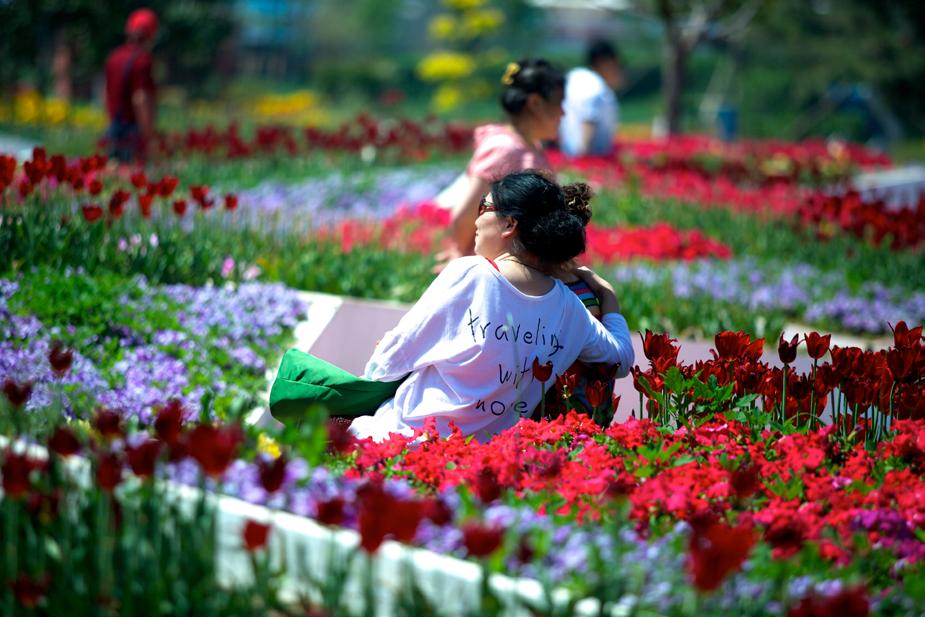
Paisaje híbrido: mezcla de arquitectura y paisaje
El proyecto representa el paradigma del parque urbano contemporáneo, que no es ni un fragmento del paisaje natural ni una pieza ajardinada de la ciudad, sino la mezcla de ambos. El Parque Mosaico presenta un carácter híbrido que combina arquitectura con paisaje y naturaleza con artificio.
La geometría irregular del parque se despliega espacialmente siguiendo una topografía tridimensional craquelada, donde el paisaje y la arquitectura se fusionan en una superficie continua formada por 884 planos irregulares.
Hybrid landscape: mix of architecture and landscape
The project represents the paradigm of the contemporary urban park, which is neither a fragment of the natural landscape nor a landscaped piece of the city, but the mix of both of them. Mosaic Park presents a hybrid character that combines architecture with landscape, and nature with artifice.
The irregular geometry of the park is spatially unfolded into a crackled three-dimensional topography, where landscape and architecture merge into a continuous surface formed by 884 irregular planes.
“The project represents the paradigm of the contemporary urban park, which is neither a fragment of the natural landscape nor a landscaped piece of the city, but the mix of both of them.”
INTERVENTIONS 51 INTERVENCIONES 50
Museo de la Cerámica y Parque del Mosaico
Mosaico de baldosas de cerámica rotas Mosaic of broken ceramic tiles
Fotografía / Photography: Casanova + Hernández Arquitectos
Mosaico de cama de flores de diferentes especies Mosaic of flower beds of different species
Park
Ceramic Museum
and Mosaic
Planos vegetales del parque
Plan planes of the park
Fotografía / Photography: Ben McMillan

“Flores y cerámica se funden en un colorido mosaico que une naturaleza y artesanía local.”
“Flowers and ceramic blend into a colorful mosaic that brings nature and local crafts together.”
Esta geometría se materializa como un mosaico policromático formado por la combinación de flores de cuatro especies y colores diferentes con mosaicos creados con trozos rotos de cerámica local china. Flores y cerámica se funden en un colorido mosaico que une naturaleza y artesanía local. La geometría constructiva del Museo de la Cerámica se concibe como una extensión de la geometría craquelada del parque, y se materializa utilizando las mismas baldosas cerámicas utilizadas para el pavimento del parque, que se combinan en la fachada del edificio con huecos acristalados siguiendo también líneas y patrones irregulares.
This geometry is embodied as a polychromatic mosaic formed by combining flowers of four different species and colors with mosaics created with broken pieces of local Chinese pottery. Flowers and ceramic blend into a colorful mosaic that brings nature and local crafts together. The building geometry of the Ceramic Museum is conceived as an extension of the crackled geometry of the park, and it is materialized using the same ceramic tiles used for the pavement of the park, which are combined in the building facade with glazed openings also following irregular patterns.
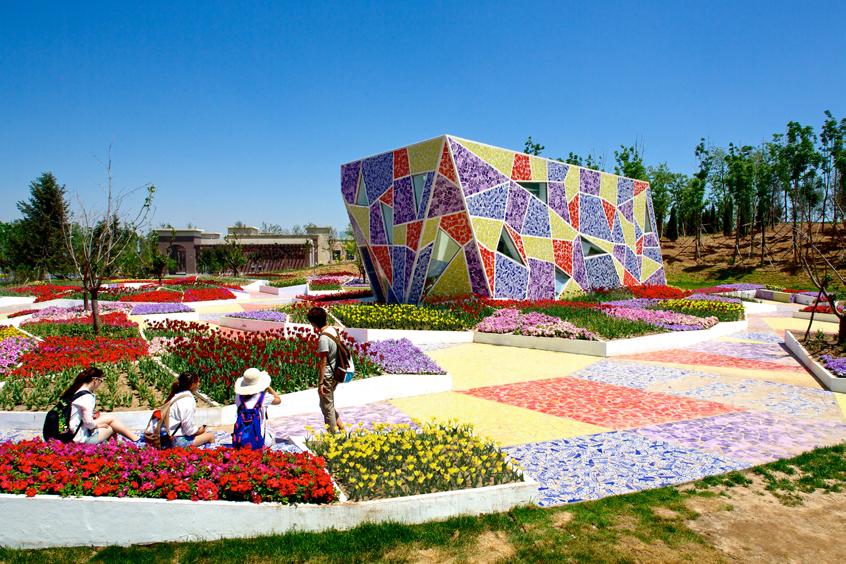
El mosaico aporta unidad geométrica y visual al proyecto, evitando la habitual separación entre “hardscape” y “softscape”. Paisaje y arquitectura, Parque del Mosaico y Museo de la Cerámica se funden en una única obra, a la vez polifacética y sorprendente, caracterizada por su carácter híbrido y su fuerte contenido plástico.
Activador de la vida pública
El parque y el museo funcionan como activadores de la vida pública de dos maneras: por un lado, el parque busca activar el uso del espacio público. El carácter icónico del proyecto sirve como atractivo que invita a los visitantes a disfrutar de una experiencia multisensorial. Por otro lado, el Museo de la Cerámica funciona como un activador de la vida cultural y social de Jinzhou, intentando despertar la curiosidad del visitante sobre el pasado del lugar, transmitiendo una tradición perdida, y finalmente creando un programa de exposiciones y eventos públicos en un nuevo punto de encuentro para los ciudadanos.
The mosaic provides geometric and visual unity to the project, avoiding the usual separation between hardscape and softscape. Landscape and architecture, Mosaic Park and Ceramic Museum merge into a single work, at the same time multifaceted and surprising, characterized by its hybrid character and strong plastic content.
Public life activator
The park and the museum work as activators of public life in two ways: on one hand, Mosaic Park seeks to activate the use of public space. The iconic nature of the project serves as an attraction that invites visitors to enjoy a multi-sensory experience. On the other hand, the Ceramic Museum functions as an activator of the cultural and social life of Jinzhou, trying to arouse the visitor's curiosity about the past of the place, transmitting a lost tradition, and finally creating a program of exhibitions and public events in a new meeting point for the citizens.
INTERVENTIONS 53 INTERVENCIONES 52
Museo de la Cerámica y Parque del Mosaico
Planos vegetales del parque
Plant planes of the park
Fotografía / Photography: Casanova + Hernández Arquitectos
Ceramic Museum and Mosaic Park
Vista de una de las entradas al parque View of one of the entrances of the park Fotografía Photography: Ben McMillan
Flores que hablan: Los Agaves de Acre Resort Flowers that speak: Los Agaves at Acre Resort
Por / By: Leleu Paisaje
Acre Resort es famoso por su característico oasis de palmeras lustrosas y casas de árbol en medio del denso follaje; sin embargo, en su pasado estas tierras habían sido dedicadas a la agricultura, por lo que la ausencia de árboles y otros tipos de estratos era notoria.
Acre Resort is famous for its distinctive oasis of glossy palm trees and tree houses amidst dense foliage; however, in its past these lands were dedicated to agriculture, making the absence of trees and other strata types noticeable.
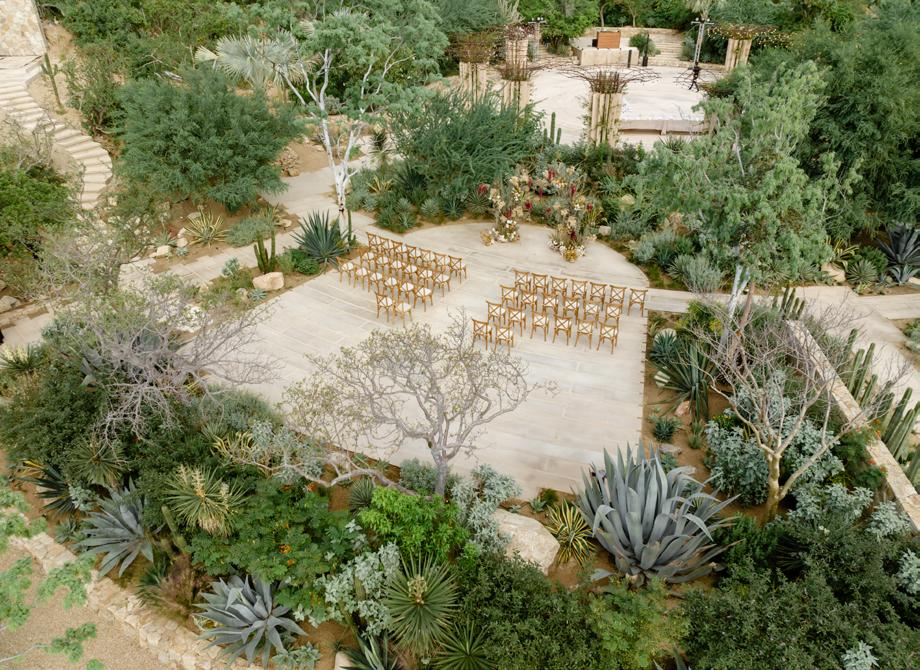


Lo único que resaltaba era un pequeño oasis de palmas nativas que fue reforzado con la dedicación de los dueños Stuart McPherson y Cameron Watt. A través de 12 años desde su creación, el espacio se transformó en la bella representación del estero de San José que existe hoy. Sin embargo, aún quedaba mucho terreno por cultivar e ideas por expresar. De ahí nació una oportunidad para crear una nueva área de eventos para las reconocidas bodas de Acre, de ahí nació “Los Agaves”. El diseño de paisaje y la ejecución de jardinería fueron creación de Leleu Paisaje dirigido por la Arquitecta Paisajista Celine Leleu, quien estuvo convencida de que la icónica vegetación de Baja California Sur sería el elemento que complementaría perfectamente la minuciosa arquitectura de Demataller realizada por el Arquitecto Piero Demichellis.
The only thing that stood out was a small oasis of native palms that was reinforced with the dedication of owners Stuart McPherson and Cameron Watt. Over 12 years since its creation, the space transformed into the beautiful representation of the San José estuary that exists today. However, there was still much land left to be cultivated and ideas to be expressed. Hence, an opportunity arose to create a new event area for Acre's renowned weddings, giving birth to “Los Agaves”. The landscape design and gardening execution were the creations of Leleu Paisaje by Landscape Architect Celine Leleu, who was convinced that the iconic vegetation of Baja California Sur would perfectly complement the meticulous architecture of Demataller by Architect Piero Demichellis.
INTERVENTIONS 55 INTERVENCIONES 54
Área de ceremonia / Ceremony area Fotografía / Photography: LA76 Photography
Flowers that speak: Los Agaves at Acre Resort
Celine Leleu en Los Agaves
Celine Leleu in Los Agaves
Fotografía / Photography: Olle Bergkvist
Etapas de vegetación / Stages of vegetation
Ilustración Illustration: Celine Leleu
Lo más importante del tema paisajístico era lograr que este espacio se fundiera con el contexto natural de manera armoniosa, no solo estéticamente sino también ecológicamente. Una intervención que acompañará las pautas de las estaciones, marcará los colores de la primavera y los verdes emergentes de la época de lluvias al compás del desierto. Esto únicamente se podría lograr primordialmente por la observación, vislumbrar los elementos más destacados de lo inmediato, los personajes arbóreos que formarían el carácter principal y las cactáceas que definirían el temperamento de la noche al ser duplicadas en sombras largas y etéreas.
The most crucial aspect of the landscaping was to seamlessly integrate this space with the natural context, not only aesthetically but also ecologically. An intervention that will follow seasonal patterns, marking the colors of spring and the emerging greens during the rainy season in harmony with the desert. This could only be achieved primarily through observation, glimpsing the most prominent elements of the immediate surroundings, the arboreal characters that would form the main character, and the cacti that would define the temperament of the night as they are duplicated in long and ethereal shadows.

“Las flores son el verbo seductor de las plantas y nosotros somos los afortunados de poder comprenderlo.”
“Flowers are the seductive verb of plants, and we are fortunate to understand it.”
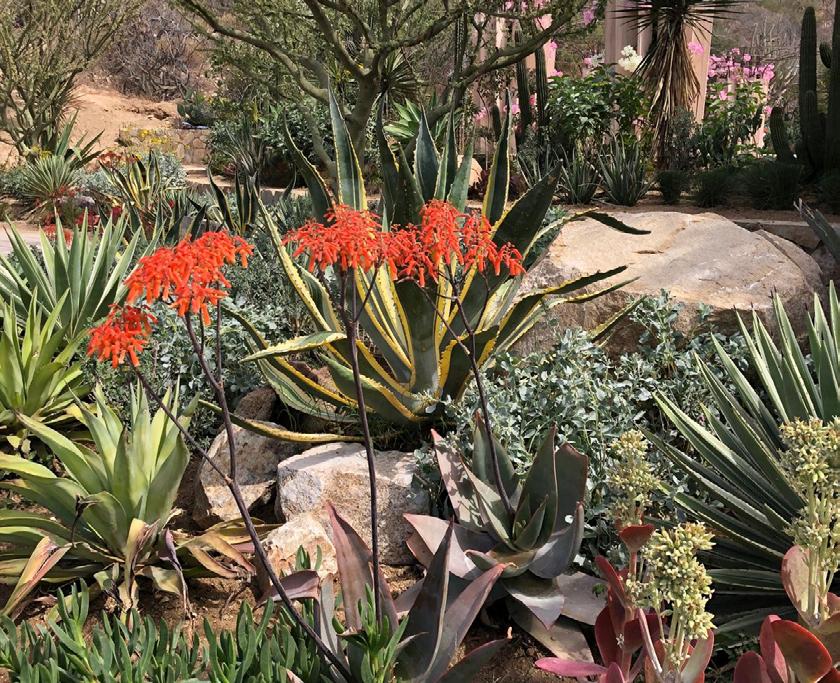
Para la proyección del paisaje, el espíritu del desierto se debía manifestar claramente. La intención fue crear el jardín en etapas de vegetación comenzando por el primer nivel, el más expuesto y árido, perteneciente al ecosistema del matorral xerófilo. En la primera fase, la mayoría de los árboles son Copales acompañados de islas de vegetación de Nopales y la Encelia (Encelia californica), arbusto oriundo de la región que funge como elemento que se propaga por todo el proyecto con llamativas flores doradas y brillantes. Posteriormente, podemos encontrar en los pasillos y áreas de lounge una paleta de árboles desérticos como Ciruelos (Cyrtocarpa edulis), Palo Blanco (Lysiloma candida) y Torotes (Bursera microphylla) acompañados de una variedad de distintos agaves de otras áreas del país, especialmente del Agave americana, que siendo un elemento poderoso en tamaños colosales, adorna el área de ceremonias.
For the landscape projection, the spirit of the desert had to manifest itself clearly. The intention was to create the garden in vegetation stages, starting from the first level, the most exposed and arid, belonging to the xerophytic shrub ecosystem. In the first phase, most trees were Copales, accompanied by islands of vegetation with Nopales and Encelia (Encelia californica), a native shrub that serves as an element spreading throughout the project with striking golden and bright flowers. Subsequently, corridors and lounge areas featured a palette of desert trees such as Cape wild-plum (Cyrtocarpa edulis), Palo Blanco (Lysiloma candida), and elephant tree (Bursera microphylla), along with a variety of different agaves from other parts of the country, specially the Agave americana, that being a powerful element in colossal sizes, it embellishes the ceremony area.
INTERVENTIONS 57 INTERVENCIONES 56
Flores que hablan: Los Agaves de Acre Resort
Luna llena en Los Agaves Full moon in Los Agaves Fotografía / Photography: Frida Rivera
Flowers that speak: Los Agaves at Acre Resort
Flores de Aloe striata
Aloe striata flowers
Fotografía Photography: Celine Leleu
En la segunda zona del proyecto, la intención es densificar la vegetación dándole una ambientación de selva seca e introducir especies que, a pesar de no ser nativas, tienen características y necesidades similares adaptadas a la Baja (abreviatura coloquial de Baja California Sur). Abundan otras plantas con flores estacionales o que aparecen varias veces al año como son los calanchos (Kalanchoe thyrsiflora) de flores cenizas alargadas, el Aloe Coral (Aloe striata) con sus flores en tonos corales intensos, la Sábila (Aloe vera) de flores tubulares amarillas, la Ruelia (Ruellia simplex) de pétalos suaves y violetas, las Llamaradas de Fuego (Pyrostegia venusta) de llamativas cascadas naranjas, el Palo de Arco (Tecoma stans) con alegres campanitas amarillas, entre otras. Estos toques de color entre los matices verdes y cenizos han sido un despunte visual para el jardín, pero también convirtieron el espacio en un hogar para aves e insectos. Desde los primeros días de plantación donde los Aloes tenían flor, los colibríes eran los primeros en aproximarse para investigar las flores, y cuando los árboles palo verdes (Parkinsonia florida) estallan en una lluvia de pequeñas flores amarillas, las abejas y las mariposas zumban en el aire ahogando el vacío; esto hace que el espacio vibre con vida y sea congruente con la energía que rodea al proyecto.
In this second zone of the project, the intention was to densify the vegetation, giving it a dry jungle setting and introducing species that, despite not being native, have characteristics and needs adapted to Baja (colloquial abbreviation of Baja California Sur). Plants with seasonal flowers or that appear several times a year abound, such as the Flapjack plant (Kalanchoe thyrsiflora) with its elongated ashy flowers, Coral Aloe (Aloe striata) with its intense coral-colored flowers, Aloe (Aloe vera) with its tubular yellow flowers, Mexican petunia (Ruellia simplex) with soft violet petals, Flame Vine (Pyrostegia venusta) with striking orange cascades, Yellow Elder (Tecoma stans) with cheerful yellow bells, among others. These touches of color among the green and ashy shades have been a visual highlight for the garden, but also turned the space into a home for birds and insects. From the early planting days when the Aloes were in bloom, hummingbirds were the first to approach to investigate the flowers, and when the green stick trees (Parkinsonia florida) explode in a rain of small yellow flowers, bees and butterflies buzz in the air, drowning out the silence; This makes the space vibrate with life and be congruent with the energy that surrounds the project.
“Las flores no solo son un adorno en los jardines, sino que proveen de alimento y hogar a miles de insectos, aves y algunos mamíferos.”
“Flowers are not just an ornament in gardens, they provide food and home for thousands of insects, birds and some mammals.”
Las flores han sido un elemento sustancial en las celebraciones de amor y unión de tantas personas en Los Agaves de Acre, pues estas no solo son un adorno en los jardines, son parte importante de la reproducción de todas las especies angiospermas, brindando alimento y hogar a miles de insectos, aves y algunos mamíferos. Las flores son el verbo seductor de las plantas y nosotros somos los afortunados de poder comprenderlo.
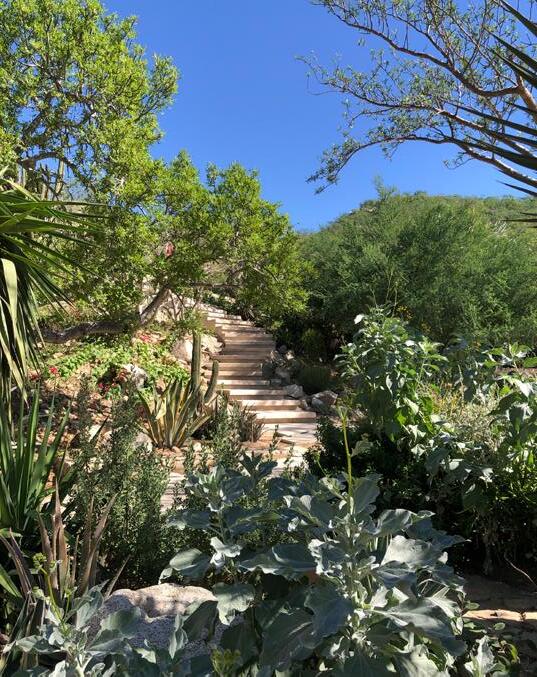
Los Agaves se convirtió en la excepción al paisaje del resort, rodeado de cerros, se encuentra escondido en un nicho que consiste en un escenario, una pista de baile, un bar, un área de ceremonia, espacios de lounge, baños y un edificio con cocina totalmente equipada para los banquetes. Abrió sus puertas al primer evento a mediados de octubre de 2023 y continuará siendo hogar de muchas historias de amor por venir.
Flowers have been a substantial element in the celebrations of love and union for many people at Los Agaves de Acre, as these are not just an ornament in gardens, they are an essential part of the reproduction of all angiosperm species, providing food and a home for thousands of insects, birds, and some mammals. Flowers are the seductive verb of plants, and we are fortunate to understand it.

Los Agaves became the exception to the resort landscape, surrounded by hills; it is hidden in a niche, consisting of a stage, a dance floor, a bar, a ceremony area, lounge spaces, bathrooms, and a fully equipped kitchen building for banquets. It opened its doors to the first event in mid-October 2023 and will continue to be the home of many love stories to come.
INTERVENTIONS 59 INTERVENCIONES 58
Flores que hablan: Los Agaves de Acre Resort
Flowers that speak: Los Agaves at Acre Resort
Escaleras al cuarto de novia Stairs to the bride´s bedroom
Fotografía / Photography: Celine Leleu
Área de lounge Lounge area
Fotografía Photography: Celine Leleu
Parque Lineal Linear park
Por / By: Atelier Loos van Vliet + Bureau B+B + Jacqueline van der Kloet
El Blaricummermeent es una nueva área residencial con aproximadamente 1100 casas en Blaricum, Holanda. La vegetación se concentra en un parque lineal que se extiende a lo largo del nuevo río, el cual se inspira en una ramificación del río Eem que probablemente haya pasado por aquí siglos atrás. El parque de 2.5 kilómetros conecta la vegetación existente del barrio de Bijvanck con el área recreacional Voorland Stichtsebrug. El color de las plantas varía de tonos brillantes y cultivadas en el centro del parque, hasta plantaciones naturales de tonos amarillo-verdosos en el lago Gooimeer y el Bijvanck.
The Blaricummermeent is a new residential area with approximately 1100 houses in Blaricum Holland. The greenery is concentrated in a linear park that runs along the new river, which is inspired by a branch of the river Eem that must have run here centuries ago. The 2.5 kilometer long park connects the existing greenery of the Bijvanck neighborhood with the recreation area Voorland Stichtsebrug. The color of the plants ranges from cultivated bright in the middle of the park to natural yellow-green at the lake Gooimeer and the Bijvanck.




Los bancos de juncos a lo largo del río sirven como una conexión ecológica con los bancos naturales del Gooimeer. Se añadió una mezcla de plantas acuáticas para dar lugar al mejoramiento de la calidad del agua. El parque se ubica en la parte Este del río, y es accesible para todos. El diseño de plantas perennes y gramíneas es muy especial, así como varios hermosos árboles solitarios del parque. Solo se seleccionaron plantas con nivel de mantenimiento bajo. La poda es necesaria una vez al año, durante la primavera. El esquema de plantación se basa en 30 mezclas de plantas diferentes, cada una compuesta por alrededor de 4 plantas. Éstas mezclas de plantas fueron seleccionadas de tal manera que cada estación tenga su propia personalidad atractiva, con follaje contrastante. La plantación promueve la biodiversidad, lo que atrae a muchas abejas y mariposas.
The reed banks along the river serve as an ecological connection with the natural banks of the Gooimeer. A mix of water plants has been added, to allow for further improvement of the water quality. The park is located on the East side of the river, and it is made accessible to everyone. The layout of perennials and grasses is very special, as well as a number of beautiful solitary park trees. Only plants with a low maintenance-level were selected. Mowing is required only once a year, during spring. The plant scheme is based on 30 different plant mixes, each mix consists of about 4 plants. These plant mixes were selected in such a way that each season has its own attractive personality, with contrasting foliage. The plantation promotes biodiversity, which attracts many bees and butterflies.
INTERVENTIONS 61 INTERVENCIONES
Puente detrás de las flores Bridge behind flowers Fotografía / Photography: Martine Van Vliet
Linear park
Flores incrementando la biodiversidad Flowers increasing biodiversity
Fotografía Photography: Martine Van Vliet
Cama de flores / Flower beds
Fotografía / Photography: Martine Van Vliet
Mezcla de flores amarillas / Yellow plant mix
Fotografía / Photography: Martine Van Vliet
El mobiliario e iluminación es modesto y combinan entre sí. Los caminos, hechos de concreto ornamental, son adecuados para patinadores así como para personas con alguna discapacidad. El centro del parque posee un jardín de recolección de flores colectivo, donde las hermosas formas orgánicas están bordeadas por una barda de acero corten. Las plantas fueron seleccionadas por la forma vibrante en la que florecen y su período de floración es variable. Recoger flores en el jardín está permitido para todos.
“Las
plantas fueron seleccionadas
The furniture and lighting is modest and matching. The paths, made of ornamental concrete, are suitable for skateboarders and rollerbladers as well as for persons with disabilities. The center of the park holds a public picking garden, where the beautiful organic shapes are bordered by corten steel barriers. The plants were selected for the vibrant ways in which they blossom and all have a varying flowering period. Picking flowers in the garden is allowed for everyone.
por la forma vibrante en la que florecen. Recoger flores en el jardín está permitido para todos.”


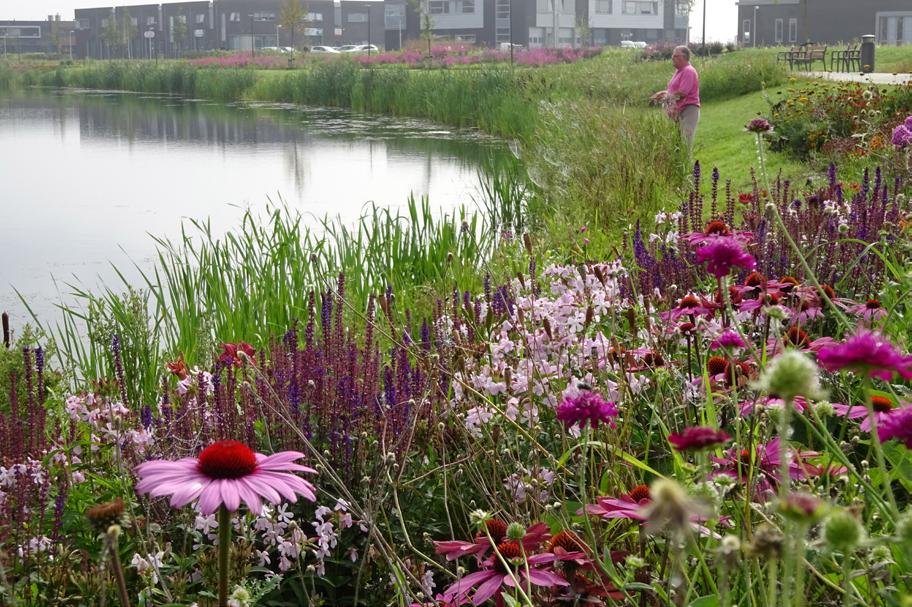
“The
plants were selected for the vibrant ways in which they blossom. Picking flowers in the garden is allowed for everyone.”
Para mejorar aún más la función pública del parque, se diseñaron dos espacios diferentes para actividades deportivas. Un pequeño campo de fútbol con dos porterías y un área de fitness al aire libre con una variedad de máquinas, ambos pueden ser utilizados por los visitantes. Los puentes en El Blaricummermeent también fueron diseñados por Atelier Loos van Vliet. Se prestó mucha atención al desarrollo de los elementos de la cerca, pues todos pertenecen a la misma familia de plantas y se consideran una extensión de los setos a lo largo de las carreteras de la estructura principal. La cerca del puente está diseñada como un seto artificial, hecho de acero recubierto. Consisten en tres elementos diferentes que pueden ser utilizados de manera intercambiable para cada puente. Esto permite una variedad en la apariencia, y además, estos elementos orgánicos guían al peatón mientras cruza el río.
To further accommodate the public function of the park, two different spots for sport activities have been designed. A small soccer field with two goals and an outdoor fitness area with a variety of machines, both can be used by visitors.
The bridges in The Blaricummermeent were designed by Atelier Loos van Vliet as well. A lot of attention has gone into the development of the elements of the fence, as they all belong to the same family of plants and are to be seen as an extension of the hedges along the roads of the main structure. The bridge fence is designed as an artificial hedge, made from coated steel. They consist of three different elements, which can be used in an interchangeable way for each bridge. This allows for a variety in appearance; these organic elements guide the pedestrian while crossing the river.
INTERVENTIONS 63 INTERVENCIONES 62
Parque Lineal Parque en uso / Park in use Fotografía Photography Martine van Vliet Equipamiento deportivo / Sport equipment Fotografía / Photography Martine Van Vliet
Linear park
Flores a lo largo del agua / Flowers along the water Fotografía / Photography Martine Van Vliet
¿Cómo hacer un bucket de flores?
How to make a flower bouquet?
Por / By Angie Espadas / The Flowner
Me encantan las flores, lo diferentes que son y lo mucho que podemos hacer con ellas. Desde transmitir una emoción, cambiar la forma de un espacio, hasta acompañarnos en los momentos más memorables de nuestra vida. Este proyecto floral surge unos años después de crear Cuarto de Rosas, mi florería o como me gusta llamarla tienda de detalles.
Creé este espacio porque me encanta compartir mis experiencias en talleres, dando tips en la florería con los aciertos y enseñanzas, los paisajes hermosos en eventos destinos, y los espacios bonitos que llenamos de flores; también todo aquello que me inspira y me hace ser lo que hoy soy.
Afortunadamente muchos de mis clientes, me hacen este comentario en varias ocasiones: “oye Angie, tus flores siempre me duran más”, por lo que siempre les comento que el secreto está en la hidratación. La cámara de los secretos ha sido abierta y hoy vengo a contarles cómo hacer que tus flores duren más:
I love flowers, how different they are and how much we can do with them. From transmitting an emotion, changing the shape of a space, to accompanying us in the most memorable moments of our life. This floral project arose a few years after creating Cuarto de Rosas, my flower shop or as I like to call it a detail store. I created this space because I love sharing my experiences in workshops, giving tips in the flower shop with the achievements and lessons, the beautiful landscapes in destination events, and the charming spaces that we fill with flowers; also everything that inspires me and makes me who I am today.
Fortunately, many of my clients make this comment to me on several occasions: “hey Angie, your flowers always last longer”, so I always tell them that the secret is in hydration. The chamber of secrets has been opened and today I come to tell you how to make your flowers last longer:

64 LABORATORIO
Selección de flores / Selection of flowers Fotografía / Photography: Cuarto de Rosas
Hidratación:
• Es importante comprarlas los días que llegan al proveedor. Para confirmar que están frescas puedes voltearlas y observar su tallo, debe estar verde y limpio, si huele feo o está gris o baboso no agarres esas flores. Si vas a comprar rosas fíjate que el centro de la rosa esté duro, firme, y no tenga rastros de hongo.
•
• Nunca las dejes en el coche o en un cuarto muy caluroso, exponerlas al calor muy fuerte hará que se marchiten de inmediato, además recuerda que están saliendo de una cámara fría donde estaban a temperaturas bastante bajas, el shock del cambio las pone muy mal.
•
• Apenas llegues a tu casa o estudio, vas a realizarles un corte en diagonal de unos 3 cm al tallo (o que se ajuste a la medida de tu jarrón), y muy importante, limpiar los tallos para que no tengan hojas o residuos que puedan tocar el agua. Esto evitará que tu agua se pudra o ensucie más rápido.
•
• Es esencial que cambies el agua diario, eso es 100% efectivo si quieres que te duren más, y mis tips más privados son: no tienes que llenar todo tu jarrón, solo fijarte que todos los tallos toquen el agua unos 3 cm; no les des alimento para flores (aquí en Mérida el calor ya hace que maduren mucho más rápido, solo reducirá su tiempo de vida), si quieres ayudarlas, ponles unos 3 hielos diario en la base… te lo agradecerán.
Hydration:
• It is important to buy them on the days they arrive at the supplier. To confirm that they are fresh you can turn them over and look at their stem, it should be green and clean, if it smells bad or is gray or slimy, don't grab those flowers. If you are going to buy roses, make sure the center of the rose is hard, firm, and has no traces of fungus.
•
• Never leave them in the car or in a very hot room, exposing them to very strong heat will make them wither immediately, also remember that they are leaving a cold room where they were at quite low temperatures, the shock of the change makes them very sick.
•
• As soon as you arrive at your home or studio, you are going to make a diagonal cut of about 3 cm to the stem (or one that fits the size of your vase), and very important, clean the stems so that they do not have leaves or residues that could touch the water. This will prevent your water from rotting or getting dirty faster.
•
• It is essential to change the water daily, that is 100% effective if you want them to last longer, and my most private tips are: you do not have to fill your entire vase, just make sure that all the stems touch the water about 3 cm; Do not give them food for flowers (here in Merida the heat already makes them mature much faster, it will only reduce their lifespan), if you want to help them, put about 3 ice cubes a day at the base... they will thank you.
Nota: La aspirina realmente no funciona, el secreto es tener el agua muy limpia. Un pequeño chorro de cloro puede ayudarte a que no se pudra tan rápido.
Note: Aspirin doesn't really work, the secret is to have very clean water. A small splash of bleach can help prevent it from rotting quickly.

Cómo hacer un ramo y no morir en el intento Hoy te voy a contar mi forma favorita de hacerlos, que se llama en espiral. Antes de iniciar te recomiendo una mesa despejada, sin cosas que puedas ensuciar o que te estorben en este proceso creativo. Ten tus flores ya con los tallos limpios, sin hojas o basuritas y acomodadas por variedades (si las hay).
Escoger una base:
• El tamaño va a depender de la boca de la base, para definir cuantos tallos le caben. Yo te recomiendo tener una de unos 10-15 cm. Empezamos colocando el primer tallo en diagonal, el segundo cruzado formando una X, luego el tercero justo en medio y posteriormente, los demás vamos a ir colocándolos siguiendo las manecillas del reloj.
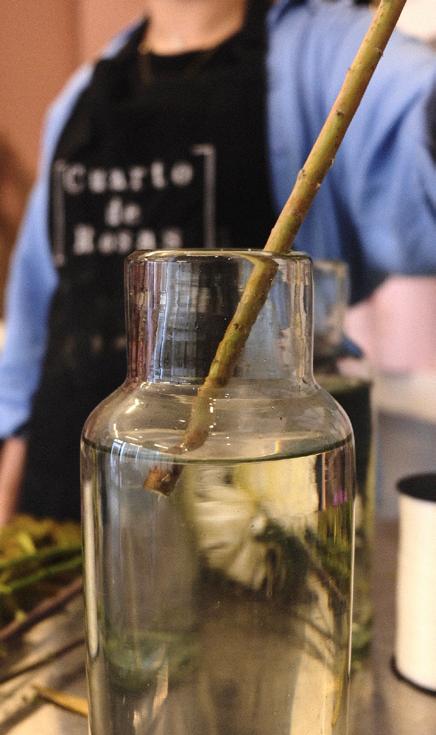
How to make a bouquet and not die trying Today I'm going to tell you my favorite way to make them, which is called spiral. Before starting, I recommend a clear table, without things that can get dirty or that will hinder you in this creative process. Have your flowers already with clean stems, without leaves or debris and arranged by variety (if there are any).
Choosing a Base:
• The size will depend on the mouth of the base, to determine how many stems it can hold. I recommend having one about 10-15 cm wide. We start by placing the first stem diagonally, the second one crossed to form an X, then the third right in the middle, and subsequently, we will place the others following clockwise.
66 LABORATORIO 67 THE LAB ¿Cómo hacer un bucket de flores?
How to make a flower bouquet?
Corte de tallos en diagonal Diagonal stem cutting Fotografía / Photography: Cuarto de Rosas
Tallos limpios al momento de hidratar Diagonal stem cutting Fotografía Photography: Cuarto de Rosas
Observar:
• No te sientas presionado, lo hermoso de las flores es que puedes sacar tu lado más creativo, y el diseño floral es un arte 100% de observación, ve fijándote para que lado se ve más bonita cada variedad de flores, cuáles tienen una ligera caída, o una altura que vale la pena aprovechar.
Colocar:
• Ponlas en tu espacio preferido, yo te recomiendo lejos de una ventana o frutas. Definitivamente no abajo de un abanico.
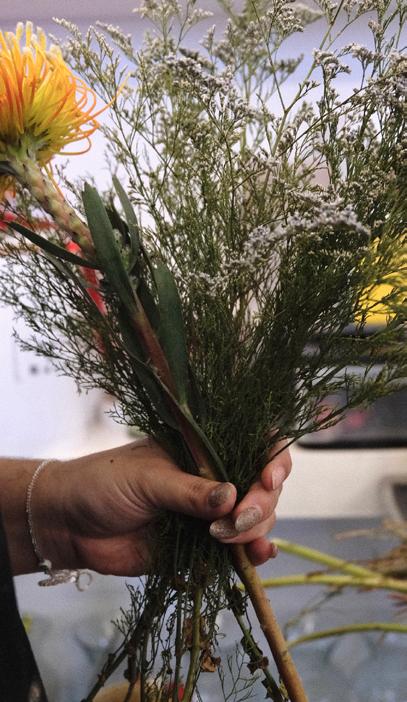
Es verdad que tener flores en tu espacio va a mejorar tus días notablemente. Haz la prueba y me cuentas cuál fue tu experiencia. Con mucho cariño, esperando llenar tu espacio con flores- Angie.
Observe:
• Don't feel pressured, the beautiful thing about flowers is that you can bring out your most creative side, and floral design is a 100% art of observation, pay attention to which side each variety of flowers looks prettier, which ones have a slight fall, or a height worth taking advantage of.
To place:
• Put them in your favorite space, I recommend away from a window or fruit. Definitely not under a fan.

It is true that having flowers in your space will significantly improve your days. Give it a try and tell me what your experience was. With love, hoping to fill your space with flowers- Angie.

68 LABORATORIO
¿Cómo hacer un bucket de flores?
Elaboración de ramo en espiral Spiral bouquet arrangement
Fotografía / Photography: Cuarto de Rosas
Hidratación de flores Flower hydration
Fotografía / Photography: Cuarto de Rosas
Plantas con flor para atraer polinizadores: Síndromes de polinización
Flowering plants to attract pollinators: Pollination syndromes
Por / By Dra. Amaranta Arellano Rivas y Alejandra Roldán Villegas

Las plantas con flor, en su mayoría requieren de visitantes que sean capaces de transportar su material genético. Para ésto han diseñado estrategias que sirven como señales y/o recompensas para lo polinizadores, éstas pueden estar relacionadas a la producción de néctar (cantidad y horario), aroma, el color y la forma de la corola, horario y época de la apertura de las flores, entre otras (Goluvob y Mandujano, 2009).
El polinizador es el animal que se encarga de transportar el polen desde el órgano masculino de una flor al órgano femenino de otra, una vez que se alimentó o tuvo interacción con el mismo.
Flowering plants, most of the time, require visitors capable of transporting their genetic material. To achieve this they have design strategies that serve as signals and/or rewards for the pollinators, which can be related to the production of nectar (quantity and schedule), scent, color and shape of the corolla, schedule and season of flower blooming, among others (Goluvob y Mandujano, 2009).
The pollinator is the animal responsible for transporting pollen from the male organ of one flower to the female organ of another, once it has fed or interacted with it.
Relación y coevolución de los polinizadores y las flores: Síndromes de polinización
Quiropterofilia (murciélagos y flores): Las flores que atraen a los murciélagos nectarívoros abren sus pétalos por la noche, coincidiendo con el mismo tiempo que estos mamíferos salen a buscar su alimento. Ese tipo de flores desprenden olores fuertes de azufre, dulce y humedad, presentan coloraciones blancas, verdes, amarillas y moradas, así como profundas corolas tubulares que en su fondo almacenan néctar que es accesible a la delgada y alargada lengua que presentan estos mamíferos. El pelaje del murciélago en cara, cuerpo y alas permiten que el polen se quede pegado a ellos.

The relationship and coevolution of pollinators and flowers: Pollination syndrome
Chiropterophily (bats and flowers): Flowers that attract nectar-feeding bats open their petals at night, aligning with the time when these mammals actively seek food. These kinds of flowers emit strong scents of sulfur, sweet and moisture, display white, green, yellow, and purple colors, and have deep tubular corollas that store nectar at the bottom. This nectar is accessible to the thin and elongated tongues of bats. The bat's fur on its face, body, and wings allows pollen to adhere to them during feeding, facilitating pollination.

PLANTAE & FAUNA 71 PLANTAE Y FAUNA 70
Be(e) flower !
Fotografía / Photography: Adriana Mosele
Flowering plants to attract pollinators: Pollination syndromes
Flor semiabierta del género Hylocereus
Semi-open flower of the genus Hylocereus
Fotografía / Photography: Amaranta Arellano Rivas
Espectacularidad de la noche del árbol maya
Spectacularity of the Mayan tree night
Fotografía / Photography: Henry Fernando Dzul Cauich
Ornitofilia (aves y flores): Gracias al pico que poseen las aves, eligen polinizar flores con forma de tubo prolongado o embudo, pues el contacto con el polen y beber el néctar que se encuentra en las profundidades se vuelve una tarea fácil. Por otra parte, el polen además de transportarse en el pico, también se transporta en las alas de las aves, ya que mientras beben néctar de la flor realizan aleteo. Otro rasgo importante de las aves es que algunas perciben colores no espectrales, eligiendo esencialmente aquellas flores de colores violeta, rojo, rosa, naranja y amarillo.
Melitofilia (abejas, avispas, hormigas y flores): Para las abejas, el polen es visible bajo colores UV (colores en los que se basa su visión), favoreciendo la identificación del mismo en sus flores preferidas de color amarillo, blanco, rosa/lila y azul, con un aroma fresco. Se distinguen por ser pequeñas, tubulares, cóncavas o en forma de plato que les permita aterrizar y acceder al néctar en profundidad. Las flores visitadas por las hormigas normalmente se encuentran cercanas entre sí para facilitar el transporte rápido del polen, y al igual que las abejas, algunas llegan a tener pelos sensoriales en el que se adhiere el polen. En cuanto a las avispas, su atracción se basa en el olor del proceso de fermentación del néctar.
Ornithophily (birds and flowers): Thanks to the beak that birds possess, they choose to pollinate flowers with a prolonged tube or funnel shape, as the contact with the pollen and drinking the nectar found in the depths becomes an easy task. Additionally, besides being transported on the beak, pollen is also carried on the wings of birds, as they flutter while sipping nectar from the flower. Another important trait of birds is that some perceive non-spectral colors, essentially choosing flowers of violet, red, pink, orange, and yellow hues.

nectar and moving its wings

Melittophily (bees, wasps, ants, and flowers): For bees, pollen is visible under UV light (colors based on their vision), favoring its identification on their preferred flowers in colors like yellow, white, pink/purple, and blue, often with a fresh aroma. These flowers are typically small, tubular, concave, or plate-shaped, allowing bees to land on them and access the nectar deep within. Ant-visited flowers are usually close together to facilitate the quick transport of pollen. Similar to bees, some ants have sensory hairs on which pollen adheres. As for wasps, their attraction is based on the scent of the nectar fermentation process.
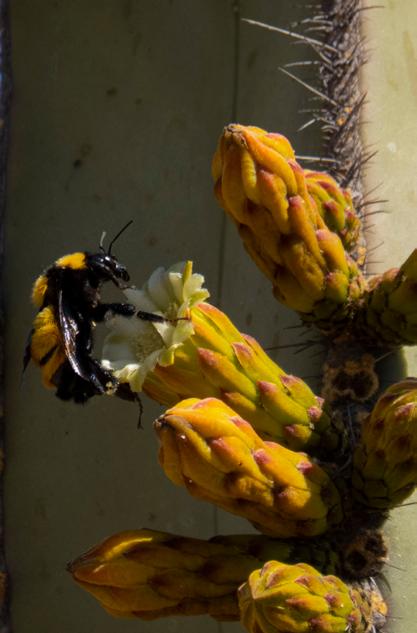
Polinizadores en Pachycereus
Pollinators in Pachycereus
Fotografía

Cantarofilia (escarabajos y flores): Las especies florales que los escarabajos eligen para polinizar pueden ser grandes o pequeñas, pero el color es generalmente blanco. Estas desprenden olores frutales dulces o florales. Según la revista Ciencia y Luz de la Universidad Veracruzana, las aráceas son flores que durante la noche abren sus pétalos, otorgan calor a través de su espádice y desprenden aromas para que los escarabajos pasen diversos días en ellas alimentándose y apareándose. Mientras esto ocurre, el polen se adhiere a su cuerpo, para que al salir de ahí lo transporten a otra flor. (Aguilar y Díaz, 2018)
Psicofilia (mariposas y flores): En este síndrome, las mariposas son atraídas por los colores y aromas de las flores, en las cuales, el polen se pega a las alas, patas y cuerpo de estos insectos. A cambio del servicio del polinizador, la flor lo recompensa con néctar, el cual es consumido mediante la probóscide debido a que, en su mayoría, estas flores tienen corola tubular muy alargada. Por otra parte, las mariposas diurnas tienen mayor afinidad por flores de colores vibrantes, y las nocturnas por flores de colores claros y más aromáticas.
Cantharophily (beetles and flowers): The floral species that beetles choose to pollinate can be large or small, but the color is generally white. These flowers emit sweet fruity or floral scents. According to the Ciencia y Luz magazine of the Universidad Veracruzana, arum lilies are flowers that open their petals at night, providing warmth through their spadix and emitting aromas to attract beetles. These insects spend several days on these flowers, feeding and mating. During this process, pollen adheres to their bodies, allowing them to transport it to another flower when they leave (Aguilar and Díaz, 2018).
Psychophily (butterflies and flowers): In this syndrome, butterflies are attracted to the colors and scents of flowers, where pollen adheres to their wings, legs, and bodies. In exchange for the pollination service, the flower rewards them with nectar, which is consumed using the proboscis, as many of these flowers have a very elongated tubular corolla. Additionally, diurnal butterflies show a greater affinity for flowers with vibrant colors, while nocturnal butterflies prefer flowers with lighter colors and more aromatic scents.
PLANTAE & FAUNA 73 PLANTAE Y FAUNA 72
Plantas con flor para atraer polinizadores: Síndromes de polinización
Colibrí bebiendo néctar y moviendo sus alas
Hummingbird drinking
Fotografía / Photography: Jeffrey Eisen vía Pexels
/ Photography: Johanna Meza Hernández
Flowering plants to attract pollinators: Pollination syndromes
Flor de la familia Araceae Flower of the Araceae family
Fotografía / Photography: Vía pxhere-CC0 Dominio público
Flores de corola tubular de la especie Plumbago auriculata
Tubular corolla flowers of the species Plumbago auriculata
Fotografía / Photography: Amaranta Arellano Rivas
Sapromiofilia (moscas y flores): Los insectos que representan a este síndrome de polinización son las moscas, debido a la afinidad que tienen por flores de aroma desagradable, muy similar a material orgánico en proceso de descomposición, carroña y estiércol (Proctor et al., 1996). La atracción de las moscas a sitios que semejan lugares de cría y alimento es un síndrome de polinización por engaño (Grajales–Conesa et al., 2011).
Sapromyophily (flies and flowers): The insects that represent this pollination syndrome are flies, due to their affinity for flowers with an unpleasant odor, closely resembling organic material in the process of decomposition, carrion, and dung (Proctor et al., 1996). The attraction of flies to sites that resemble breeding and feeding grounds is a deception pollination syndrome (Grajales–Conesa et al., 2011).

“Los polinizadores favorecen a la reproducción de flores y semillas, produciendo alimento para especies animales, entre ellas el ser humano.”
La polinización es importante para la biodiversidad ya que favorece la fecundación cruzada generando variabilidad genética dando origen a organismos resistentes a plagas y/o enfermedades, produciendo flores y semillas que otorgan alimentos a especies animales, entre ellas el ser humano.
Pollination is important for biodiversity since it promotes cross-fertilization, generating genetic variability that gives rise to organisms resistant to pests and/or diseases. This process produces flowers and seeds that provide food for animal species, including humans.
“Pollinators promote the reproduction of flowers and seeds, producing food for animal species, including humans.”
Flowering plants to attract pollinators: Pollination syndromes

Abeja acercándote a flores tubulares de una Compositae
Bee approaching tubular flowers of a Compositae
Fotografía / Photography: David Clode vía Unsplash
LITERATURA CONSULTADA / REFERENCES:
Aguilar, Pedro, Díaz, Pedro. “ESTRATEGIAS DE POLINIZACIÓN DE LAS ARÁCEAS” Ciencia y Luz 5 de junio de 2018. https://www.uv.mx/cienciauv/files/2018/06/18-CYL-ARACEAS-00.pdf
Dirección General de Recursos Naturales y Bioseguridad. “¿Qué son los polinizadores?” Consultado el 7 de enero de 2024. https://www.gob.mx/semarnat%7Cpolinizadores/articulos/queson-los-polinizadores?idiom=es
Fallon, Candace. “Notes From The Other Orders: Beetles As Pollinators.”
Consultado el 7 de enero de 2024. https://www.xerces.org/blog/notes-from-other-orders-beetles-as-pollinators
Generación verde. “Síndromes de polinización.” Consultado el 7 de enero de 2024. https://generacionverde.com/blog/cultivos/sindromes-de-polinizacion/
Goluvob J. y M. C. Mandujano. 2009. ¿Por qué los polinizadores visitan a las flores?. Revista bimestral Casa del Tiempo, 21: 39-41.
Grajales–Conesa, J., Meléndez–Ramírez, V. y Leopoldo Cruz–López. 2011. Aromas florales y su interacción con los insectos polinizadores. Rev. Mex. Biodiv. vol. 82 no. 4. México. Jiménez-Sierra, Cecili, Matías-Palafox María. “Cuando el amor domina en las relaciones entre individuos de distintas especies: polinizadores y sus flores preferidas"Revista Digital Universitaria 13, no. 7 (julio 2012): 3-11. https://www.revista.unam.mx/vol.13/num7/art71/art71.pdf
López, Margarita, Deloya, Cuauhtémoc. “Escarabajos: Los buenos somos más.” Consultado el 7 de enero de 2024. https://www.inecol.mx/inecol/index.php/es/2013-06-05-10-34-10/17-cienciahoy/932-escarabajos-los-buenos-somos-mas
Proctor, M., P. Yeo y A. Lack. 1996. The natural history of pollination. Harper Collins, London. 479 p.
Revista de divulgación científica y tecnológica de la Universidad Autónoma de Nuevo León. “La labor polinizadora de los murciélagos” Consultado el 7 de enero de 2024. https://cienciauanl. uanl.mx/?p=9804
Sánchez, Xiumy, Figueroa, Dulce. “Amos de la noche: la polinización por murciélagos” Elementos 129, (2023): 25-29 https://elementos.buap.mx/directus/storage/uploads/00000008136.pdf
United States Department of Agriculture. “Pollinator Syndromes.” Consultado el 7 de enero de 2024. https://www.fs.usda.gov/wildflowers/pollinators/What_is_Pollination/syndromes.shtml
United States Department of Agriculture. “Bee Pollination.” Consultado el 7 de enero de 2024. https://www.fs.usda.gov/wildflowers/pollinators/animals/bees.shtml
PLANTAE & FAUNA 75 PLANTAE Y FAUNA 74
Plantas con flor para atraer polinizadores: Síndromes de polinización
Flor de la especie Aristolochia littoralis Flower of the species Aristolochia littoralis
Fotografía / Photography: Hans Hillewaert, CC BY-SA 3.0, creativecommons.org vía Wikimedia Commons
Plantas que cambian el paisaje con su floración Plants that change the landscape with their blossoming
Por / By : Armando Maravilla y Felipe Macías
Los paisajes experimentan transformaciones a lo largo del tiempo, y uno de los aspectos más notables es el cambio de estación. Entre los elementos más llamativos se encuentran las flores, que visten distintos lugares. Estas pueden extenderse por amplias áreas, añadiendo color a zonas que en otras temporadas lucen ocres o verdes. La diversidad de especies en los diferentes ecosistemas propicia una explosión de color que, en algunos lugares, llega a cubrir casi por completo el paisaje.
Over time landscapes experiment transformations, and one of the more notable aspects is the change of season. Among the most striking elements are the flowers, which embellish different places. They can spread across extensive areas, adding color to zones that in other seasons appear in shades of ochre or green. The diversity of species in different ecosystems raises an explosion of color that in some places covers most of the landscape.


(Tagetes lunulata)
Familia / Family: Asteraceae
Crece entre 30 a 80 cm. It grows between 30 to 80 cm.
CARACTERÍSTICAS / FEATURES
Opuestas o a veces alternas, hasta 8 cm de largo, compuestas por 9 a 23 foliolos (pequeñas hojitas) muy angostos, de hasta 2 cm de largo con dientes puntiagudos en el margen.
Opposite or sometimes alternate leaves, up to 8 cm long, composed of 9 to 23 very narrow leaflets (small leaves), up to 2 cm long with pointed teeth on the margin.
Aquenio (fruto seco con una sola semilla) linear, de 7-9 mm de largo con pelillos. Achene (dry fruit with a single seed) linear, 7-9 mm long with hairs.
Inflorescencias con cabezuelas de hasta 10 cm de largo, formadas por dos tipos de flores: liguladas, generalmente con corola ovada a obovada, de 7-10 mm de largo, de color amarillo o anaranjado y las del disco de 20-40 mm, corola amarilla, de 6-8 mm de largo.
Inflorescences with heads up to 10 cm long, formed by two types of flowers: Ligulate, generally with ovate to obovate corolla, 7-10 mm long, yellow or orange in color and those with the disc of 20-40 mm, yellow corolla, 6-8 mm long.
Florece de agosto a diciembre.
Blooms from August to December.
Tallo ramificado, a menudo rojizo o morado.
Branched stem, o ten reddish or purple.
Raíz cilíndrica y pivotante.
Cylindrical and pivoting root.
HÁBITAT / HABITAT
Vegetación secundaria en bosque de pino-encino y bosque tropical caducifolio. Presente en si t ios de disturbio, a veces ruderal a lo largo de vías de comunicación.
Secondary vegeta t ion in pine-oak forest and tropical deciduous forest. Present in places of disturbance, some t imes ruderal along roadways.
RECOMENDACIONES / RECOMMENDATIONS:
Ideal para cubrir áreas extensas formando tapetes de color, son áromaticas y resisten muy bien la sequía.
Ideal for covering large areas forming mats of color, they are aromatic and resist drought very well.
LITERATURA CONSULTADA / REFERENCES:
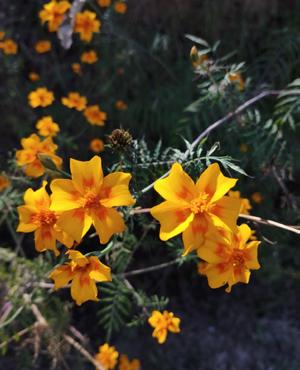



/ DISTRIBUTION
Hanan, Ana María, Mondragón, Juan, Vibrans, Heike. 2009. Malezas de México Asteraceae = Compositae Tagetes lunulata Ort. Flor de muerto. Malezas de México. http://www.conabio.gob.mx/malezasdemexico/asteraceae/tagetes-lunulata/fichas/ficha.htm Villareal, J. 2003. Flora del bajío y de regiones adyacentes. Compositae, Tribu Tagetae. Universidad Autónoma Agraria Antonio Narro Buenavista, Saltillo, Coahuila. http://inecolbajio.inecol.mx/floradelbajio/documentos/fasciculos/ordinarios/Compositae-Tageteae%20113.pdf
PLANTAE & FAUNA 77 PLANTAE Y FAUNA
CC BY 3.0 <https://creativecommons.org/licenses/by/3.0>, via Wikimedia Commons
Mirabilis Jalapa Fotografía / Photography:
C T
Johansson,
Plants that change the landscape with their blossoming
Fotografía / Photography: Arath Macías
CINCO LLAGAS / RED-CRESCENT MARIGOLD
BOCETO / SKETCH Ilustración / Illustration: Stephanie Lagunas
DISTRIBUCIÓN
Mapa / Map Esaúl Hernández Rodríguez
Fotografía / Photography: H.Zell, CC, vía Wikimedia Commons
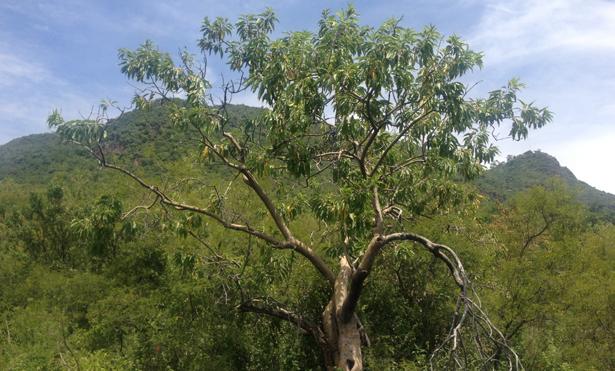

CAZAHUATE / PURPLE BINDWEED
(Ipomoea murucoides)
Familia / Family: Convolvulaceae
Crece de 3 a 13 metros.
It grows from 3 to 13 meters.
Hojas de 9-20 cm, elípticas a lineares, de pubescentes a vellosas, con las bases de las hojas truncadas y ápices con terminación en punta aguda (acuminados).
Its leaves are from 9-20 cm, elliptical to linear, pubescent to hairy, with truncated leaf bases and acute-tipped (acuminate) apices.
Fruto simple, seco, en forma de campana que abre al madurar, ovoide (con forma de huevo) de 1.8-2.5 cm de longitud por 1.5-2 cm de diámetro, de coloraciones café.
Its fruit is simple, dry, bell-shaped that opens when ripe, ovoid (egg-shaped) 1.8-2.5 cm in length by 1.5-2 cm in diameter, brown in color.
In lorescencias monocasiales (con una flor terminal y solo una lateral), flores solitarias, ocasionalmente en pares. Sépalos (cáliz) desiguales, con abundantes pelos por fuera y por dentro, corola infundibuliforme (en forma de embudo) de 6-8 cm de longitud y hasta 8 cm de diámetro, blanca, a veces rojo o purpúrea en la garganta.
Monochasial in f lorescences (with one terminal and only one lateral f lower), solitary f lowers, occasionally in pairs. Sepals (calyx) are unequal, with abundant hairs outside and inside, funnel-shaped corolla 6-8 cm in length and up to 8 cm in diameter, white, some t imes red or purple on the throat.
Florece en temporada seca de octubre a marzo. It blooms in the dry season from October to March.
Raíces bulbosas. Bulbous roots.
HÁBITAT / HABITAT
Selva Baja Caducifolia, actualmente muy presente en grandes ciudades como la Ciudad de México.
Deciduous lowland forest, currently very present in large cities such as Mexico City.
RECOMENDACIONES / RECOMMENDATIONS:
Tolera muy bien la sequía, se recomienda para conformar bosquetes o como elemento puntual en plazas y jardines.
Tolerates drought very well, it is recommended to form groves or as a specific element in squares and gardens.
LITERATURA CONSULTADA / REFERENCES:


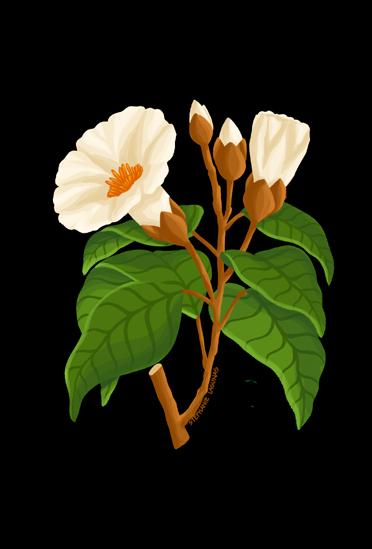

DISTRIBUCIÓN / DISTRIBUTION
Mapa / Map Esaúl Hernández Rodríguez

M ARAV I LLA / F OUR O'CL O C K FLOWE R
( Mi ra bi lis jalapa
Fa m il i a / Family Nyctaginacea e
Crece de 60 a 150 cm
It grows from 60 to 150 cm
Posee hojas pecioladas, ovadas de 4-13 cm ápice agudo o atenuado, base redondeada o subcordada (como corazón) a veces pubescentes
Pe i o l ate some u pp e r l ea ves su b s e ssi l e ov at e, 4-1 3 cm ap ex ac u te or atte nu at e b as e ro u nd ed or s u bcordat e ( h e art - s h ape d som e i mes pu b escent
Aquenios (fruto seco con una única semilla) de contorno ovado a ampliamente ovado o elíp ico, textura verrucosa, de color uniforme o variegado, café
Achenes (d r y fruit with a single seed) with an ovate to broad ly ovate or elli p ical out l in e, a wart y t ex t u r e a nd a uni form or v ari e gat e d b r ow n co or .
Flores con forma de trompeta, alargadas y abiertas de color rojo, rosa, amarillo o blanco. Hay plantas que parecen quimeras, con varios colores en la misma planta
Trumpet-shaped l owers, elongated and open, in red, pink, yell ow or white co ors. There are plants that look like chimeras, with various colors on t he same p l ant
Florece a finales del verano y en otoño. En algunas zonas de Veracruz lorece prác icamente todo el año
It blooms in late summer and autumn In some areas of Veracruz it b ooms prac ically al year round
Muy ramificado con las ramas erectas o ascendentes
Ver y branched stem with erect or ascending branches
Raíz carnosa y gruesa
Fleshy and thick roots.
HÁ B I TA T / H ABITA T
Principalmente e n z o na s d e di s t u rbi o s, o t e s ba l d í o s , pa s za les y banq u e t as en la ciudad.
Ma i n ly in dist u rb ed ar e as , v aca n t ots , g rasslan d s a n d s i d e walks i n th e cit y
RECOMENDACIONES / RECOMMENDATIONS
Planta con gran potenc a ornamental de lores muy vistosas que cubren grandes áreas requieren mantenimiento mínimo ideales para jardines de temporada
Plant with great ornamenta poten a , w th very glamorous lowers that cover large areas requiring minimal maintenance, ideal for seasona gardens
Atlas de las Plantas de la Medicina Tradicional Mexicana. 2009. Ipomoea murucoides Roemer & Schuites Convolvulaceae. Biblioteca Digital de la Medicina Tradicional Mexicana. http://www.medicinatradicionalmexicana.unam.mx/apmtm/termino.php?l=3&t=ipomoea-murucoides Rojas, Sonia. Vibrans, Heike. 2011. Malezas de México Convolvulaceae Ipomoea murucoides Roem. & Schult. Cazahuate. Malezas de México. http://www.conabio.gob.mx/malezasdemexico/convolvulaceae/ipomoea-murucoides/fichas/ficha.htm
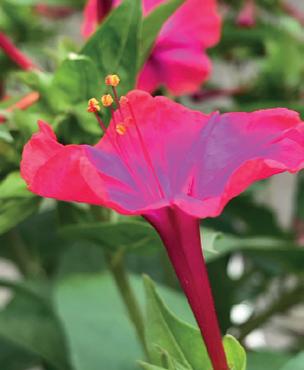



LITERATURA CONSULTADA / REFERENCES: Mirabilis jalapa L. Maravilla. Malezas de México. Mondragón, Sonia. Vibrans, Heike. 2009. Malezas de México Nyctaginaceae http://www.conabio.gob.mx/malezasdemexico/nyctaginaceae/mirabilis-jalapa/fichas/ficha.htm Spellenberg, Richard. 2001. Flora del bajío y de regiones adyacentes. Nyctaginaceae. Department of Biology New Mexico State University Las Cruces, New Mexico, E.U.A. http://inecolbajio.inecol.mx/floradelbajio/documentos/fasciculos/ordinarios/Nyctaginaceae%2093.pdf
PLANTAE & FAUNA 79 PLANTAE Y FAUNA 78
Ficha Técnica Plantae
Fotografía / Photograph Bodofzt, CC BY-SA 4.0, via Wikimedia Commons
CARACTERÍSTICAS / FEATURES
Fotografía / Photograph Arath Macías
Plantae Thechnical Sheet
Fotografía / Photography: Armando Maravilla
C AR AC T E RÍS T I C AS / FEATU R E S BO C ETO / S K ET C H I lus ra c ó n / I ll u s t r ation: S tep h an e Lagu n a s
DIS T RI BU C IÓ N / DISTRIBUTIO N Ma p a / M a p Esaúl Her n ánde z R o drígue z
Fotografía / Photography: Armando Maravilla
Polinizadores, los héroes sin capa de la naturaleza
Pollinators, nature's capeless heroes
Por / By : Fabiola Cardeña
El papel de los polinizadores dentro de los procesos ecológicos para la preservación y mantenimiento de los ecosistemas terrestres son de suma importancia, estos ayudan con la producción de alimentos y aumentan la biodiversidad de los ecosistemas, se sabe que entre el 60 y 80 % de las plantas con flores requieren de la polinización por animales para su reproducción (Kearns et al., 1998). Uno de los principales insectos polinizadores, si no es que el de mayor importancia por su arduo trabajo de polinización, son las especies de abejas en general. ,
The role of pollinators in ecological processes for the preservation and maintenance of terrestrial ecosystems is of utmost importance. They assist in food production and increase the biodiversity of ecosystems. It is known that between 60 and 80% of flowering plants require animal pollination for their reproduction (Kearns et al., 1998). One of the main pollinating insects, if not the most important due to their diligent pollination work, is the bee species in general.
“Uno de los principales insectos polinizadores, si no es que el de mayor importancia por su arduo trabajo de polinización, son las especies de abejas en general.”
“One of the main pollinating insects, if not the most important due to their diligent pollination work, is the bee species in general.”
Te invito a informarte sobre el gran papel que realizan los diferentes tipos de polinizadores en nuestra región (Yucatán, México) para conocer y comprender, pero sobre todo respetar y saber manejar nuestro entorno natural, el conocimiento es el generador de los grandes cambios en la historia, estamos a tiempo para dejar nuestro granito de arena y realizar algo significativo, si te preguntas: ¿Qué puedes hacer para ayudar a los polinizadores? Además de informarte, una gran opción es “volver a lo básico”.
I invite you to learn about the significant role played by various types of pollinators in our region (Yucatán, México) to know, understand, but above all respect and manage our natural environment, knowledge is the generator of the great changes in history, we have time to leave our mark and do something significant, if you ask yourself: What can you do to help the pollinators? In addition to informing you, a great option is “go back to basics”.

PLANTAE & FAUNA 81 PLANTAE Y FAUNA 80
Melipona beechei Fotografía / Photography: Melipona beecheii Flickr - gailhampshire CC-BY-2.0
Pollinators, nature's capeless heroes

ABEJA MELIPONA / MELIPONA BEE
Clase / Class: Insecta
DESCRIPCIÓN / DESCRIPTION
En general, resaltan su importancia desde t iempos precolombinos, y a diferencia de lo que se piensa, llevan una vida solitaria y no social como las típicas abejitas que conocemos. Se caracterizan por la ausencia de un aguijón funcional.
In general, they highlight their importance since pre-Columbian t imes, and unlike what is thought, they lead a solitary and non-social life like the typical little bees that we know. They are characterized by the absence of a func t ional s t inger.
HÁBITAT / HABITAT
Podemos encontrar más de 20 mil especies de abejas a nivel mundial, los científicos las han estudiado por muchos años llegando a clasificarlas en 7 grandes grupos. Existen aproximadamente 400 especies de meliponas en el Continente Americano, sin embargo, en México se conocen 46 especies de las cuales el 30.4 % son endémicas. En nuestra región destaca la abeja melipona (Melipona beecheii), por ser endémica del estado de Yucatán. Sus nidos los forman en orificios de troncos de árboles e incluso en los refugios abandonados de escarabajos o en guaridas vivas de termitas y hormigas.
We can find more than 20 thousand species of bees worldwide, scien t ists have studied them for many years, classifying them into 7 large groups. There are approximately 400 species of meliponas in the American Con t inent, however, in Mexico there are 46 species known, of which 30.4% are endemic. In our region, the Melipona bee (Melipona beecheii), stands out for being endemic to the state of Yucatán. They form their nests in holes in tree trunks and even in abandoned beetle shelters or in living lairs of termites and ants.
POLINIZADORES / POLLINATORS
Juegan un papel ecológico importante en la reproducción de plantas, son vitales para los sistemas de producción agrícolas como el del chile habanero y el tomate, además se conocen como polinizadores de plantas como el achiote, botoncillo, flamboyán, entre otras. En la actualidad, enfrentan riesgos como la contaminación por agroquímicos, el desplazamiento por introducción de especies como la abeja melífera (Apis mellifera), fragmentación de su habitat, el cambio climático, solo por mencionar algunos factores. They play an important ecological role in the reproduc t ion of plants, they are vital for agricultural produc t ion systems such as habanero chili and tomato, and are also known as pollinators of plants such as annatto, botoncillo, f lamboyán, among others. Currently, they face risks such as contamina t ion by agrochemicals, displacement due to the introduc t ion of species such as the honey bee (Apis mellifera), habitat fragmenta t ion and climate change, just to men t ion a few factors.
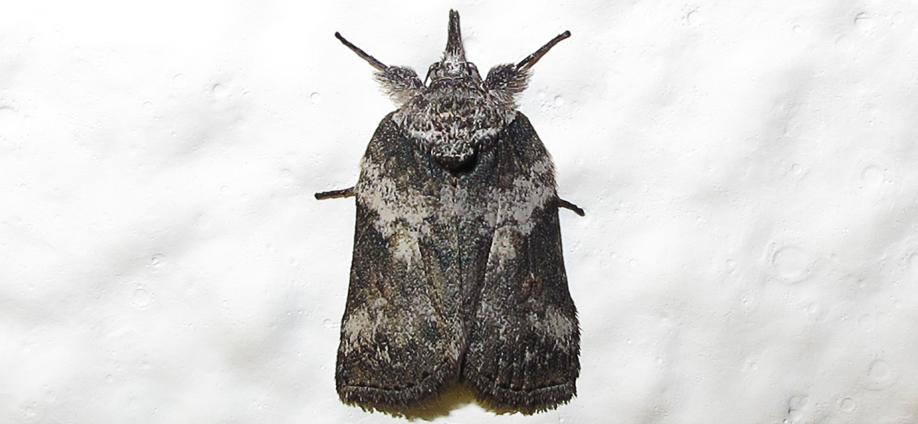
POLILLA / MOTH
DESCRIPCIÓN / DESCRIPTION
Este gran grupo de insectos también conocido como mariposas nocturnas, se encuentra rezagado respecto a su importancia como grandes polinizadores y como parte de la cadena trófica. Poseen escamas en sus alas y se dividen en cuatro grupos o subórdenes, en los cuales encontramos a las polillas con mandíbulas (Zeugloptera), polillas del kauri (Aglossata), polillas metálicas (Heterobathmiina) y polillas con lengua (Glossata).
This large group of insects, also known as night butter f lies, is lagging behind in its importance as large pollinators and as part of the food chain. They have scales on their wings and are divided into four groups or suborders, in which we find jaw moths (Zeugloptera), kauri moths (Aglossata), metal moths (Heterobathmiina) and tongue moths (Glossata).
HÁBITAT / HABITAT
Pueden encontrarse en una variedad de hábitats, desde selvas tropicales hasta áreas urbanas; adaptándose a las condiciones locales y a la disponibilidad de plantas hospederas donde depositan sus huevos, pues no construyen nidos. Estas especies poco comprendidas se ven afectadas por acciones humanas como la deforestación, pérdida del componente vegetal, mal uso de plaguicidas y los mitos a los que se les asocian. They can be found in a variety of habitats, from rainforests to urban areas; adap t ing to local condi t ions and the availability of host plants where they lay their eggs, since they do not build nests. These poorly understood species are a f fected by human ac t ions such as deforesta t ion, loss of the vegetal component, misuse of pes t icides and the myths to which they are associated.
POLINIZADORES / POLLINATORS
Se encuentran muy especializadas en polinizar especies vegetales. Las plantas de las cuales se alimentan y ayudan con su polinización, han evolucionado hasta mostrar especializaciones como la generación de fragancias por parte de las flores para que puedan ser encontradas en la oscuridad, o bien, tanto flores como insectos muestran una especialización en sus formas de cuerpo o en la disposición de los estambres para la recolección del néctar. De acuerdo con un estudio realizado por Callum Macgregor del Departamento de Biología de la Universidad de York (2019), “Las polillas parecen complementar el trabajo de las abejas y pueden transportar el polen a distancias mayores”.
They are highly specialized in pollinating plant species. The plants they feed on and assist with their pollination, have evolved to exhibit specializations such as generating fragrances by flowers in order to be found in darkness. Moreover, both flowers and insects show specialization in their body shapes or in the arrangement of the stamens for nectar collection. In accordance with a study conducted by Callum Macgregor from the Department of Biology at the University of York (2019), “Moths appear to complement the work of bees and can transport pollen over greater distances”.
LITERATURA CONSULTADA / REFERENCES: Carvajal V. y P. Rivera, 2016. Las fantásticas y desconocidas polinizadoras de la noche: ¡Las Polillas!. Departamento de Biología. Escuela Politécnica Nacional. https:// biologia.epn.edu.ec/index.php/polillas-polinizadoras#:~:text=De%20acuerdo%20a%20un%20estudio,una%20parte%20particula %20del%20paisaje.
PLANTAE & FAUNA 83 PLANTAE Y FAUNA 82
Fauna LITERATURA CONSULTADA / REFERENCES: Bacab A. y A. Canto. 2020. La abeja melipona en la cultura maya Revista desde el herbario CICY. Unidad de Recursos Naturales, Centro de Investigación Científica de Yucatán A.C.
Ficha Técnica de
CARACTERÍSTICAS / FEATURES
Orden / Order Hymenoptera
Familia / Family : Apidae
Fotografía / Photography: Melipona beecheii - Flickr - gailhampshire, CC-BY-2.0 via Wikimedia Commons
Fauna Thechnical Sheet
CARACTERÍSTICAS / FEATURES
Fotografía / Photography: Micro mariposa nocturna, CC-BY-2.0 via Wikimedia Commons
Clase / Class: Insecta Orden / Order Lepidoptera Familia / Family : Tineidae; Latreille, 1810 1820)

Jardines botánicos en la Columbia Británica Botanic gardens in British Columbia
Por / By Armando Maravilla y Esaúl Hernández Rodríguez
Durante nuestra visita a Vancouver en 2023, tuvimos la oportunidad de explorar y disfrutar el área gracias a su buen clima durante el verano. Conocimos los jardines botánicos más importantes de la ciudad: el de la Universidad de British Columbia (UBC), el VanDusen y el Conservatorio Floral Bloedel. Fue impresionante la extensión de éstos, así como su enfoque de conservación y enseñanza, en todos ellos lo que más resaltaba eran las combinaciones florales que vestían el paisaje y conducían a nuevos espacios.
Jardín Botánico UBC
El más antiguo de la región y además el más extenso de los tres, fundado en 1916, abarca 44 hectáreas. Destacan áreas como bosques alpinos, el jardín asiático producto de intercambios con las instituciones de Asia, un espacio que recrea la flora original del oeste de Norteamérica creado en 2006, un jardín de cactáceas y suculentas, entre otros jardines temáticos.
Además, tiene un andador elevado que te ofrece vistas impresionantes entre los árboles. Dentro de estos jardines resaltaba mucho el color de las herbáceas y arbustos con flores con los que conformaban manchones, algunos muy bien delimitados con el fin de ser expuestos como parte de la colección, y otros como el jardín comestible que buscaba ser más silvestre.
During our visit to Vancouver in 2023, we had the opportunity to explore and enjoy the area thanks to its good summer weather. We visited the city 's most important botanical gardens: the University of British Columbia (UBC) Botanical Garden, the VanDusen, and the Bloedel Floral Conservatory. The extent of these gardens was impressive, as well as their focus on conservation and education. In all of them, what stood out the most were the floral combinations that adorned the landscape and led to new spaces.
UBC Botanical Garden
The oldest in the region and also the largest of the three, founded in 1916, covers 44 hectares. Notable areas include alpine forests, the Asian garden resulting from exchanges with institutions in Asia, a space that recreates the original flora of western North America created in 2006, a cactus and succulent garden, among other themed gardens. Additionally, it features an elevated walkway that offers impressive views among the trees. Within these gardens, the color of the herbaceous plants and flowering shrubs stood out, forming patches, some of them well-defined as part of the collection, and others like the edible garden, aiming for a wilder appearance.


LAND-ESCAPE 85 84 LAND-ESCAPE
Botanic gardens in British Columbia
Manchón de vegetación con flores en el acceso al jardín botánico Patch of vegetation with flowers at the access to the botanical garden
Fotografía Photography: Armando Maravilla

VanDusen
Inaugurado en 1975 en un antiguo campo de golf y con 22 hectáreas, el jardín te recibe en un recinto arquitectónicamente inspirado en una flor de loto, construido en 2011 con certificados LEED en sustentabilidad. Nuestro espacio favorito fue el Laberinto Isabelino, compuesto por 3000 cedros podados (Thuja occidentalis fastigiata) plantados en 1981.
También hay un jardín exclusivo de hortensias, nos sorprendió ver la cantidad y variedad de estas flores sin olvidar la altura de las secuoyas ( Sequoia sempervirens ), así como otros jardines como el de rosas o el mediterráneo, en donde predominaban flores con tonos morados y azules. Algo que nos gustó mucho, es que en el acceso a manera de muestrario, estaban algunas flores cortadas con sus nombres para que supieras cuales ibas a ver a lo largo del recorrido, mismas que son cambiadas a diario considerando su temporalidad.
VanDusen
Opened in 1975 on a former golf course and spanning 22 hectares, the garden welcomes you to a lotus-inspired architectural enclosure, built in 2011 with LEED sustainability certifications. Our favorite spot was the Elizabethan Maze, composed of 3000 pruned cedars (Thuja occidentalis fastigiata) planted in 1981. There is also an exclusive hydrangea garden; we were surprised to see the quantity and variety of these flowers, not to mention the height of the sequoias (Sequoia sempervirens), as well as other gardens like the rose garden or the Mediterranean garden, where flowers with purple and blue hues predominated. Something we really liked is that at the entrance, as a showcase, there were some cut flowers with their names so you knew what you were going to see throughout the tour, which are changed daily considering their seasonality.


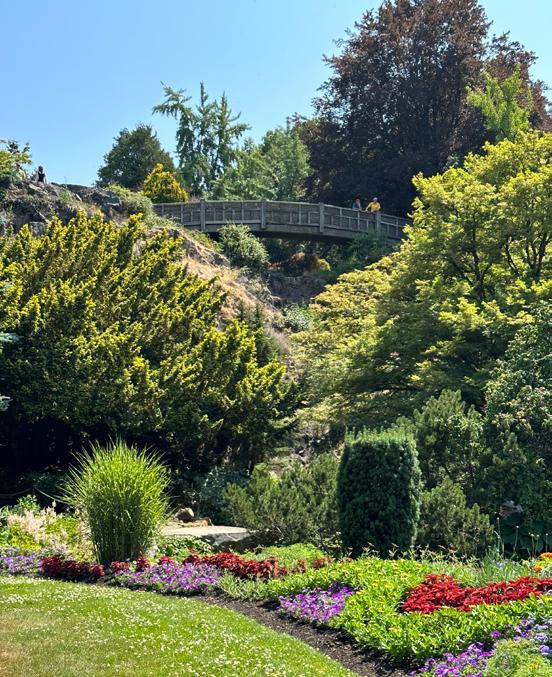

Parque de la Reina Isabel –Conservatorio Floral Bloedel
En este espacio ubicado dentro de un parque de 52.6 hectáreas en lo que anteriormente era una antigua cantera, se ubica en la parte más alta el Conservatorio Floral Bloedel, un invernadero y aviario construido en 1969 con una arquitectura que nos remite a la era espacial. En dicho espacio, puedes apreciar en su interior flora y fauna de zonas tropicales, que pueden resultarnos comunes pero son exóticas para la población vancouverense. Dentro de las flores que lucían en este espacio estaban las orquídeas (Orchidaceae), las bromelias (Bromeliaceae), las justicias y los anturios (Anthurium). Estos lugares nos revelaron la gran diversidad botánica local en esta parte de Canadá, por medio de sus texturas, colores y aromas. Los jardines no solo deslumbran con su belleza, sino también son centros de conocimiento y conservación que resaltan la importancia de proteger nuestra riqueza botánica y el planeta.
Queen Elizabeth ParkBloedel Floral Conservatory
Within a 52.6-hectare park situated on what once was an old quarry, you'll find the Bloedel Floral Conservatory located at the highest point, a greenhouse and aviary built in 1969 with architecture reminiscent of the space age. In this space, you can appreciate tropical flora and fauna, which may seem common to some but are exotic to the people of Vancouver. Among the flowers in this space were orchids (Orchidaceae), bromeliads (Bromeliaceae), justice flowers, and anthuriums (Anthurium). These places revealed to us the great local botanical diversity in this part of Canada, through its textures, colors and aromas. The gardens not only dazzle with their beauty, but are also centers of knowledge and conservation that highlight the importance of protecting our botanical wealth and the planet.

LAND-ESCAPE 87 86 LAND-ESCAPE
Jardines botánicos en la Columbia Británica
Perspectiva con jardinera en acceso y banca Perspective with planter at access and bench
Fotografía Photography: Armando Maravilla
Interior del edificio inspirado en la flor del loto del año 2001
Interior of the building inspired by the lotus flower of the year 2001
Fotografía Photography: Esaúl Hernández
Botanic gardens in British Columbia
Foto de detalle de Echinops y malvas
Detail photo of Echinops and hollyhocks
Fotografía / Photography: Armando Maravilla
Acceso con muestras de las plantas que se verán durante el recorrido
Access with samples of the plants that will be seen during the tour
Fotografía / Photography: Armando Maravilla
Angela Laws / Xerces
Por / By Landuum Paisaje

¿QUÉ EXPERIENCIA O PERSONA CREES QUE CONTRIBUYÓ AL AMOR Y LA DEDICACIÓN QUE SURGE EN TI RESPECTO A LA RESTAURACIÓN DEL HÁBITAT?
Cuando era pequeña, mis padres nos llevaban a acampar seguido a distintos lugares. Amaba pasar tiempo afuera, en busca de la vida salvaje y disfrutando la paz de estar en la naturaleza. Creo que mi amor por la naturaleza y mi compromiso con las cuestiones medioambientales nacieron en esos frecuentes viajes de camping.
Bióloga conservacionista de especies en peligro de extinción, con sede en Sacramento, CA. Angela trabaja en la restauración del hábitat de los polinizadores y las mariposas monarca en el Valle Central. Su papel en The Xerces Society también implica incorporar la resiliencia climática en proyectos de restauración de polinizadores. Tiene más de 20 años de experiencia estudiando artrópodos en hábitats de pastizales, incluidos estudios sobre cómo el cambio climático puede afectar las interacciones entre especies. Recibió un M.S. en Ecología de la Universidad Estatal de Utah y un Ph.D. en Biología de la Universidad de Notre Dame.
Endangered Species Conservation Biologist, based in Sacramento, CA. Angela is working on habitat restoration for pollinators and monarch butterflies in the Central Valley. Her role at The Xerces Society also involves incorporating climate resiliency into pollinator restoration projects. She has over 20 years of experience studying arthropods in grassland habitats, including studies of how climate change can affect species interactions. She received a M.S. in Ecology from Utah State University, and a Ph.D. in Biology from the University of Notre Dame.
WHAT EXPERIENCE OR PERSON DO YOU THINK CONTRIBUTED TO THE LOVE AND DEDICATION THAT ARISES IN YOU REGARDING HABITAT RESTORATION?
When I was young, my parents often took us camping in different places. I loved spending time outside, looking for wildlife and enjoying the peace of being in nature. I think my love for nature and my commitment to environmental issues was born on those frequent camping trips.
Como estudiante universitaria tuve la oportunidad de trabajar en un experimento de campo con saltamontes, y ¡quedé enganchada! Descubrí que me encantan los insectos y terminé pasando casi 20 años estudiando insectos y arañas en los pastizales de los Estados Unidos. Realmente disfruté mi tiempo como investigadora, pero quería hacer más trabajo práctico de conservación. Esto es lo que me llevó a mi trabajo actual en The Xerces Society hace casi 6 años.
As an undergraduate student I had the opportunity to work on a field experiment with grasshoppers, and I was hooked! I discovered that I love insects and ended up spending almost 20 years studying insects and spiders in grasslands around the United States. I really enjoyed my time as a researcher, but I wanted to do more hands-on conservation work. This is what led me to my current job with The Xerces Society almost 6 years ago.

¿CUÁL ES LA IMPORTANCIA DE DISEÑAR E IMPLEMENTAR JARDINES POLINIZADORES?
Los polinizadores son una parte importante en la mayoría de los ecosistemas. Más del 85% de las plantas con flores necesitan un polinizador, usualmente un insecto, para reproducirse. Por esto, los polinizadores son importantes para nuestra agricultura, salud, economía y para el medio ambiente. Muchos de los alimentos que comemos dependen de los insectos polinizadores.
WHAT
IS THE IMPORTANCE OF DESIGNING AND IMPLEMENTING POLLINATOR GARDENS?
Pollinators are an important part of most ecosystems. Over 85% of flowering plants require a pollinator, usually an insect, for reproduction. Because of this, pollinators are important to our agriculture, health, economy, and to the environment. So many of the foods we eat rely on insect pollinators.
89 INTERVIEW ENTREVISTA 88
Angela Laws
Angela Laws / Xerces
Fotografía / Photography: Eric Laws
Una mariposa monarca alimentándose de algodoncillo
A monarch feeding on milkweed
Fotografía / Photography: Eric Laws
Existen varios tipos de insectos polinizadores, incluyendo abejas, mariposas, polillas, avispas, escarabajos y moscas. De estos grupos, las abejas son las más eficientes. Recolectan polen para alimentar a sus crías y tienen pelos especiales u otras estructuras en sus cuerpos para transportar el polen. Además, son un grupo de animales muy diverso, con más de 20,000 especies en todo el mundo.
Muchos polinizadores, incluidas muchas especies de abejas y mariposas, han ido disminuyendo en los últimos años. Las amenazas comunes a los polinizadores incluyen la pérdida de hábitat, el uso de pesticidas, el cambio climático y las enfermedades que se propagan desde las colmenas de abejas gestionadas. La creación de un hábitat para polinizadores de alta calidad que esté protegido de los pesticidas puede ayudar a abordar dos de estas amenazas.
There are several types of insect pollinators, including bees, butterflies, moths, wasps, beetles, and flies. Of these groups, bees are the most efficient. They collect pollen to feed their young and have special hairs or other structures on their bodies to carry pollen. Bees are a very diverse group of animals, with over 20,000 species globally.
Many pollinators, including many species of bees and butterflies, have been declining in recent years. Common threats to pollinators include habitat loss, pesticide use, climate change, and diseases spreading from managed bee hives. Creating highquality pollinator habitat that is protected from pesticides can help address two of these threats.

¿QUÉ ACCIONES PODEMOS HACER PARA RESTAURAR UN HÁBITAT Y ATRAER POLINIZADORES?
Crear un hábitat para los polinizadores es una experiencia gratificante que se puede realizar en áreas grandes o pequeñas. Los aspectos más importantes del hábitat de los polinizadores son las flores, que proporcionan polen y néctar. Las plantas nativas tienden a sustentar más polinizadores que las especies ornamentales. Las mariposas necesitan plantas hospedantes, ya que son de las que se alimentan como orugas. Muchas mariposas son muy específicas acerca de las plantas hospedantes que utilizan. Por ejemplo, las mariposas monarca sólo utilizan algodoncillo.
WHAT ACTIONS CAN WE DO TO RESTORE A HABITAT AND ATTRACT POLLINATORS?
Creating pollinator habitat is a rewarding experience that can be done in large or small areas. The most important aspects of pollinator habitat are flowers, which provide pollen and nectar. Native plants tend to support more pollinators than ornamental plants. Butterflies need host plants, which are the plants the butterflies feed on as caterpillars. Many butterflies are very specific about the host plants that they use. For example, monarch butterflies only use milkweeds.
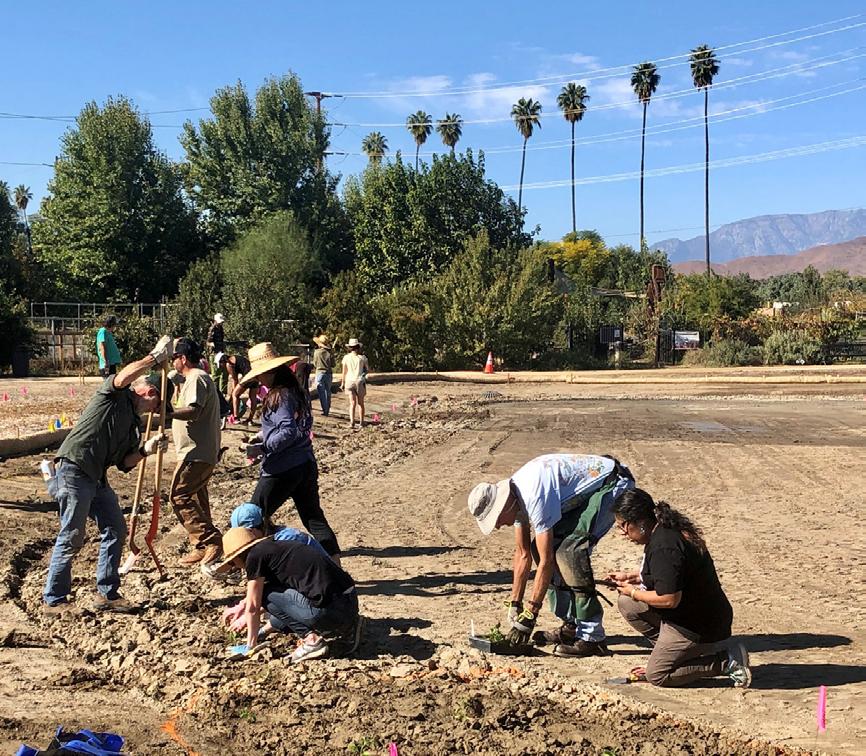
91 INTERVIEW ENTREVISTA 90 Angela Laws / Xerces
Angela Laws / Xerces
Abeja verde sudorosa A green sweat bee Fotografía / Photography: Sara Morris
Voluntarios plantando un hábitat para polinizadores Volunteers planting pollinator habitat
Fotografía / Photography: Diana Ruiz/Riverside Corona RCD
Cuando se diseña un hábitat para polinizadores, la diversidad es la clave. Ellos vienen en formas y tamaños distintos, así que usar una variedad de plantas y flores de diferentes colores, formas y tamaños ayudará a más especies de polinizadores que un hábitat con pocas especies. Intenta asegurarte de tener al menos tres especies diferentes floreciendo en todo momento cuando los polinizadores puedan estar activos. Asimismo, suelen responder bien cuando las flores se plantan en masa, en lugar de esparcidas.
Otro aspecto importante de crear un hábitat para polinizadores es asegurarnos de protegerlo de pesticidas. Muchos de los pesticidas disponibles son dañinos para las abejas y otras especies. The Xerces Society posee una guía para proteger el hábitat de los pesticidas.
When designing habitat for pollinators, diversity is key. Pollinators come in many shapes and sizes, so using a variety of plants with flowers of different colors, shapes and sizes will support more species of pollinators than a habitat with only a few species. Try to make sure you have at least three different species in bloom at all times when pollinators may be active. Pollinators also seem to respond well to flowers when they are planted in masses, rather than spread apart.
Another important aspect of creating a pollinator habitat is to make sure to protect it from pesticides. Many of the insecticides that are available are harmful to bees and other pollinators. The Xerces Society has guidance available for protecting habitat from pesticides.

“Los bordes de las carreteras representan una excelente oportunidad para agregar un hábitat de polinizadores al paisaje. Debido a la naturaleza lineal de las carreteras, son excelentes para aumentar la conectividad entre zonas de hábitat de alta calidad.”
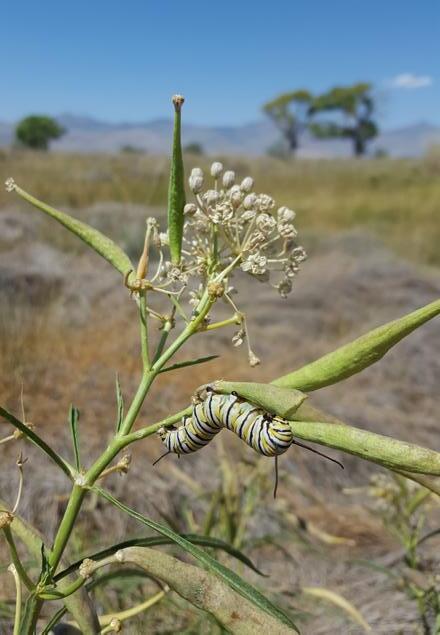
“Roadsides represent an excellent opportunity to add pollinator habitat to the landscape. Because of the linear nature of roads, roadside habitat is great for increasing connectivity between patches of high-quality habitat.”
EN TU EXPERIENCIA, ¿CUÁLES SON LOS BENEFICIOS DE PLANTAR ESPECIES NATIVAS EN LOS BORDES DE LAS CARRETERAS?
Los bordes de las carreteras representan una excelente oportunidad para agregar un hábitat de polinizadores al paisaje, especialmente en paisajes altamente desarrollados. Estos pueden proporcionar un buen hábitat para los polinizadores cuando contienen una variedad de plantas nativas que proporcionan alimento, sitios de anidación y lugares para pasar el invierno. En algunas áreas altamente desarrolladas o dominadas por la agricultura, los bordes de las carreteras pueden convertirse en uno de los únicos hábitats naturales disponibles para los polinizadores. Una ventaja adicional es que, debido a la naturaleza lineal de las carreteras, estas son excelentes para aumentar la conectividad entre zonas de hábitat de alta calidad.
La creación de un hábitat para los polinizadores a lo largo de las carreteras tiene muchos beneficios más allá de su conservación. Puede ayudar con el secuestro de carbono, el control de la erosión e incluso puede reducir la escorrentía, lo que puede ayudar a prevenir inundaciones.
IN YOUR EXPERIENCE, WHAT ARE THE BENEFITS OF PLANTING NATIVE SPECIES ON THE ROADSIDES?
Roadsides represent an excellent opportunity to add pollinator habitat to the landscape, especially in highly developed landscapes. Roadsides can provide a good habitat for pollinators when the habitat contains a variety of native plants that provide food, nesting sites, and places to overwinter. In some areas that are highly developed or dominated by agriculture, roadsides can become some of the only natural habitat available to pollinators. An additional advantage is that, because of the linear nature of roads, roadside habitat is great for increasing connectivity between patches of high-quality habitat. Creating a pollinator habitat along roadsides has many benefits beyond pollinator conservation. It can help with carbon sequestration, erosion control and can even reduce runoff, which can help prevent flooding.
93 INTERVIEW ENTREVISTA 92
Angela Laws / Xerces
Hábitat para polinizadores en los bordes de la carretera Roadside habitat for pollinators
Fotografía / Photography: Nancy Lee Adamson/The Xerces Society
Angela Laws / Xerces
Oruga monarca en algodoncillo Monarch caterpillar on milkweed
Fotografía / Photography: Stephanie McKnight/The Xerces Society
FYJA, Festival de Flores y Jardines
FYJA, Flower and Garden Festival
Por / By : Patricia Elías Calles

FYJA es el único festival de flores y jardines de su tipo que se realiza actualmente en México. Nuestro país tiene una larga tradición de fiestas florales y en el festival la celebramos. Este año el evento se llevará a cabo el 26, 27 y 28 de abril en Jardines del Campo Marte, Ciudad de México “Festival en Campo”, y el 25, 26, 27 y 28 de abril en Polanco “Polanco en Flores”. El tema principal de este año es “Jardín de Seres Asombrosos”.
FYJA is the only flower and garden festival of its kind currently taking place in Mexico. Our country has a long tradition of flower festivities and we celebrate it at the festival. This year the event will take place on April 26, 27 and 28 in Jardines del Campo Marte, Mexico City “Festival en Campo”, and on April 25, 26, 27 and 28 in Polanco “Polanco en Flores”. This year’s main theme is “Garden of Amazing Beings”.


Festival en Campo es la primera edición que se celebrará en los jardines del Campo Marte, donde habrá múltiples actividades relacionadas al diseño de paisaje, la jardinería, el diseño floral y la educación ambiental. Desde su primera edición, el Festival FYJA se enfoca en promover el valor del diseño de paisaje a partir de la rehabilitación de jardines y la creación de espacios que inviten a repensar y en este sentido, activar y dar nuevas formas a nuestra relación con la naturaleza. Los jardines serán una de las mayores atracciones y los visitantes podrán interactuar e inspirarse con proyectos innovadores de diseño de paisaje para sus propios proyectos de jardinería, aprender sobre tendencias actuales en diseño de paisaje y ver cómo se puede aprovechar el espacio en un contexto urbano.
“Festival en Campo” is the first edition to be held in the gardens of Campo Marte, where there will be multiple activities related to landscape design, gardening, floral design and environmental education.
Since its first edition, “FYJA” Festival focuses on promoting the value of landscape design from the rehabilitation of gardens and the creation of spaces that invite us to rethink and in this sense, activate and give new forms to our relationship with nature. The gardens will be one of the biggest attractions and visitors will be able to interact and be inspired by innovative design projects of landscape for their own gardening projects, learn about current trends in landscape design and see how to take advantage of space in an urban context.
TRENDS 95 TENDENCIAS 94
Pabellón Botánico FYJA Óvulo FYJA Ovum Botanical Pavilion
Fotografía / Photography Christian Salvatierra
FYJA, Flower and Garden Festival
Festival FYJA 2017 Jardín Botánico
FYJA
Festival 2017 Botanical Garden
FYJA
2018
Fotografía
Fotografía / Photography Rafael Gamo, Jaime Navarro Festival FYJA
2018
Jardín Botánico
Festival
Botanical Garden
Photography Christian Salvatierra
Esta nueva edición busca promover un diseño de paisaje y una forma de hacer jardinería consciente de nuestro medio ambiente, buscando embellecer los espacios pero cuidando de la diversidad y la salud de los ecosistemas locales. Los jardines en el festival, creados por distintos paisajistas mexicanos, se centrarán en prácticas sostenibles, como el uso de plantas nativas, sistemas de recolección de agua de lluvia y técnicas de jardinería que promueven la biodiversidad y ayudan a hacer frente al cambio climático.
This new edition seeks to promote a landscape design and a way of gardening conscious of our environment, seeking to beautify the spaces while taking care of the diversity and health of local ecosystems. The gardens at the festival, created by different mexican landscapers, will focus on sustainable practices, such as the use of native plants, collection systems of rainwater, and gardening techniques that promote biodiversity and help address climate change.

“A través de los diversos jardines, pláticas y talleres, los visitantes podrán aprender sobre prácticas sostenibles, tanto para la jardinería como para el diseño floral.”
A través de los diversos jardines, pláticas y talleres, los visitantes podrán aprender sobre estas prácticas sostenibles, tanto para la jardinería como para el diseño floral. También podrán conocer cómo los jardines pueden adaptarse al cambio climático mediante la elección de plantas y el diseño de paisaje, y cómo cuidar plantas de interior. Asimismo, conocerán proyectos de compostaje y la maravilla de los hongos, entre otros temas.
Through the various gardens, talks and workshops, visitors will be able to learn about these sustainable practices, both for gardening and floral design. They will also be able to learn how the gardens can adapt to climate change through plant choice and landscape design, and how to care for indoor plants. Likewise, they will learn about composting projects and the wonder of mushrooms, among other topics.

“Through the various gardens, talks and workshops, visitors will be able to learn about sustainable practices, both for gardening and floral design.”
TRENDS 97 TENDENCIAS 96
FYJA, Festival de Flores y Jardines
Detalle en Festival FYJA 2018
Detail in FYJA Festival 2018
Fotografìa / Photography: Christian Salvatierra
FYJA, Flower and Garden Festival
Vista general del Festival FYJA 2018
General view in FYJA Festival 2018
Fotografìa / Photography: Christian Salvatierra
Patricia Elías Calles, fundadora, directora y responsable del maravilloso evento nos platica:
“Siempre he tenido contacto con los jardines y las flores. Mi madre es miembro del Círculo de la Flor y, desde que yo era niña, nos llevaba a las exposiciones de su club y de la Federación Mexicana de Jardinería y Arreglo Floral. También le debo el amor por los jardines, las flores y las plantas a mi abuela paterna, Elena Álvarez Morphy, quien en los años 50 se convirtió en una paisajista autodidacta y eventualmente, se fue a estudiar un curso de paisajismo en Los Ángeles, California. Dedicó el resto de su vida a hacer jardines. Trabajó en obras particulares, hoteles y espacios públicos en la Ciudad de México y Cuernavaca.
Además de mi madre y abuela, en 2011 tuve la oportunidad de asistir al Chelsea Flower Show en Londres. Aunque en aquel momento no me dedicaba a nada relacionado con las flores y la jardinería, esta experiencia cambió mi destino profesional. Fue a partir de esta visita que decidí organizar un festival así, de flores y jardines en México.”
Patricia Elías Calles, founder, director and responsible of the wonderful event tells us:
“I have always had contact with gardens and flowers. My mother is a member of Circle of the flower and, since I was a child, she took us to the exhibitions of her club and the Mexican Federation of Gardening and Floral Arrangement. I also owe the love for gardens, flowers and plants to my paternal grandmother, Elena Álvarez Morphy, who in the 1950s became a self-taught landscaper and eventually, she went to study a landscaping course in Los Angeles, California. She dedicated the rest of her life to gardening and worked on private projects, hotels and public spaces in Mexico City and Cuernavaca.
Besides my mother and grandmother, in 2011 I had the opportunity to attend to the Chelsea Flower Show in London. Although at that time I was not dedicated to anything related to flowers and gardening, this experience changed my professional destiny. It was from this visit that I decided to organize a festival like this, of flowers and gardens in Mexico.”


Exposición Arcos Florales en Parque América Floral arcs exposition in Parque América Fotografìa Photography: Christian Salvatierra
Uno de los principales objetivos que le gustaría lograr a la fundadora del FYJA, es que los visitantes aprendan que las flores, las plantas y los jardines son indispensables para la vida. Hay que crear, conservar y cuidar jardines por todos los beneficios que aportan. Desde el bienestar físico y mental de las personas hasta la conservación de todos los seres vivos que forman, viven y benefician a un jardín, sin importar su tamaño. Estos seres son claves para el equilibrio ecológico y nuestra supervivencia.
One of the main objectives that the founder of FYJA would like to achieve, is for visitors to learn that flowers, plants and gardens are essential for life. Gardens must be created, conserved and cared for due to all the benefits they bring. From the physical and mental well-being of people to the conservation of all living beings that form, live and benefit a garden, regardless of its size. These beings are key to ecological balance and our survival.
TRENDS 99 TENDENCIAS 98
FYJA, Festival de Flores y Jardines
Pabellón Botánico Núcleo Core Botanical Pavilion Fotografía / Photography Luis Young
FYJA, Flower and Garden Festival
Paseos de las Flores, una fusión de cultura y naturaleza
Flower Paths, a fusion of culture and nature
Por / By Luis Jorge Montalvo y Andrea Conde Correa
En la actualidad, encontramos diferentes tipos de expresiones artísticas que se relacionan con la naturaleza y que forman parte de la identidad de cada comunidad. Un ejemplo de esto son los Paseos de las Flores, que han tenido gran presencia en diversos espacios públicos en la Península de Yucatán desde el 2016, específicamente en Mérida, Umán, Valladolid e Izamal.
Estas intervenciones son una expresión cultural ancestral mexicana denominada alfombrismo, la cual tiene sus orígenes en Huamantla, Tlaxcala, pero se ha expandido a diferentes estados de la República Méxicana.
Currently, we find different types of artistic expressions related to nature and that are part of the identity of each community. An example of this are the “Paseos de las Flores” (Flower Paths), which have had a significant presence in various public spaces on the Yucatán Peninsula since 2016, specifically in Mérida, Umán, Valladolid, and Izamal. These interventions are an ancestral Mexican cultural expression called “alfombrismo”, which has its origins in Huamantla, Tlaxcala, but has expanded to different states in the Mexican Republic.


Estas manifestaciones de arte efímero constan de un tapete monumental acompañado de esculturas que en conjunto buscan transmitir un mensaje específico, así como también generar un ambiente colectivo de convivencia, intercambio, diálogo y apropiación cultural.
Existen diferentes técnicas a utilizar: se pueden hacer con aserrín pintado, flores cortadas, semillas, pétalos y plantas vivas.
La idea de llevar a cabo estas exhibiciones en la península surge de los tapetes florales que se realizaban en Atlixco, Puebla; Sin embargo, estos dejaron de elaborarse en 2020, por lo que actualmente los múltiples Paseos de las Flores hechos con planta viva en Yucatán son los únicos de este tipo en el país.
These manifestations of ephemeral art consist of a monumental carpet accompanied by sculptures that together seek to convey a specific message as well as generate a collective atmosphere of coexistence, exchange, dialogue, and cultural appropriation. There are different techniques that can be used: they can be made with painted sawdust, cut flowers, seeds, petals, and live plants. The idea of carrying out these exhibitions in the peninsula comes from the floral carpets that were made in Atlixco, Puebla; However, these ceased to be produced in 2020, so currently, the multiple Flower Paths made with live plants in Yucatán are the only ones of this kind in the country.
TRENDS 101 TENDENCIAS 100
Paseo Navideño de las Flores en Umán Christmas Flower Path in Umán Fotografìa / Photography: Gobierno del Estado
Escultura de perro xoloitzcuintle entre flores
Xoloitzcuintle dog sculpture between flowers
Fotografìa Photography: Adriana Beatriz Correa González
fusion of culture and nature
Flower Paths, a
Para realizar estas exhibiciones se usan más de 30 mil flores de diferentes tipos, como el cempasúchil (Tagetes erecta), la petunia (Petunia), el panalillo (Lithospermum distichum), agerato (Ageratum houstonianum), kalanchoe (Kalanchoe) y carissa (Carissa), todas las anteriores en diferentes colores de flor. Es importante seleccionar especies que sean resistentes al caluroso clima de la región y cabe mencionar que una vez finalizado el tiempo de exposición, las flores se regalan a las personas que se encuentren presentes.

En noviembre del 2023, la ciudad de Mérida albergó el Camino de las Flores conmemorativo al Día de los Muertos, se situó en el Pasaje Revolución a un costado de la Catedral. En esa ocasión pudimos observar estatuas de animas hechas con flores, así como catrinas y una representación del traspatio o solar maya, utilizando flores alusivas a la época y plantaciones de elote.
En el mes de diciembre se realizó una intervención en el nuevo parque de La Plancha, donde observamos esculturas navideñas de diversos personajes hechas con diferentes plantas y flores como la típica noche buena (Euphorbia pulcherrima ).
To create these exhibitions, more than 30 thousand flowers of different types are used, such as the marigold (Tagetes erecta), petunia (Petunia), lithospermum (Lithospermum distichum), ageratum (Ageratum houstonianum), kalanchoe (Kalanchoe), and carissa (Carissa), all in various flower colors. It is important to choose species that are resistant to the hot climate of the region and it's worth mentioning that once the exposition time it's over, the flowers are given to the people who are present.
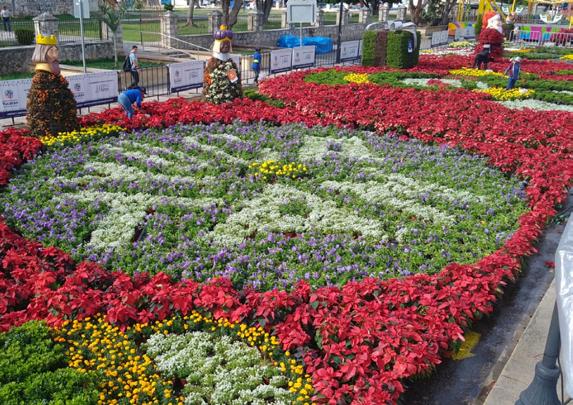
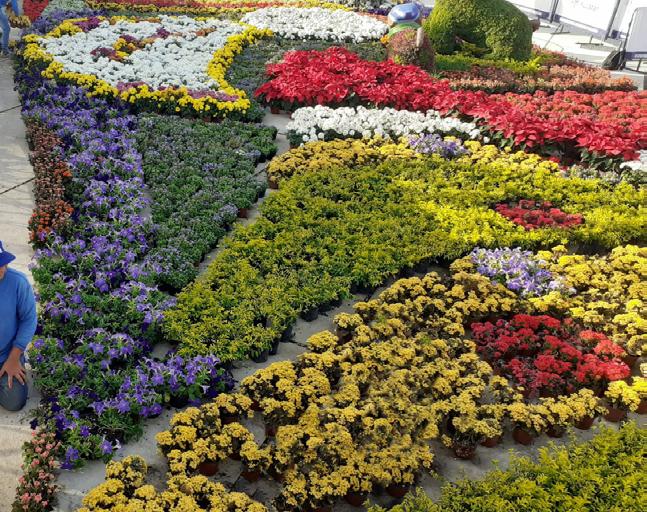
In November 2023, the city of Mérida hosted the commemorative Flower Path for the Day of the Dead. It was located in Pasaje Revolución, next to the Cathedral. On that occasion, we could observe statues of “animas” made with flowers, as well as “catrinas” and a representation of the mayan backyard or courtyard, using season-themed flowers and corn plantations.
In December, an intervention took place in the new La Plancha park, where we observed Christmas sculptures of various characters made with different plants and flowers, such as the typical poinsettia (Euphorbia pulcherrima).

La presencia de flores y vegetación en entornos urbanos no solo embellece la ciudad, sino que también ha demostrado tener efectos positivos en la salud mental y emocional de las personas. Además, al actuar como puntos de encuentro, fomentan la interacción social, creando espacios agradables donde la comunidad puede reunirse, socializar y disfrutar de la serenidad que ofrece la naturaleza en medio del bullicio citadino. En definitiva, estos no solo contribuyen a la estética urbana, sino que también promueven la formación de comunidades más saludables y conectadas.
The presence of flowers and vegetation in urban environments not only embellishes the city but has also been shown to have positive effects on people's mental and emotional health. Additionally, by serving as meeting points, they encourage social interaction, creating pleasant spaces where the community can gather, socialize, and enjoy the serenity offered by nature amidst the city bustle. In essence, they not only contribute to urban aesthetics but also promote the formation of healthier and more connected communities.
TRENDS 103 TENDENCIAS 102
Paleta floral en el Paseo de las Flores del Día de los Muertos Floral palette in the Flower Path of the Day of Dead Fotografìa / Photography: Andrea Conde Correa
Paseos de las Flores, una fusión de cultura y naturaleza
Paseo Navideño de las Flores en Umán Christmas Flower Path in Umán Fotografìa / Photography: Gobierno del Estado
Flower Paths, a fusion of culture and nature
Paseo Navideño de las Flores en parque La Plancha
Christmas Flower Path in La Plancha park
Fotografía / Photography Andrea Conde Correa
Paleta floral en el parque de La Plancha
Floral palette in La Plancha park
Fotografía / Photography Jennifer Miranda
Para concluir, los Paseos de las Flores representan una serie de valores socioculturales que se expresan a través de la naturaleza y los arreglos florales en espacios públicos destinados a comunidades específicas. Estos lugares ejercen un impacto significativo en el bienestar urbano y en la calidad de vida de los habitantes.
In conclusion, the Flower Paths represent a series of socio-cultural values expressed through nature and floral arrangements in public spaces designated for specific communities. These places have a significant impact on urban well-being and the residents quality of life.

“Los Paseos de Flores representan valores socioculturales que se expresan a través de la naturaleza, ejerciendo un impacto significativo en el bienestar urbano y en la calidad de vida.”
“The Flower Paths represent socio-cultural values expressed through nature, exerting a significant impact on urban well-being and quality of life.”
PAISAJISMO Y ARQUITECTURA
LANDSCAPE & ARCHITECTURE
ALIVE ARCHITECTURE
T: 32 484 47 72 68
M: info@alivearchitecture.eu
IG: @alivearchitecture
FB: @AliveArchitecture www.alivearchitecture.eu/
ARMANDO MARAVILLA
M: amaravilla@yaax.com.mx
IG: @armando_maravilla_ / @plant_ encyclopedia /@wonder_m_r
FB: @armandomaravilla
TT: @arm_maravilla / @wonder_m_r
ATELIER LOOS VAN VLIET
T: 0031 023 5310007
M: atelier@loosvanvliet.nl
IG: @loosvanvliet
FB: @LOOSvanVLIET www.loosvanvliet.nl/
CASANOVA + HERNÁNDEZ
ARQUITECTOS
T: 31634264559
M: contact@casanova-hernandez.com www.casanova-hernandez.com
COHABITA
Arq. Luisi Leyva
T: 52 999 406 3268
M: contacto@cohabita.mx
IG: @cohabita.mx www.cohabita.mx
IVÁN JUÁREZ
T: 48 794291694
M: ivan@x-studio.tv
IG: @x.studio.ivan.juarez
FB: @xstudio : ivan juarez www.x-studio.tv/
LELEU PAISAJE
T: 55 40 34 27 85
M: celine@leleupaisaje.com
IG: @leleu.paisaje
PARAISO COLIBRÍ
T: 52 222 190 3963
M: floresparacolibries@gmail.com
IG: @paraiso_colibri
FB: @Paraisocolibrí www.paraisocolibri.org/
STEPHANIE LAGUNAS
M: sandmar.12lag@gmail.com
IG: @heartnie
FB: @phanielagunas www.behance.net/stephanielagunas
STROOTMAN
LANDSCHAPSARCHITECTEN
T: 31(0) 20 419 41 69
M: bureau@strootman.net
IG: @strootmanlandschap @StrootmanLandschapsarchitecten www.strootman.net
THE XERCES SOCIETY
T: 1 855 232 6639
M: communications@xerces.org
IG: @xercessociety
FB: @xercessociety www.xerces.org
ÜERTO CULTIVA
T: 9999 60 16 60 / 9992 66 19 27
M: uertocultiva@gmail.com
IG: @Uerto Cultiva
FB: @Uerto Cultiva
FLORERIA FLOWER SHOP
THE FLOWNER
T: 999 419 4469
M: contactoflowner@gmail.com
IG: @theflowner
FB: @TheFlowner www.theflowner.com/
OTROS OTHERS
I FLA
T: 32497630550
M: admin@iflaworld.org
IG: @iflaworld
FB: @IFLAWorld
TT: @IntFedLandArch www.iflaworld.org
SOCIEDAD DE ARQUITECTOS
PAISAJISTAS DE MÉXICO
T: 55 55 53 69 10
M: contacto@sapm.com.mx
FB: SAPM, Sociedad de Arquitectos Paisajistas de México A.C. www.sapm.com.mx



www.landuum.com
105 TENDENCIAS 104
Catrina en el Paseo de las Flores del Día de los Muertos
Catrina in the Flower Path of the Day of the Dead
Fotografìa / Photography: Adriana Beatriz
Paseos de las Flores, una fusión de cultura y naturaleza Puntos de venta Revista Landuum versión
Point of sale Landuum magazine
version DIRECTORIO / DIRECTORY
por
Endorsed by:
Correa González
impresa
print
Avalado
/


Paisajes Inteligentes Smart Landscapes Verano 2024 / Summer 2024 ¡Suscríbete! / Subscribe! suscripciones@landuum.com www.landuum.com










































































































































